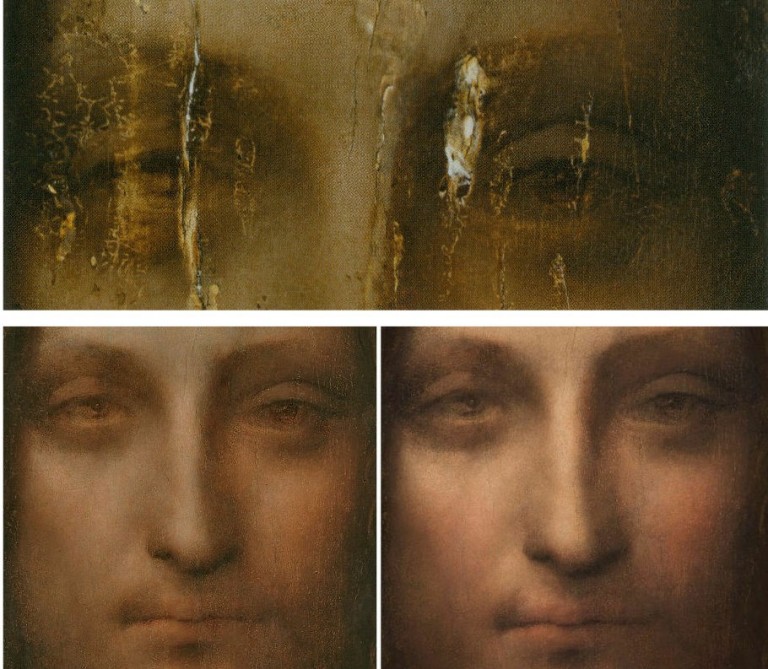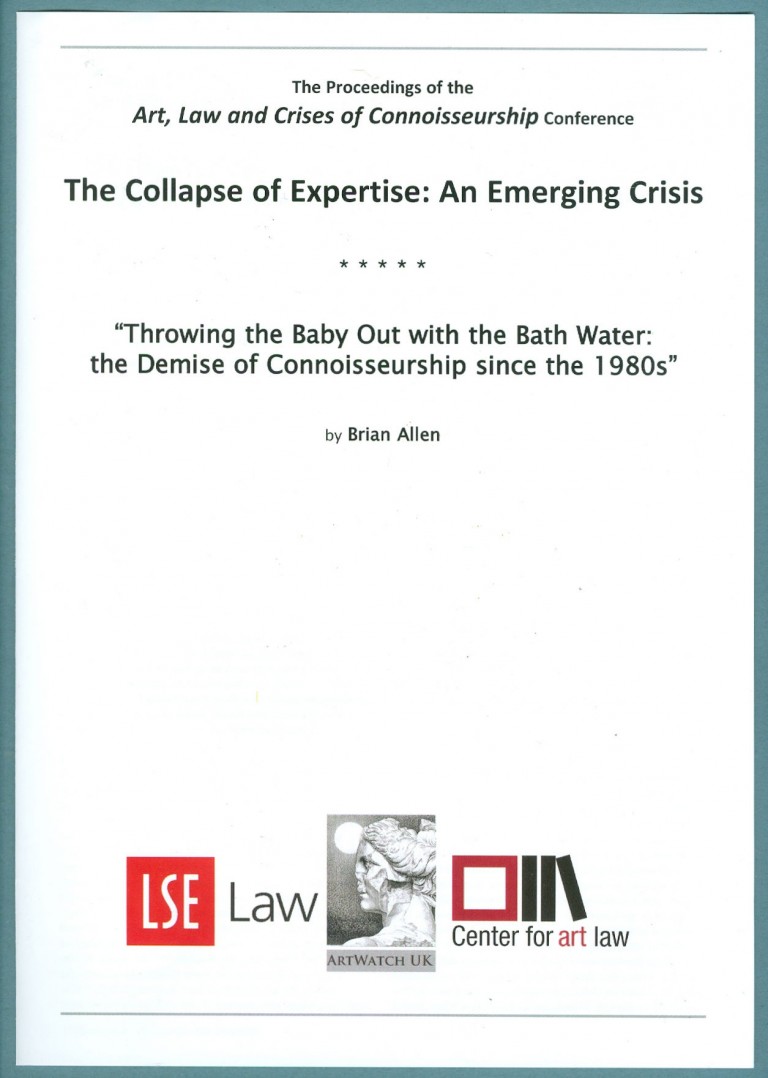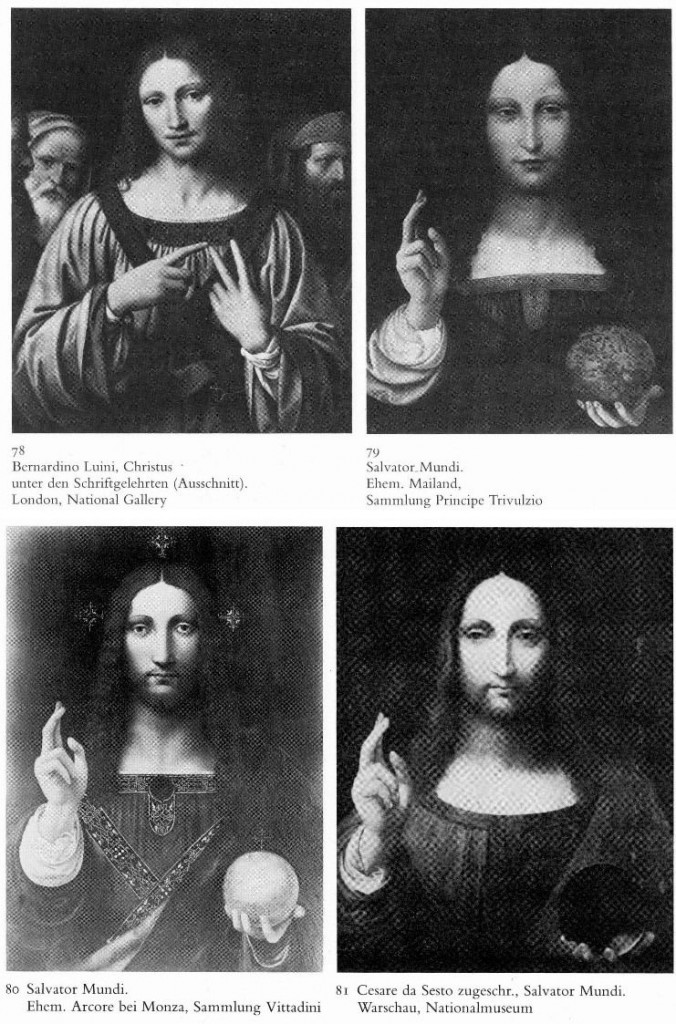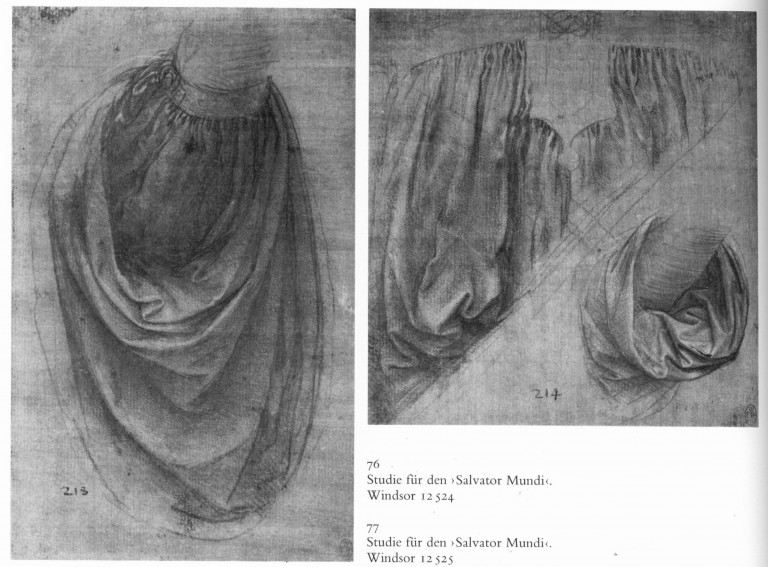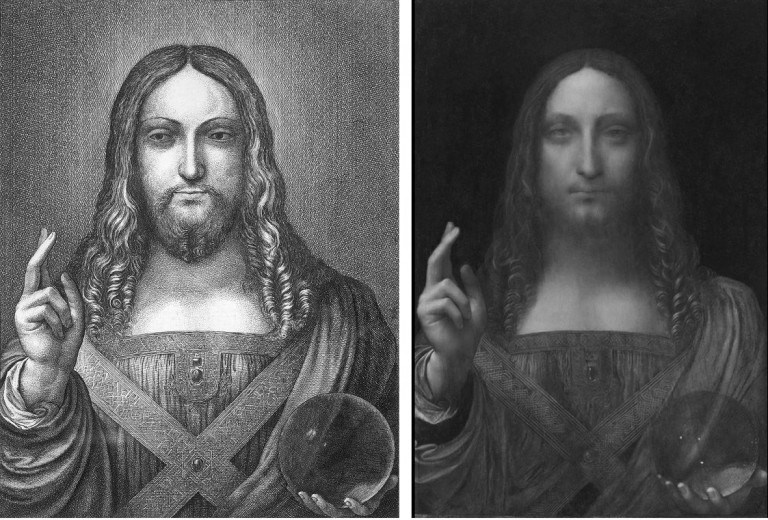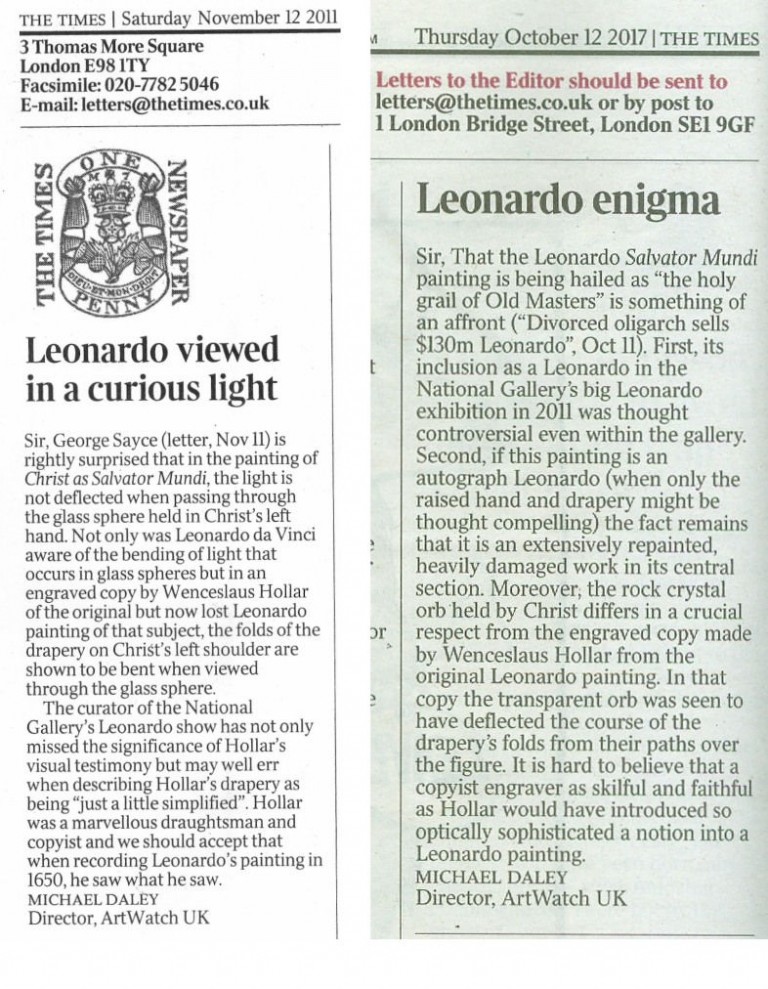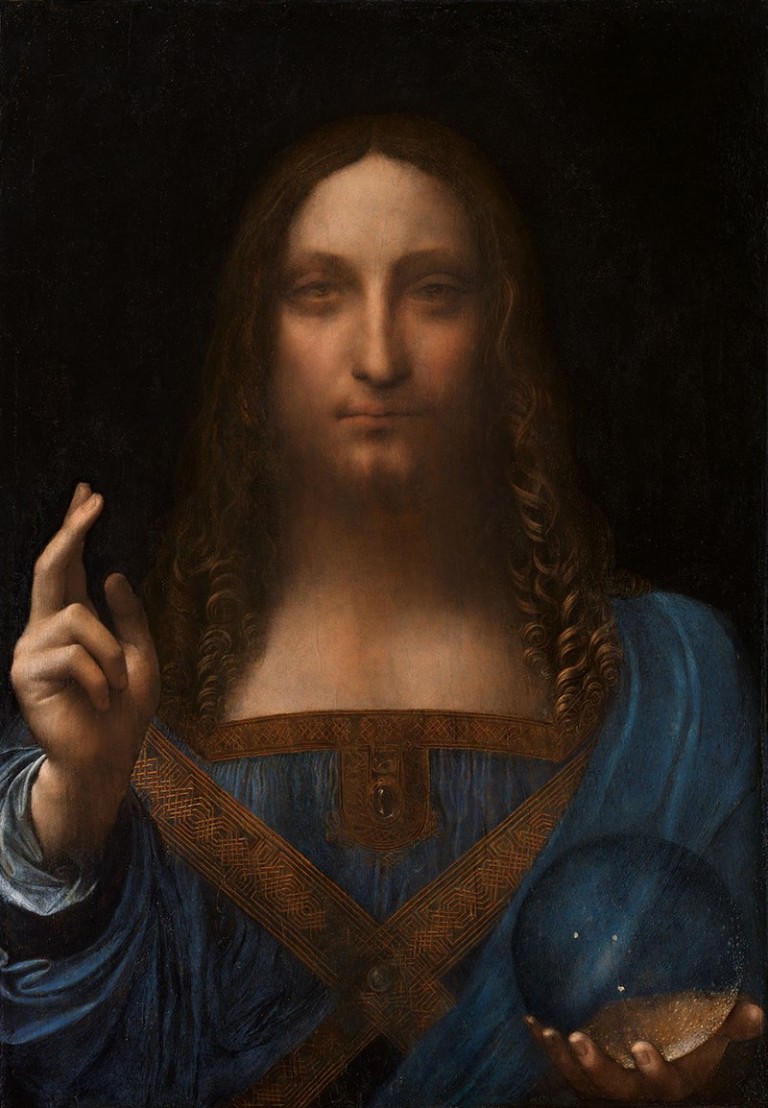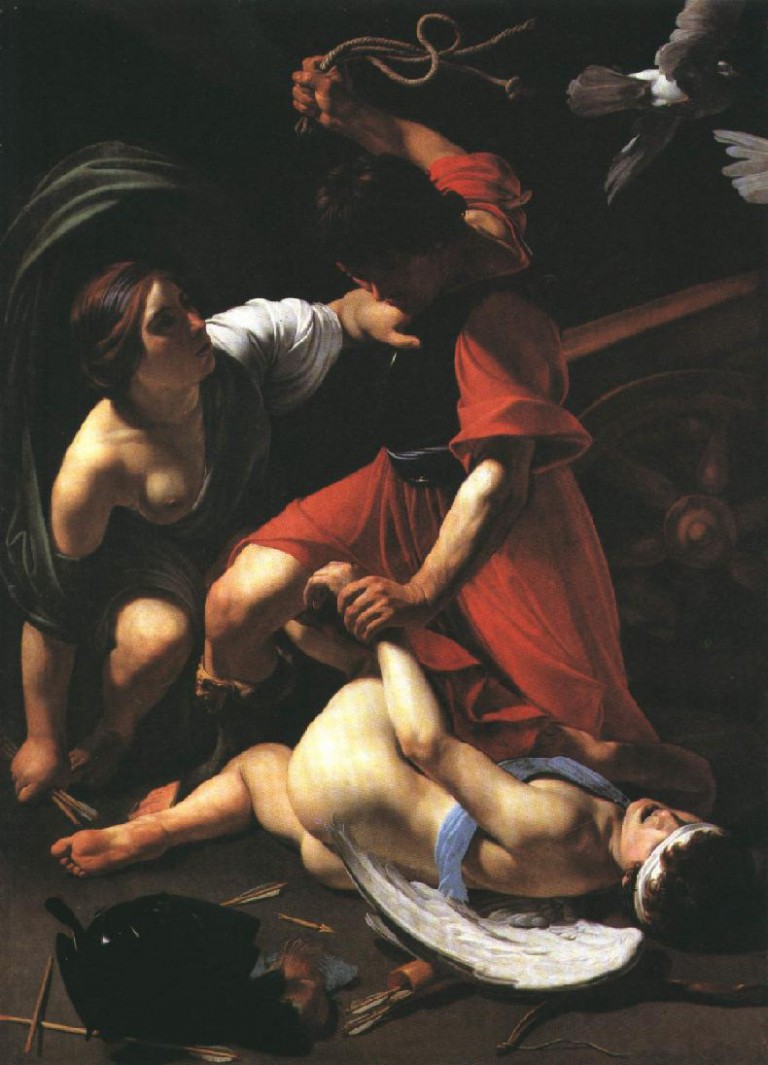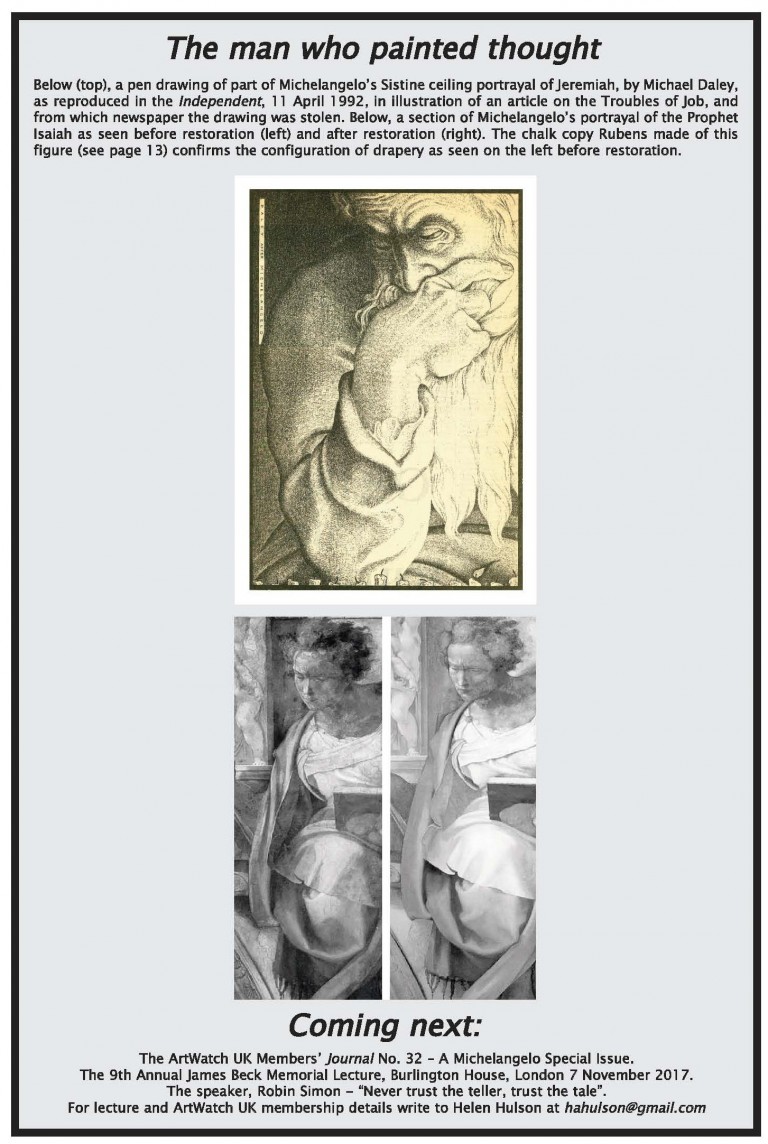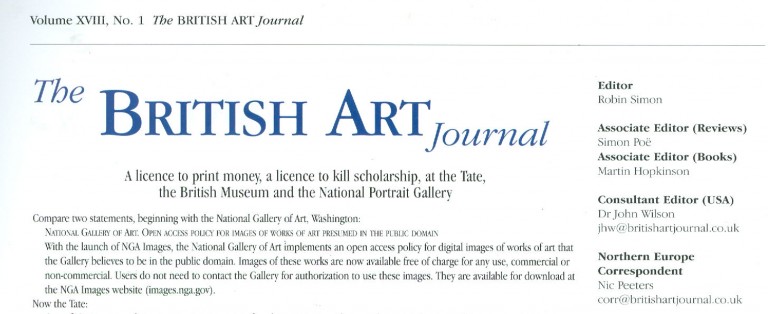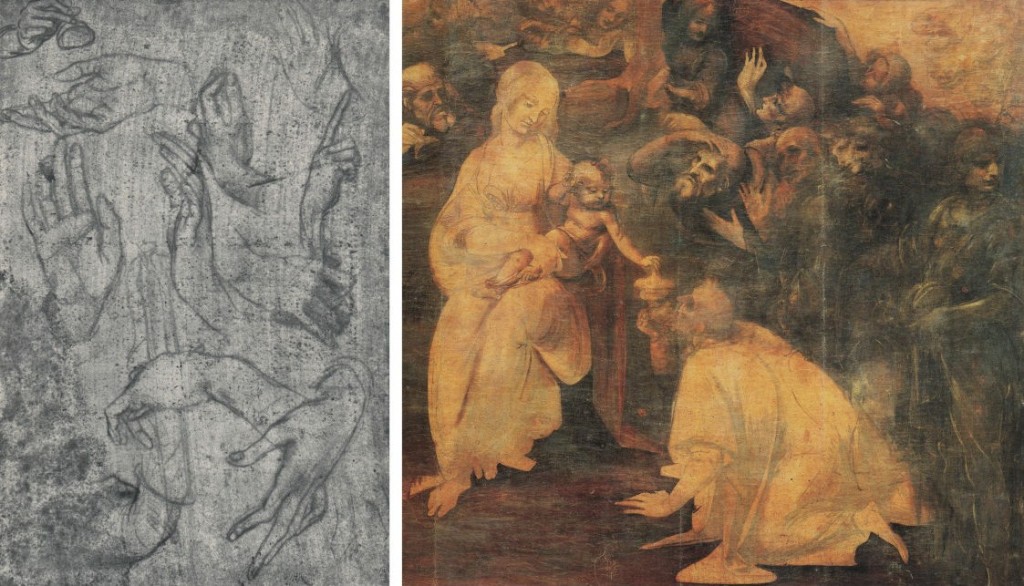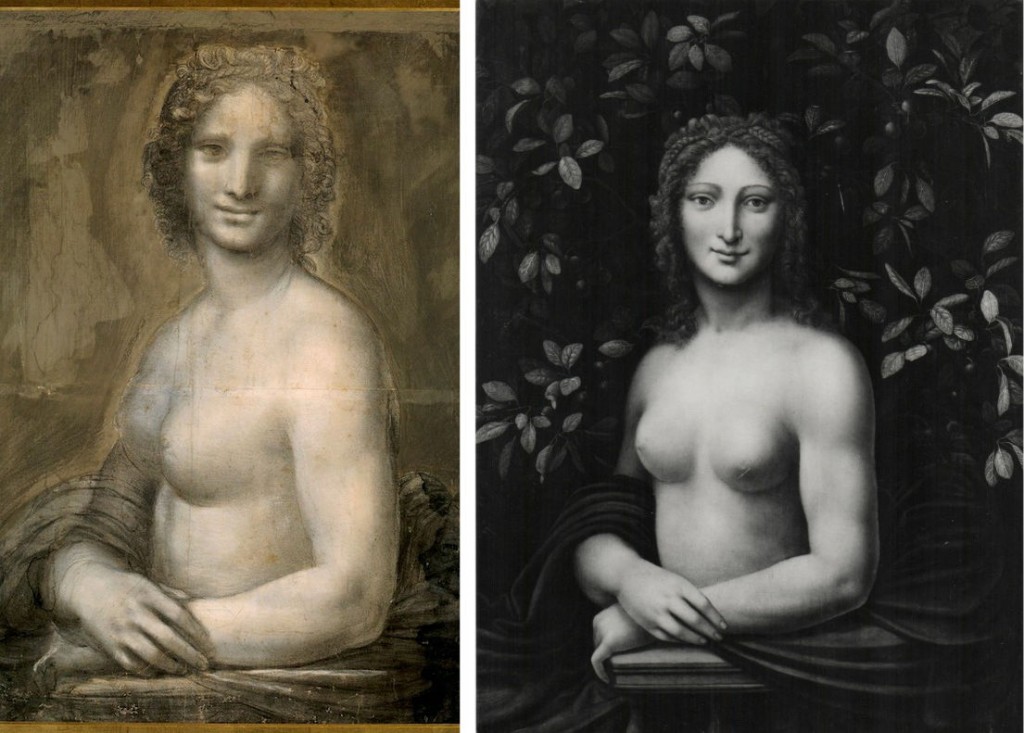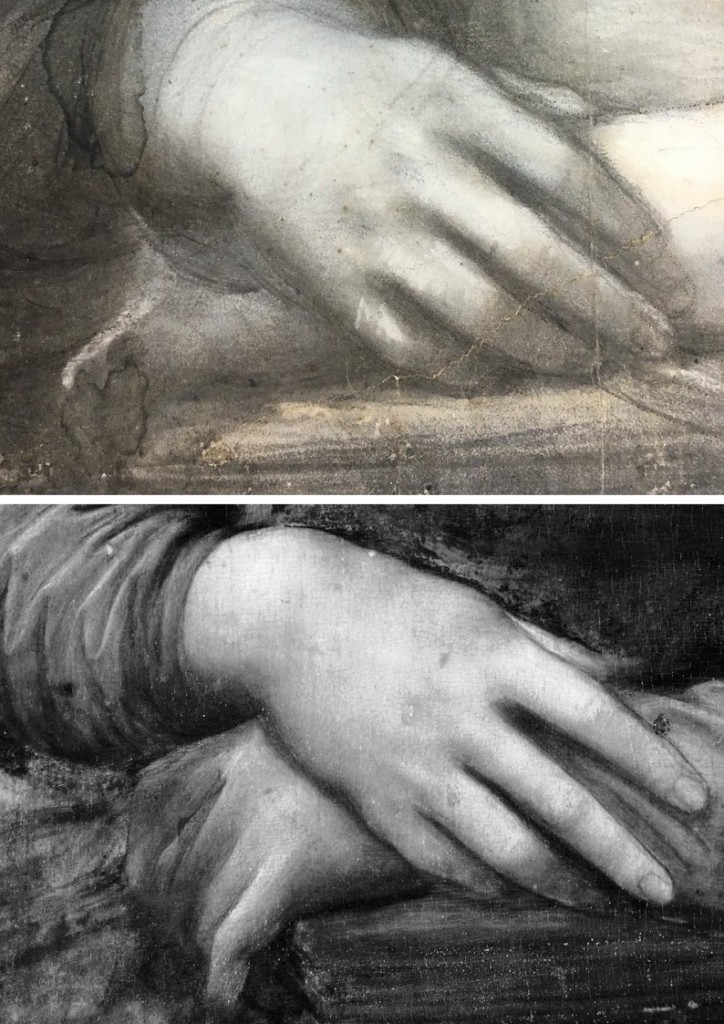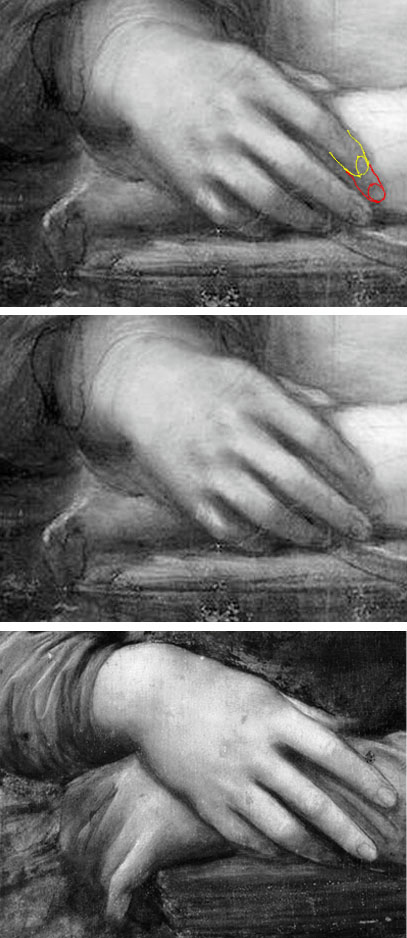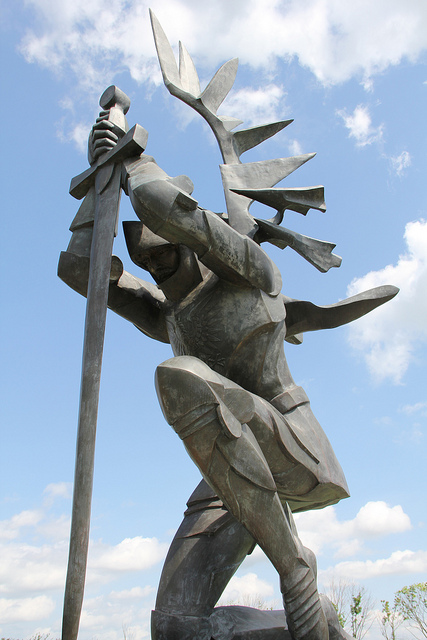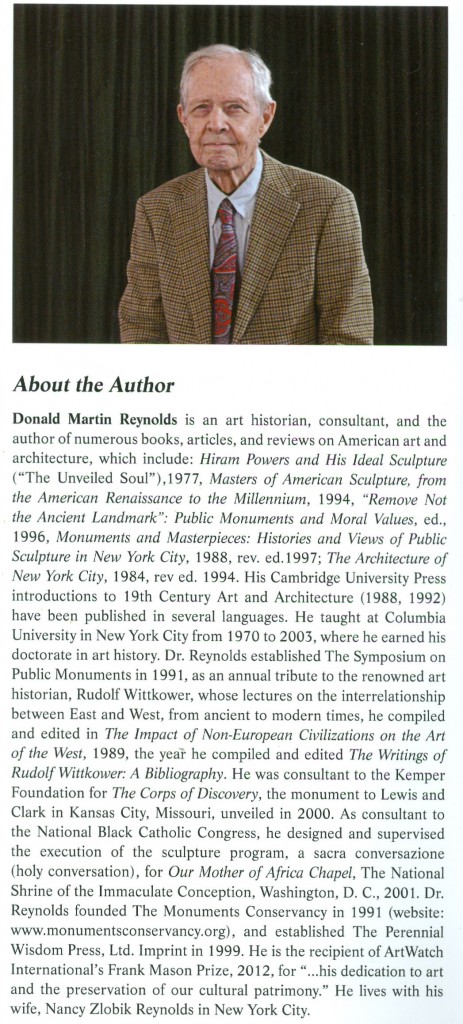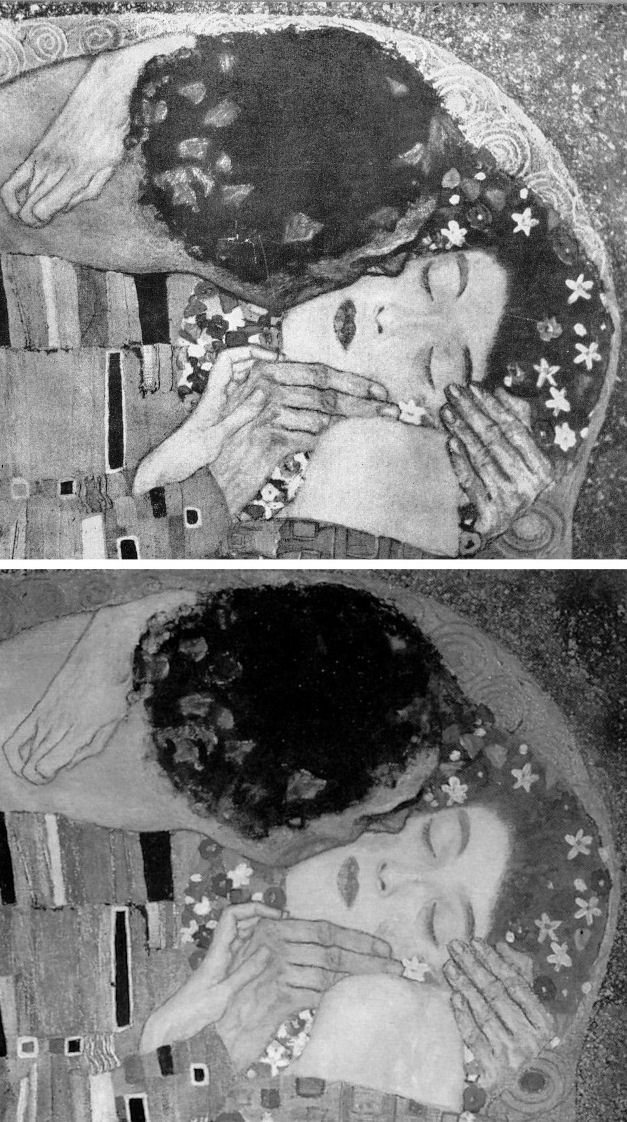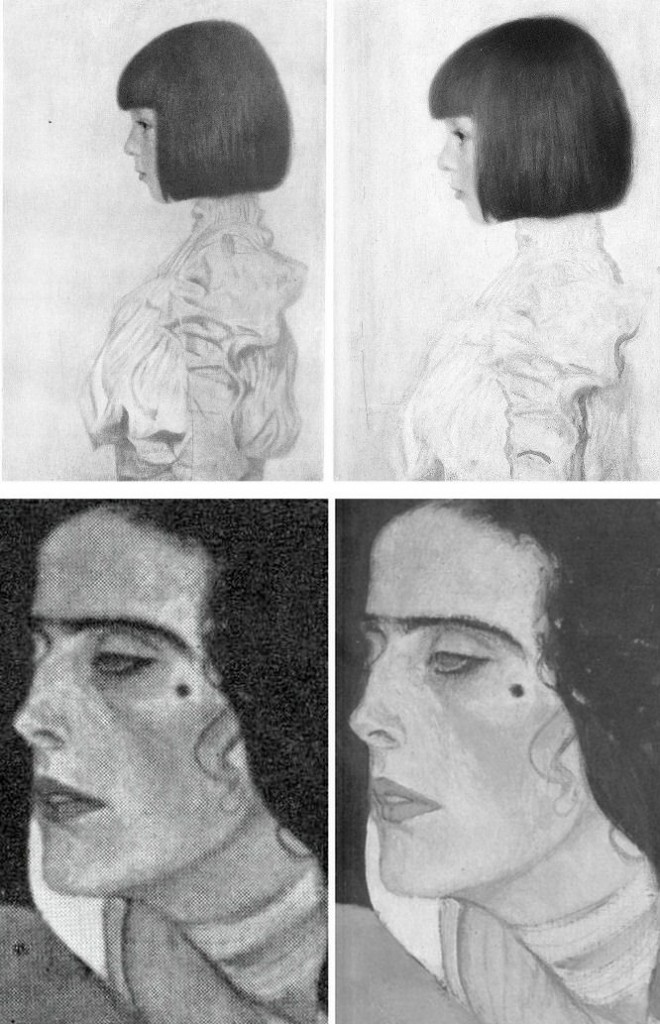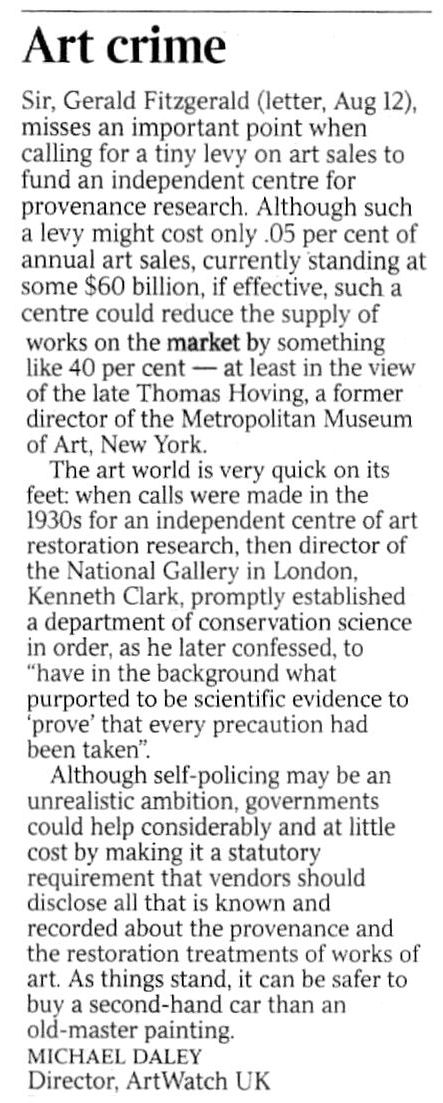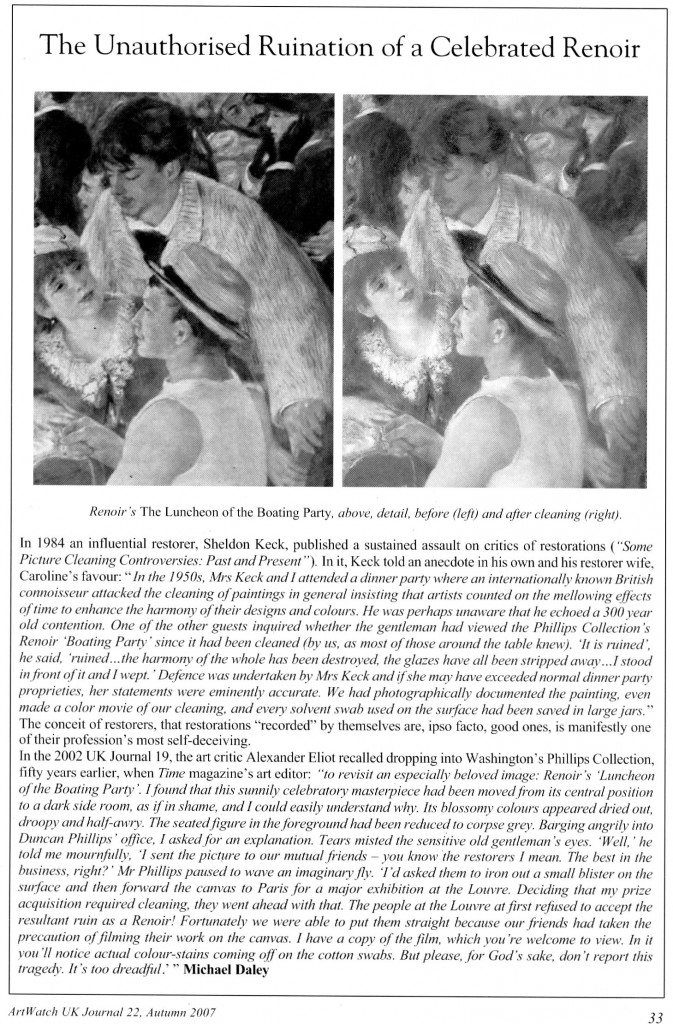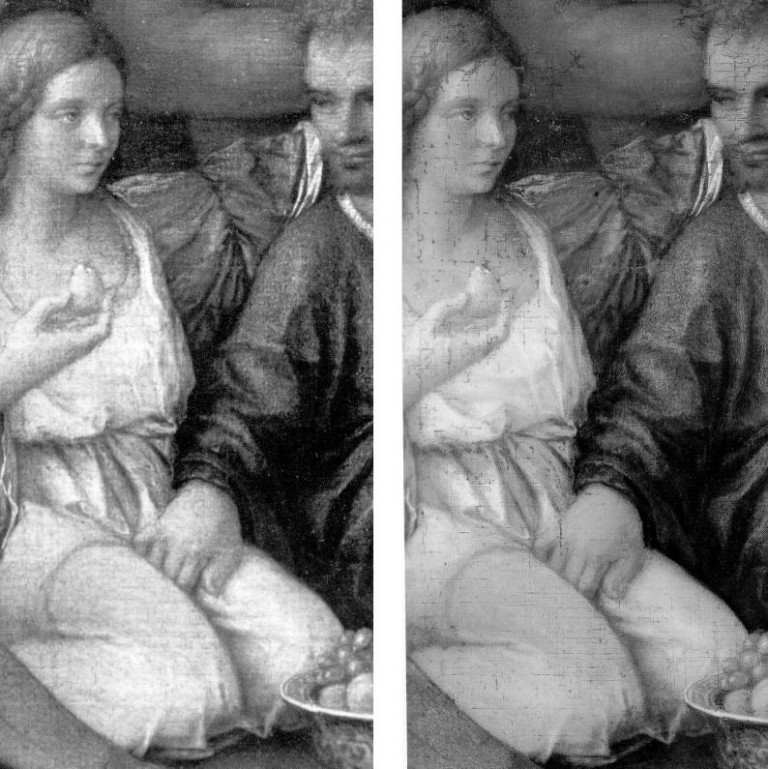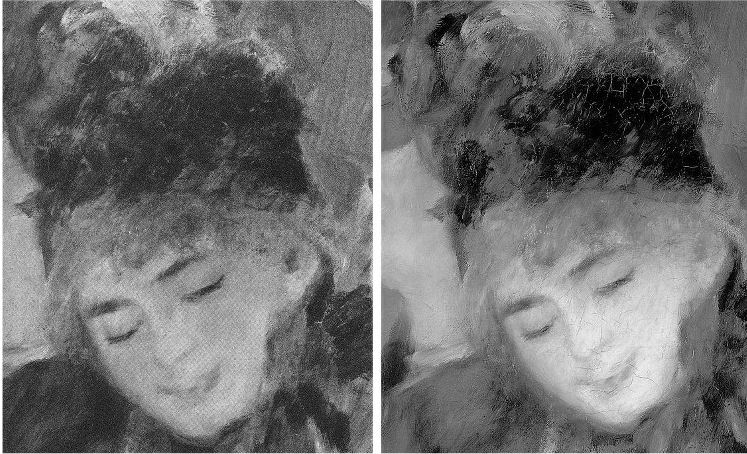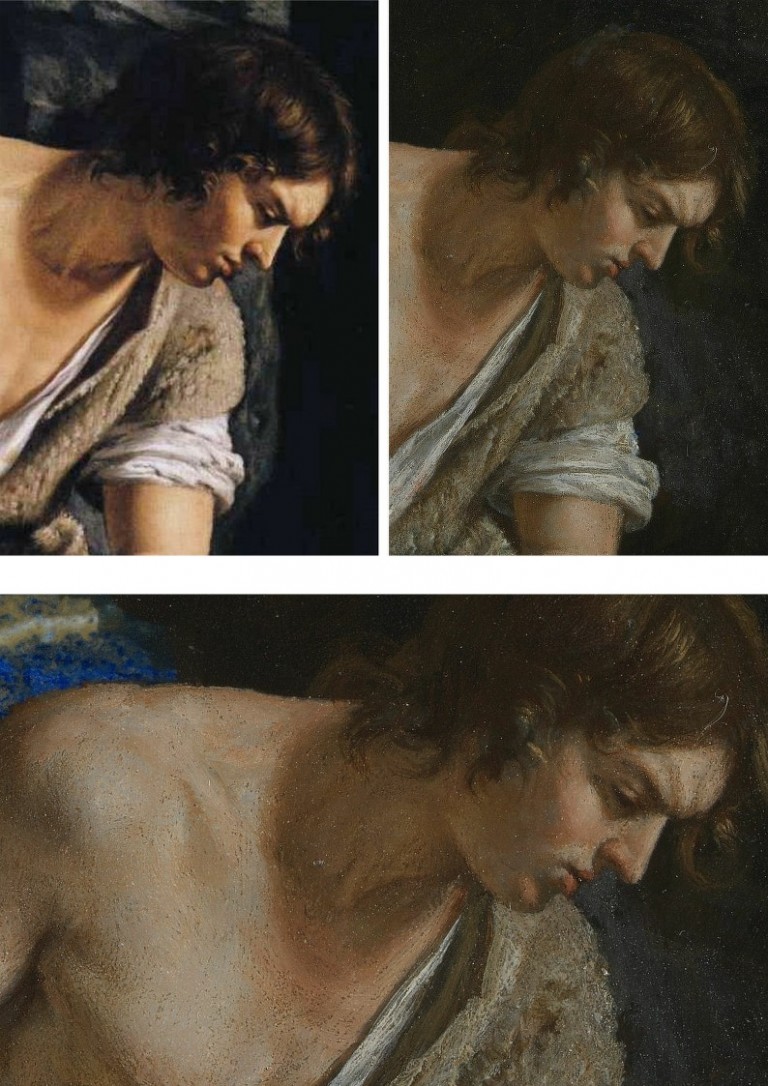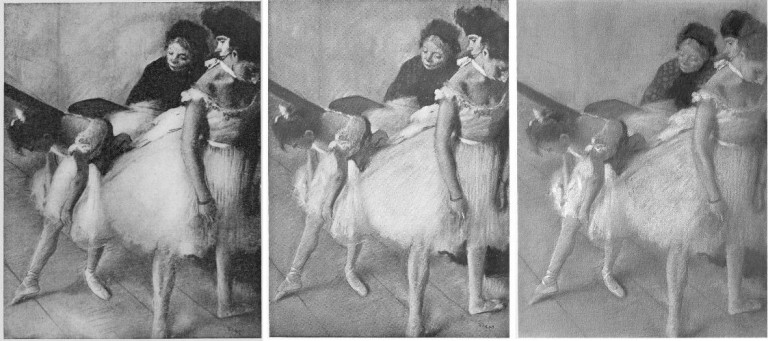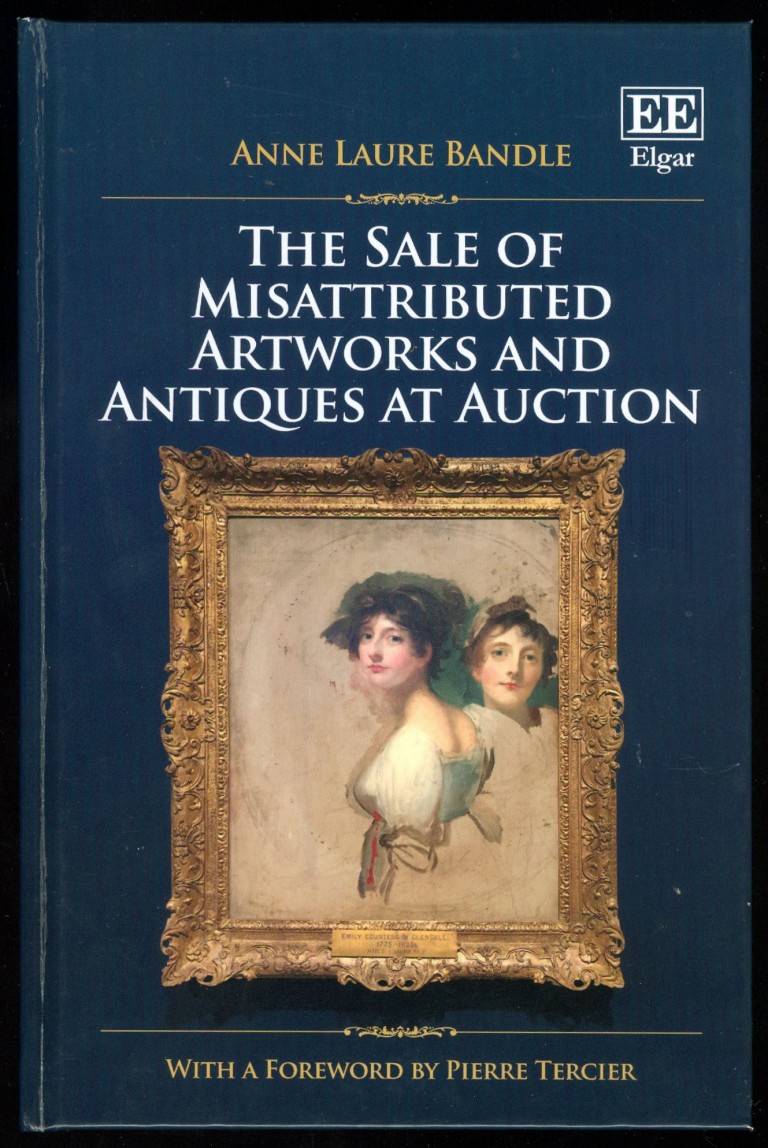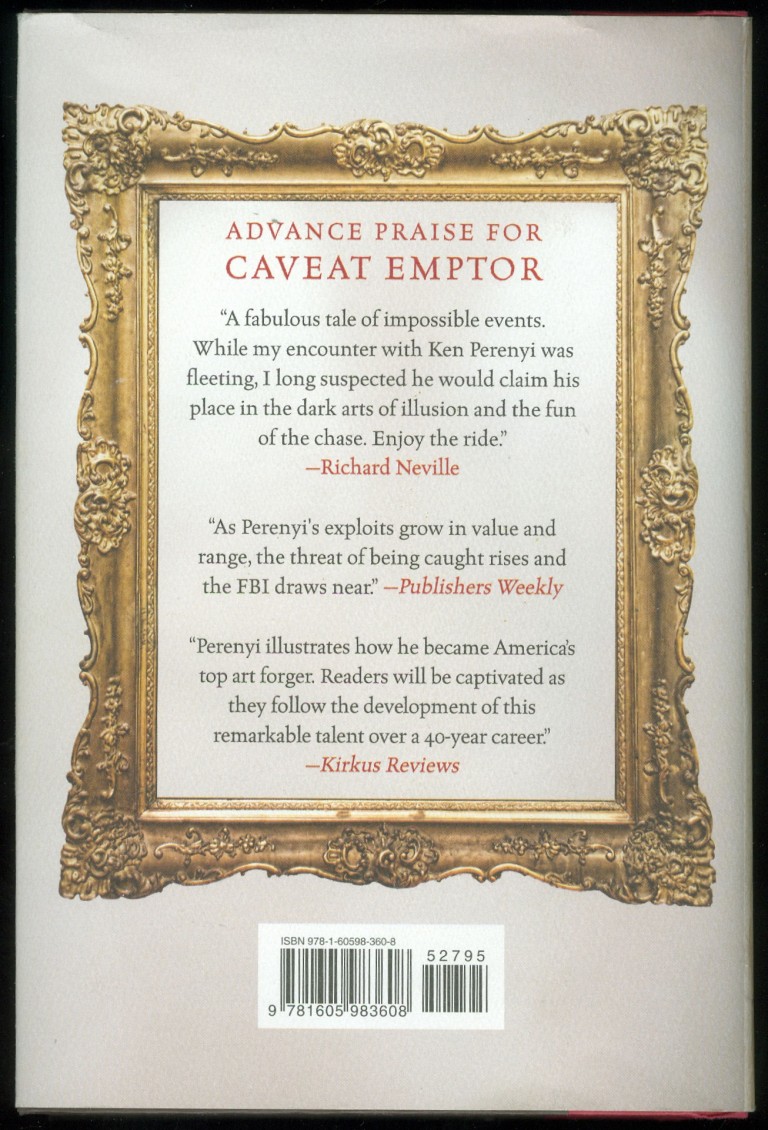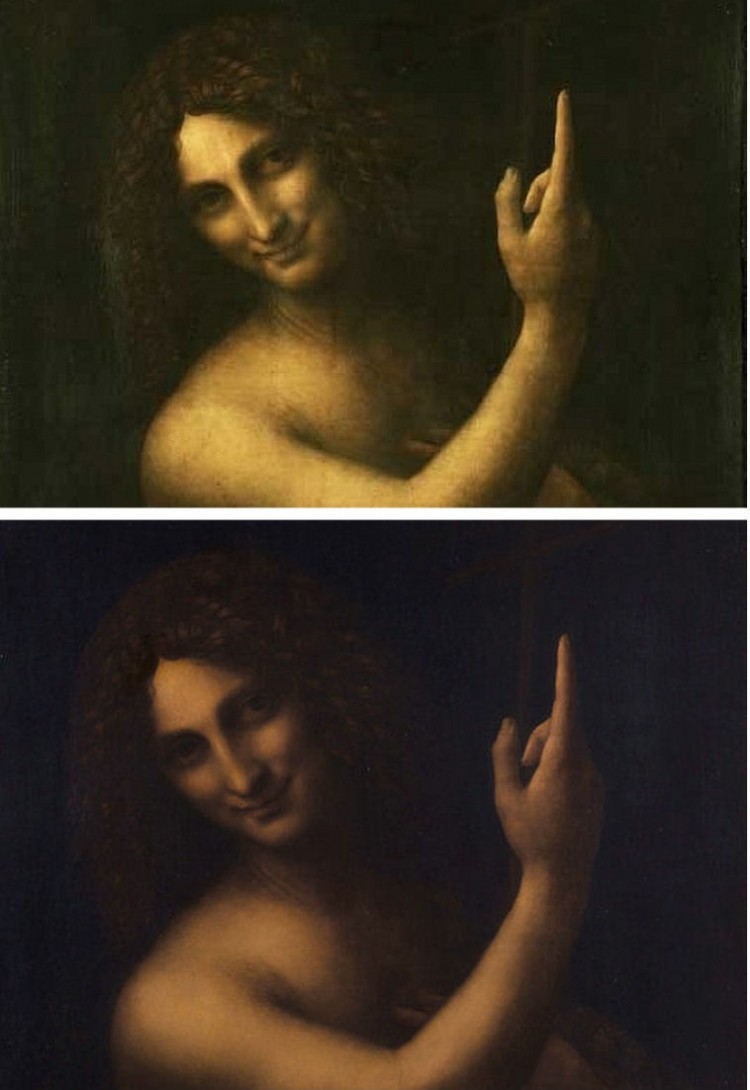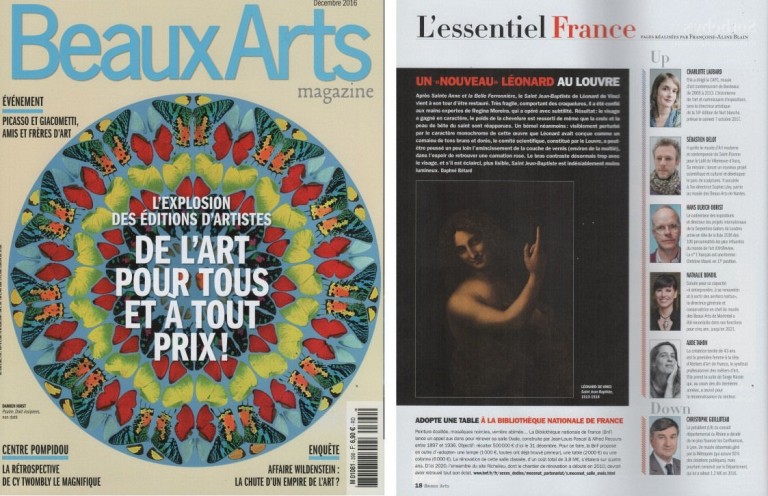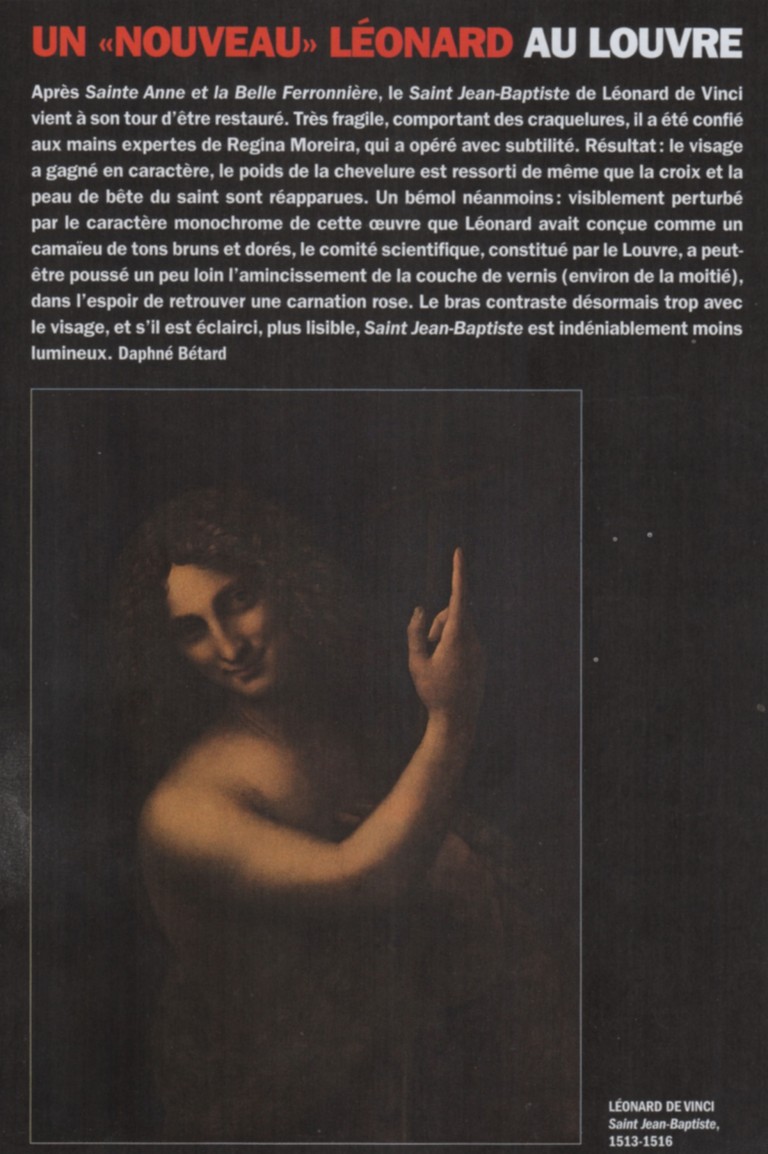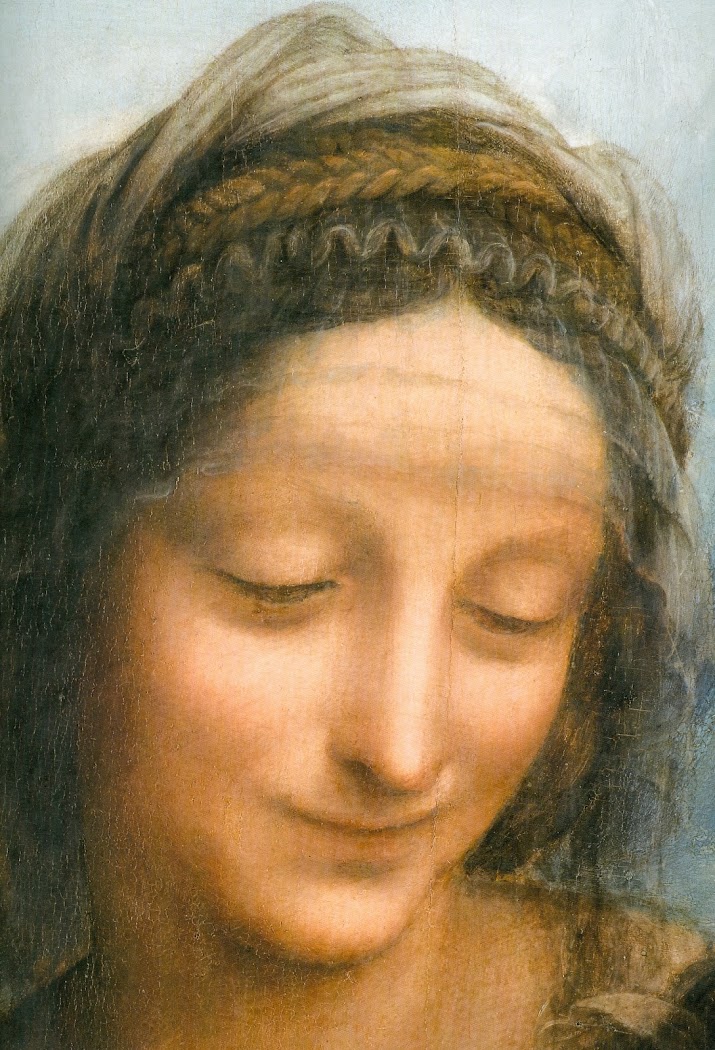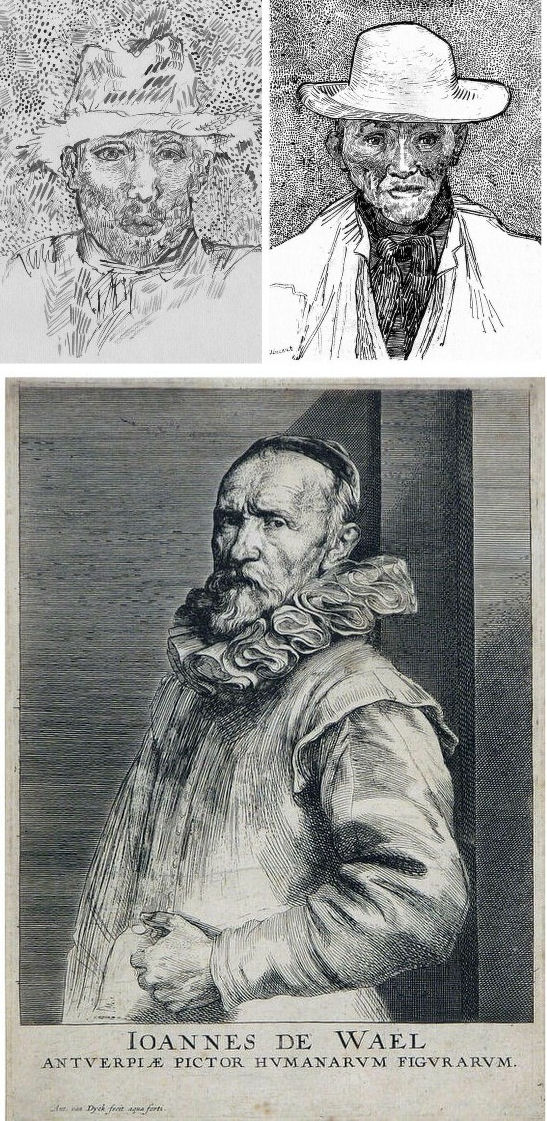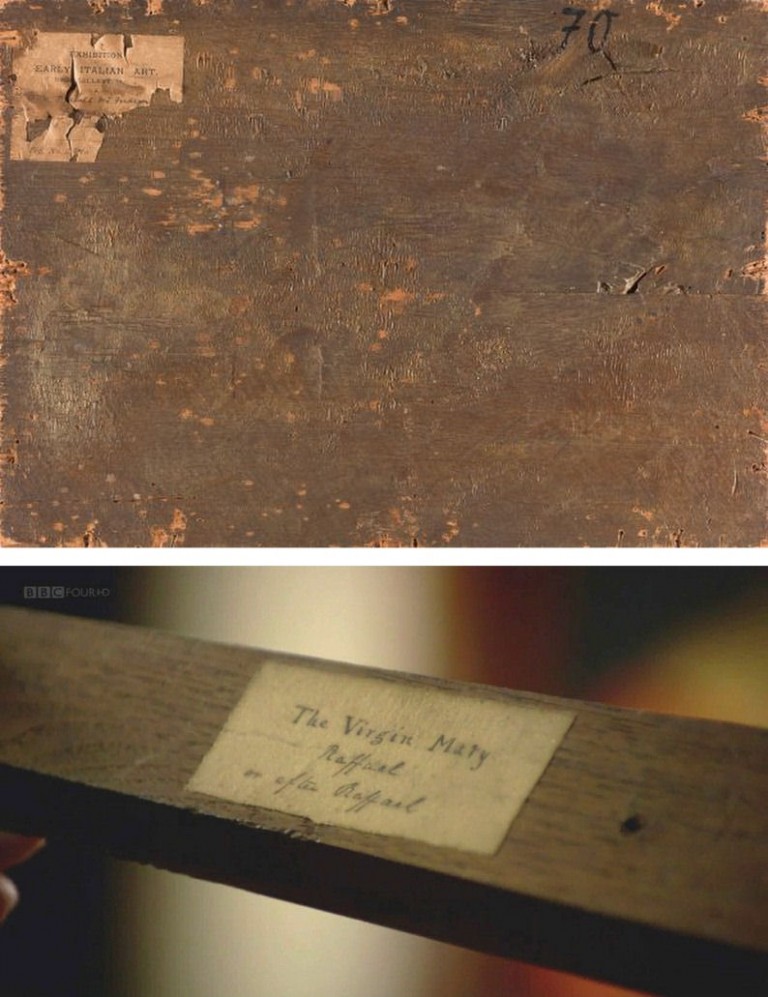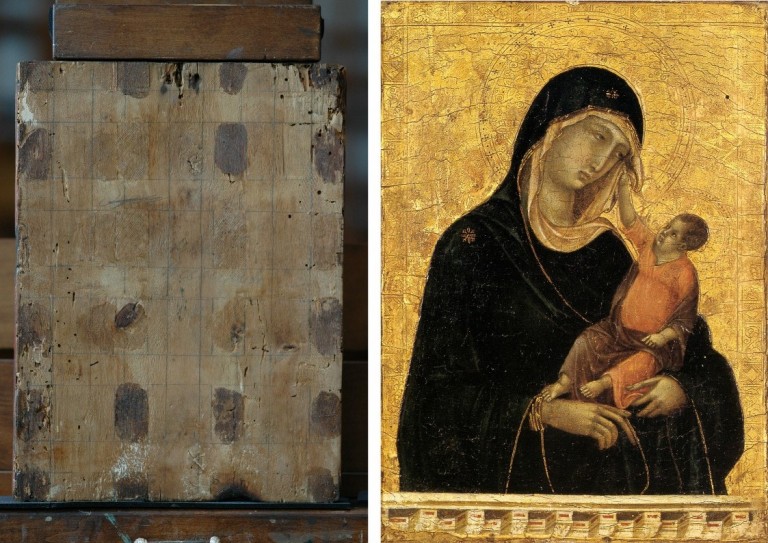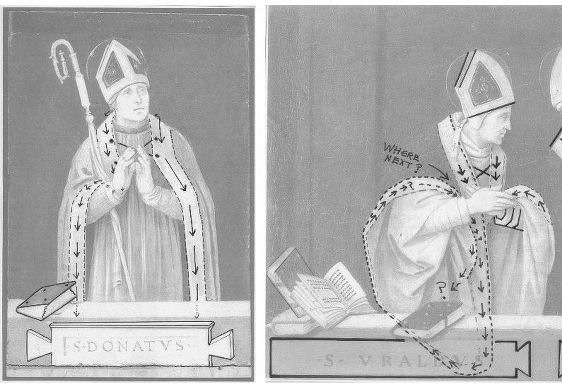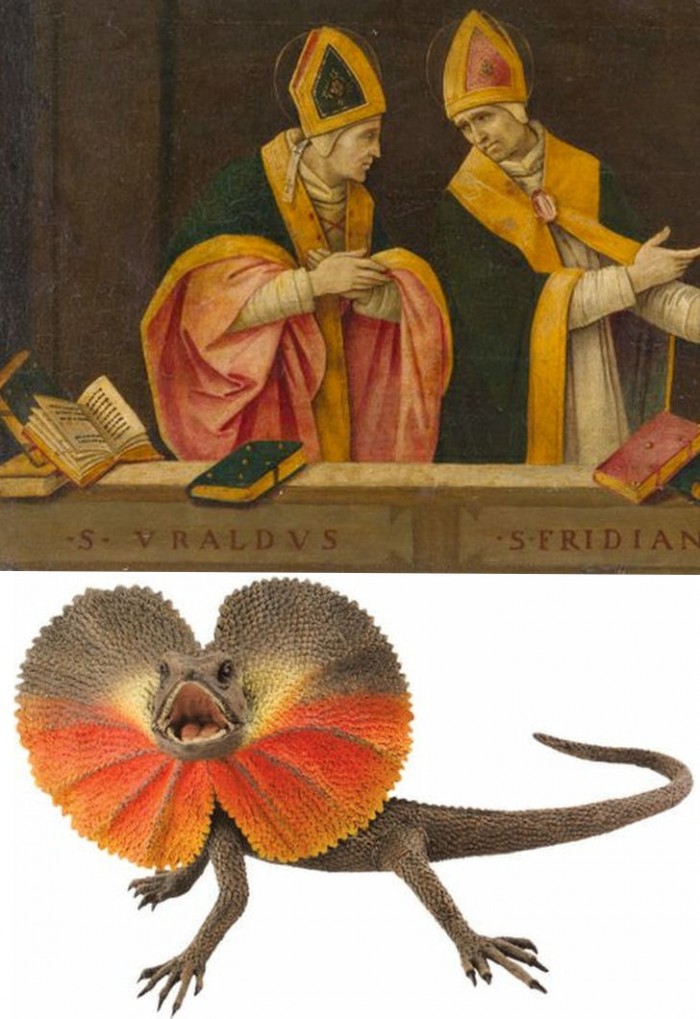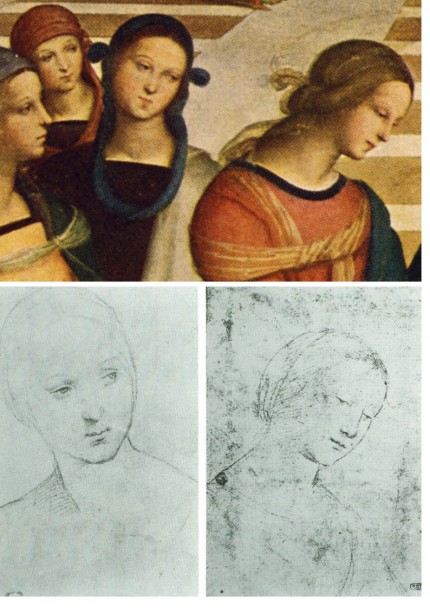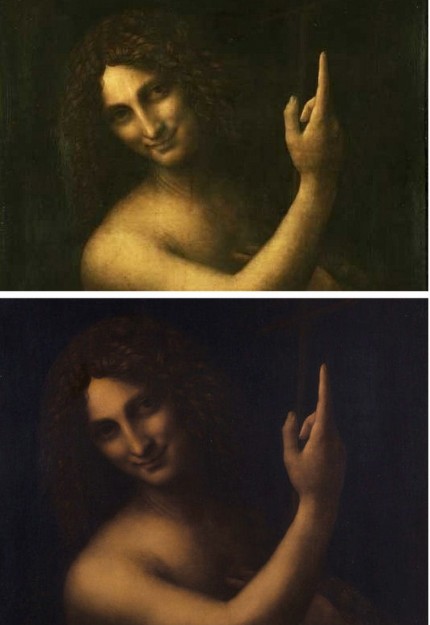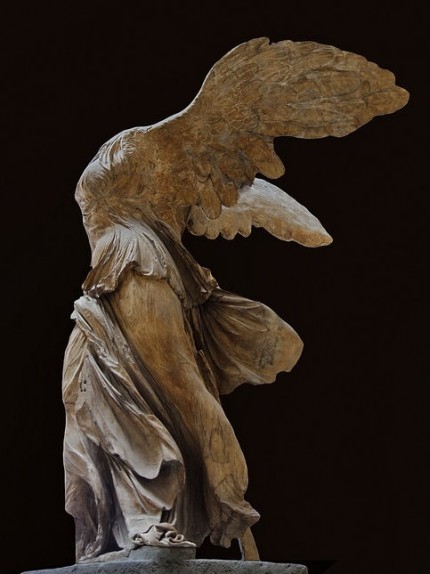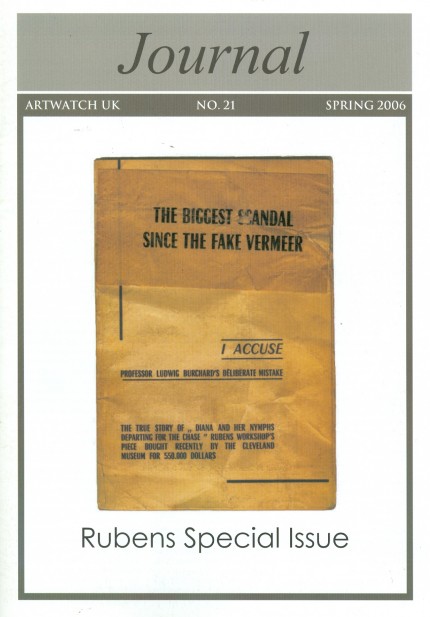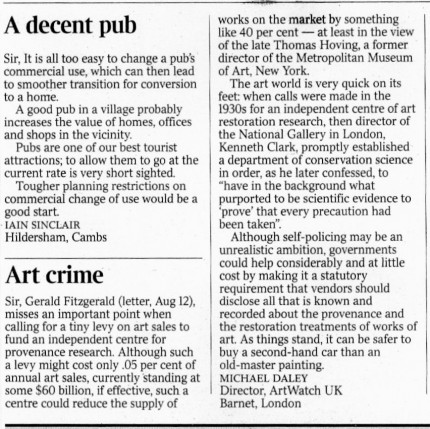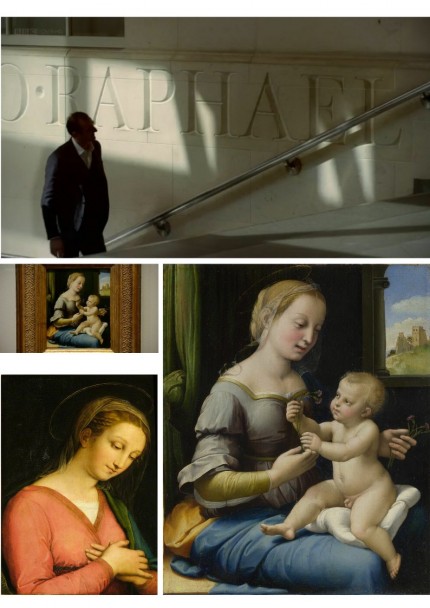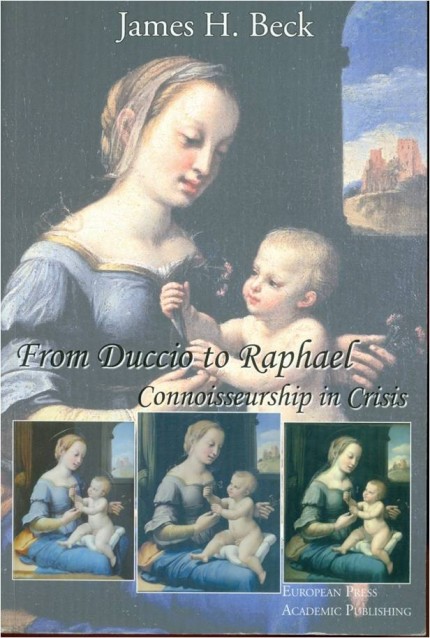The Leonardo Salvator Mundi Saga: Three Developments

“The more I read it, the more it looks probable.”
Above, Salvator Mundi, the painting attributed to Leonardo da Vinci and sold at auction in 2017 for $450 million. Photo: Drew Angerer/Getty Images – as published on 2 April 2018 in Buffalo News
The sensational Mail Online story (“EXCLUSIVE: The world’s most expensive painting cost $450 MILLION because two Arab princes bid against each other by mistake and wouldn’t back down (but settled by swapping it for a yacht”) discussed here in this News & Notices post, has been questioned or disparaged by a number of commentators but not directly challenged by Christie’s, so far as we know. On March 30 Bendor Grosvenor wrote (“Who underbid the Salvator Mundi?):
“I’m sceptical about this version of events. First, the source seems determined to prove mainly that the picture is somehow ‘not worth’ what it made – the figure of $80m is mentioned – when there were other underbidders up to the $200m level. Second, I’ve been told that the underbidder to $400m was not from the Middle East, from a source who would know.”
Had Grosvenor’s source been correct and the Mail’s story, thus, been seriously misleading, one would expect Christie’s’ lawyers to have demanded either changes to the online article or its removal. Grosvenor’s seeming partisanship on the Salvator Mundi case takes two forms. As well as knocking the knockers, he hypes his brother-auctioneers’ hype, as, on November 12 2017 (“Leonardo’s ‘Salvator Mundi’ to be sold at Christie’s”):
“I love this video of people seeing Leonardo’s Salvator Mundi. Christie’s say 20,000 have been to see the painting on its world tour. I’ve been impressed by how Christie’s have marketed the picture – in fact, I’d say that they’ve taken marketing Old Masters to a whole new level. A well deserved AHN pat on the back to all involved. The sale is on Wednesday 15th November. Anyone care to make a prediction?”
On November 16, the day after the $450m sale, Grosvenor was ecstatically supportive (“’Salvator Mundi’ – the most expensive artwork ever sold at auction”):
“Christie’s just did something that re-writes the history of auctioneering. They took a big gamble with their brand, their strategy to sell the picture, and not to mention the reputations of their leadership team, and they pulled it off. They marketed the picture brilliantly – the best piece of art marketing I’ve ever seen. Above all, they had absolute faith in the picture. AHN congratulates them all.”
Pace Grosvenor and his sources, questions on Christie’s marketing of the Salvator Mundi persist. The whispering campaign against the Mail’s disclosures has not worked. In this weekend’s Financial Times the author Melanie Gerlis closed her art market column with the item below:
As things stand, no one has disproved the Mail’s suggestion that the (disputed) Leonardo Salvator Mundi has been swapped for a luxury yacht. In her book Art as Investment, Gerlis noted that because the “worth and price are known to only a few” in an art market that is underpinned by a lack of “verifiable and meaningful data”, those looking to art purely as a secure investment “might first consider looking elsewhere.”
With the Salvator Mundi, some 13 years after its emergence, we still do not know when, where and by whom the painting was bought. There have been many conflicting accounts on the work’s ownership (see below). In the April 6 Antiques and Arts Weekly, the New York dealer Dr Robert Simon was asked: “Can you say where you found Leonardo’s ‘Salvator Mundi’?” He replied:
“Alex and I acquired the painting at an estate auction in the United States, but we’ve never divulged the location of the auction. We were not permitted to, according to the terms of the confidentiality agreement we signed at the time we sold the painting.”
The sale was conducted privately in 2013 through Sotheby’s when it was acquired by the “Freeport King”, Yves Bouvier, who was acting as an agent for the Russian oligarch Dmitry Rybolovlev. Did Sotheby’s insist that the origin of the picture not be disclosed? Or Bouvier? Whomever – the enforced confidentiality clause was made eight years after the claimed discovery/acquisition in 2005. However constricting the terms of the 2013 sale agreement might have been, they could hardly account for the non-disclosure of the owners’ identities for the previous eight years – including the time the picture spent in the National Gallery. When the Salvator Mundi was about to enter the Gallery’s big Leonardo show in 2011 as an autograph Leonardo, the Sunday Times reported:
“Its ownership is a closely guarded secret. Robert Simon, a New York art dealer, is representing the owner, or owners – the official line is it is a ‘consortium’.”
Why, then, did the National Gallery agree to participate in this secrecy on the ownership of a painting whose (contested) Leonardo ascription had been supported by the gallery’s own director; by one of its curators; and, by one of its trustees?
Another of the scholar-supporters of this upgraded Leonardo is Professor Martin Kemp. In 2011 Kemp told the Sunday Times how he had been invited to view the work by the National Gallery (“there’s something it’s worth you coming in to look at”, was how Kemp put it). Kemp described entering the National Gallery’s conservation studios and joining “a little group of people, including some Leonardo scholars from Italy and America, and Robert Simon.” Robert Simon had been accompanied on that trip by the Salvator Mundi’s restorer, Dianne Dwyer Modestini. In 2012 Modestini would deliver a paper on the picture’s (then) two restoration campaigns at a conference held in the National Gallery.
FRESH CLAIMS
On April 6 Buffalo News reported that Dianne Modestini was to speak on April 9 in the Burchfield Penney Art Center at SUNY Buffalo State and was about to make two new claims.
First, that she and her late husband, the restorer Mario Modestini, had entertained no doubts that this was an autograph Leonardo painting: “We were completely convinced and we felt that we could justify this to anyone without sounding like idiots.” This goes further than Modestini’s 2012 paper: “…when I first saw it I never imagined what would transpire with this lovely but damaged painting on panel…I wasn’t aware of a lost, much-copied Salvator Mundi by Leonardo and I was perplexed. I showed the painting to my then 98 year old husband, Mario…He looked at it for a long time and said, ‘It is by a very great artist, a generation after Leonardo’.”
Second, that no technical evidence had emerged to confirm authorship by Leonardo. Modestini reportedly said that what made her so sure was not “the discovery of any single clue attributable to the master’s style or any technical element of the painting that could be traced to his hand, but rather the quality of the painting”. There was “no under-drawing for example, that was Leonardo’s drawing style, or anything like that. The pigments are the pigments that any one of his contemporaries could have used, and did.” This attribution was entirely a matter of judgment: “the quality of the painting, the sort of old-fashioned connoisseurship and skills, which art historians have always used to make an attribution, were in the end the telling factor for us.”
Those present at her lecture might have learnt why a painting that had so soon revealed itself as an autograph Leonardo to two experienced restorers and in which “apart from the discrete losses, the flesh tones of the face retain their entire structure, including the final scumbles and glazes” had needed a third campaign of restoration with substantial repainting of the face, some time between 2016 (when the Qataris reportedly turned down a private offer of the painting for $80m) and the spectacular $450m sale at Christie’s on 15 November 2017 amidst modern works, not old masters.
A NEW BOOK – FURTHER COMPLICATIONS
Above: left, Peter Silverman, the owner of the drawing “La Bella Principessa”; right, Professor Martin Kemp, author of the 2010 book “La Bella Principessa” – The Story of the New Masterpiece by Leonardo da Vinci. Photo: as published in Martin Kemp’s Living With Leonardo
Professor Martin Kemp has published a new book (Living with Leonardo – Fifty Years of Sanity and Insanity in the Art World and Beyond) in which he pays a back-handed compliment to ArtWatch in his second chapter: “Theirs has been the most sustained and fully researched of the hostile polemics”. Elsewhere he launches a series of slurs against three named ArtWatch UK contributors and officers in defence of his own support for two recently attributed Leonardos, the Salvator Mundi painting, and the mixed media drawing on vellum glued onto oak, that he dubbed “La Bella Principessa”. The slurs will be refuted, but we note here that Kemp has now provided a fuller, and apparently verbatim, account of the National Gallery’s invitation to him to view the Salvator Mundi:
“On 5 March 2008, my birthday, an email arrived, announcing the appearance of a new Leonardo – a painting rather than a drawing […It] came from a well known source: Nicholas Penny, then director of the National Gallery in London.
“I would like to invite you to examine a damaged old painting of Christ as Salvator Mundi which is in private hands in New York. Now it has been cleaned, Luke Syson and I, together with our colleagues in both paintings and drawings in the Met, are convinced that it is Leonardo’s original version, although some of us consider that there may be [parts? – Kemp’s parenthesis] which are by the workshop. We hope to have the painting in the National Gallery sometime later in March or in April so that it can be examined next to our version of the Virgin of the Rocks. The best preserved passages in the Salvator Mundi panel are very similar to parts of the latter painting. Would you be free to come to London at any time in this period? We are only inviting two or three scholars.”
The following observations on that stage of the Salvator Mundi’s Leonardo accreditation might be made:
1) The method of inviting successive select groups of scholars to see and appraise the painting in the prior knowledge of others’ support for the new attribution might be thought to have fallen short of the National Gallery’s own practices. When Nicholas Penny, as a curator at the National Gallery, proposed the Northumberland version of Raphael’s Madonna of the Pinks as the original painted prototype of the very many versions, he first published a thorough and well-received scholarly article in the Burlington Magazine, and later invited a group of some thirty Raphael scholars to discuss the matter during a day-long symposium at the National Gallery.
2) With this Salvator Mundi upgrade, none of the fifteen or so invited experts has published a case for the attribution. Robert Simon has yet to publish the researches to which both Modestini’s restoration report and Luke Syson’s exhibition catalogue entry were indebted. It is not clear whether Modestini was present when the painting was examined at the National Gallery. Kemp writes in his new book:
“No one in this assembly was openly expressing doubt that Leonardo was responsible for the painting, although the possibility of participation by an assistant or two was generally acknowledged. I sensed that Carmen [Bambach, of the Metropolitan Museum drawings] was the most reserved about the painting’s overall quality. A general discussion followed. Robert Simon, the custodian of the picture (whom I later learnt was its co-owner), outlined something of its history and its restoration. He seemed sincere, straightforward and judiciously restrained, as proved to be the case in all our subsequent contacts…”
Carmen Bambach rejected the Leonardo attribution in a 2012 Apollo review of the National Gallery exhibition and gave the painting to Leonardo’s student Boltraffio. Ironically, the Times reported on 9 April 2017 that Kemp has now demoted the Hermitage Museum’s Litta Madonna (which was included as a Leonardo in the National Gallery’s 2011-12 exhibition) from Leonardo to Boltraffio.
3) After seeing the Salvator Mundi next to the National Gallery’s version of Leonardo’s Virgin of the Rocks (which is to say, its second version), Dianne Modestini was inspired to change the appearance of the former:
“There were actually two stages of the current restoration. In 2008 when it went to London to be studied by several Leonardo experts, there was less retouching. I hadn’t replaced the glazes on the orb, finished the eyes, suppressed the pentimenti on the thumb and stole, and several other small details but, chiefly, the painting still had the mud-coloured modern background that was close in tone to the hair. Two years later I was troubled by the way the background encroached upon the head, trapping it in the same plane as the background. Having seen the richness of the well-preserved browns and blacks in the London Virgin of the Rocks and based on fragments of the black background which had not been covered up by the repainting, I suggested to the owners that it might be worthwhile to try to recover the original background and finish the complete restoration.”
Thus, Modestini had intervened radically on the painting shortly before it was included in the National Gallery’s major 2011-12 Leonardo exhibition and two years after it was appraised by selected Leonardo scholars at the National Gallery.
4) Restoration campaigns, like wars, are easy to start. In 2012 Modestini acknowledged an ambition to finish a “complete restoration”, after seeing the National Gallery’s restored Virgin of the Rocks. Permission, she recalled, was granted to strip and repaint the entire background:
“The initial cleaning [i. e. paint and varnish removal] was promising especially where the verdigris had preserved the original layers. Unfortunately, in the upper parts of the background, the paint had been scraped down to the ground and in some cases the wood itself. Whether or not I would have begun had I known, is a moot point. Since the putty and overpaint were quite thick I had no choice but to remove them completely. I repainted the large missing areas in the upper part of the painting with ivory black and a little cadmium light red, followed by a glaze of rich warm brown, then more black and vermilion. Between stages I distressed and then retouched the new paint to make it look antique. The new colour then freed the head, which had been trapped in the muddy background, so close in tone to the hair, and made a different, altogether more powerful image.”
5) “Restorations”, which might more accurately be described as “stripped and painted re-presentations commissioned by owners”, are rarely straightforward and unproblematic. Modestini made her decisions in the sincere belief that the London Virgin of the Rocks is an entirely autograph Leonardo painting and therefore a reliable guide to her own interventions on the Salvator Mundi. However, that Leonardo attribution has only been widely thought to be the case since the painting’s recent restoration. Kenneth Clark, when director of the National Gallery thought otherwise. In 1944 he said of the head of the picture’s angel: “This is one part of our Virgin of the Rocks where the evidence of Leonardo’s hand seems undeniable, not only in the full, simple modelling, but in the drawing of the hair. The curls around the shoulder have exactly the same movement as Leonardo’s drawings of swirling water. Beautiful as it is, this angel lacks the enchantment of the lighter, more Gothic angel in the Paris version…” Of the head of the Virgin, Clark wrote:
“…It is uncertain how much of this replica [of the first, Louvre, Virgin of the Rocks] he [Leonardo] executed with his own hand, and this head of the Virgin is the most difficult part of the problem. It is too heavy and lifeless for Leonardo and the actual type is un-Leonardesque; yet it is painted in exactly the same technique as the angel’s head in the same picture; and that is so perfect that Leonardo must surely have had a hand in it. Both show curious marks of palm and thumb…made when the paint was wet, and no doubt covered by glazes long since removed. This perhaps is a clue to the problem. A pupil did the main work of drawing and modelling, and before the paint was dry Leonardo put in the finishing touches. Most of these have been removed from the Virgin’s face but remain in the angel’s, where perhaps they were always more numerous.”
Above, top: The head of the Virgin in the National Gallery’s (second) version of Leonardo da Vinci’s The Virgin of the Rocks, as published in 1944 in Kenneth Clark’s One Hundred Details from Pictures in the National Gallery. Above, the Head of the Virgin as published in the 1990 re-issue of Clark’s “Details” book and, therefore, after its post-war restoration by Helmut Ruhemann but before its more recent re-restoration by Larry Keith (in which the mouth of the Angel was altered, on Luke Syson’s advice, as discussed here in “Something Not Quite Right About Leonardo’s Mouth ~ The Rise and Rise of Cosmetically Altered Art”).
Above, the face in the accredited Leonardo da Vinci Salvator Mundi, as exhibited, left, in the National Gallery in 2011-12, and, right, as when sold at Christie’s in November 2017.
In 1990 the National Gallery remarked that “as a result of” the picture’s 1949 restoration “the differences between the heads are perhaps less apparent”. That being so, either one face had received new glazing or the other had lost original glazing. For Kemp, a crucial technical proof of Leonardo’s authorship of the Salvator Mundi is the fact that technical examinations had disclosed that “As is generally the case with Leonardo, infrared rays delivered the most striking results. It was good to be able to see that the artist had pressed his hand in to the tacky paint above Christ’s left eye – which we have seen to be characteristic of Leonardo’s technique.”
THE UNDERSTANDING TODAY ON THE SALVATOR MUNDI’S OWNERSHIP BETWEEN 2005 AND 2013
In his seventh chapter (“The Saviour”) Kemp twice discusses the ownership of the Salvator Mundi. He does so first with regard to the exclusion from the National Gallery’s 2011-12 exhibition of the “La Bella Principessa” drawing (– whose Leonardo ascription he has energetically advocated):
“This episode highlighted the rationale for the inclusion of the Salvator Mundi. Was it on the market? Would exhibiting it mean that the National Gallery was tacitly involved in a huge act of commercial promotion? It seemed highly likely that it was also ‘in the trade’ [like the ‘La Bella Principessa’]. All I knew at this stage [2011] was that it was being represented by Robert Simon. He told me that it was in the hands of a ‘good owner’ who intended to do the right thing by it, and I did not inquire any further.”
So, it would seem that the National Gallery had not disclosed the identity of the owner/owners to the scholars it invited to appraise the painting. Kemp continued:
“I was keen to consider the painting in its own right, not in relation to its ownership. I speculated, of course, that Robert might have a financial interest, perhaps a share in its ownership; and I assumed that he was gaining some kind of legitimate income from his work on the picture’s behalf. But the gallery was assured that the work was not on the market. Understandably keen to exhibit it, they were happy to accept this assurance…Might the Salvator have been less well regarded if its messy sale [in 2013, privately through Sotheby’s] to Bouvier [for $80m – $68m in cash and a Picasso valued at $12m, according to Georgina Adam in her “Dark Side of the Boom” book] and its resale [to Dimitry Rybolovlev for $127.5m] had been apparent before its public debut [at the National Gallery in 2011-12]? It has turned out to be a substantial mess. In November 2016, an article in The New York Times reported the latest developments: three ‘art traders’ (Robert Simon, Warren Adelson and Alexander Parrish) were disconcerted to find that painting was ‘flipped’ by Bouvier for $47.5m more than their selling price. Was Sotheby’s a knowing party to the the resale? The auction house claimed that it was not, taking pre-emptive legal action to block any law suit by the ‘traders’….It was however a great surprise to find that the Salvator was to be sold at Christie’s in New York on 15 November 2017 at a mega-auction of celebrity works from the modern era. The auctioneers sent the painting on a glamorous marketing tour of Hong Kong, San Francisco and London. I was approached by the auctioneers to confirm my research and agreed to record a video interview to combat the misinformation appearing in the press – providing I was not drawn into the actual sale process.”
Where would we be without a free and vigilant press? Where, precisely, is the $450m Salvator Mundi today?
Michael Daley, 10 April 2018
In Celebration: Paul Anthony Harford, Draughtsman
Recent sickening art world tendencies seem to be crescendoing and calling for some antidote; for some demonstration and reminder of how artistic scruple diligence dedication and humanity might trump the mightiest, most meretriciously hyped, art market-buoyed artefacts and no-talent productions that are currently feted in venerable museums and country piles.
A stunning distinctive show is currently running (until 22 April) at the Focal Point Gallery in Southend-on-Sea. It is accompanied by a modest thoughtful catalogue that celebrates a monumental achievement. An elegant, matter-of-fact foreword by the gallery’s director, Joe Hill, announces an utterly autograph voice and a most haunting corpus of pencil-drawn works (- some examples or details of which are shown below):
“‘Other Voices, Other Rooms’ is an exhibition publication dedicated to the work of Paul Anthony Harford.
“Harford lived and made drawings in Southend-on-Sea and Weymouth, before passing away at the age of 73 in Leigh-on-Sea in 2016. Harford produced hundreds of meticulous, large-scale drawings throughout his lifetime. His remarkable work delicately interrogates the everyday and the commonplace against the background of the faded British seaside.
“Harford attended Byam Shaw School of Art in London as mature student, following this he moved his young family to Southend-on-Sea after a chance advertisement for a seafront flat caught his attention. He secured a job cleaning windows in Southend’s High Street before eventually earning a new position, riding the electric cream and green pier trains to clean the arcades at the end of the pier where he witnessed the devastating fire of 1976.
“His drawings are rooted in his lived experience and shed light on his unique viewpoint of the British seaside town. Often putting himself at the centre of the work, Harford’s drawings disclose some of the underlying truths prevalent in these places. Later in life Harford depicts the seaside as a complex refuge, a site where addictive behaviours are acted out and the typically unseen realities of aspiration and decline are laid bare.
Harford had no real in interest in gaining recognition for his work and so never sought opportunities to exhibit. His emotional connection to the drawings made him unable to contemplate parting with or showing them. They were all kept, stacked several layers deep around the walls of his attic studio.
Unfortunately, I never had the pleasure of meeting Paul before he passed away. I came to know about the work through his family. Since this moment, I have tried to know this character through the illustrated world he had created. The series identifies a seaside life removed from the conventional picture of the bustling Victorian seafront. The draw of these towns as a place of refuge and solace is an all too familiar tale to all us seaside dwellers.
“I would especially like to thank Elsa Harford for her vision, enthusiasm and support throughout this project and her two sons Paul and Stefan Harford for lending the work for the exhibition.”
Michael Daley, 2 April 2018
Startling disclosures on the re-re-restored Leonardo Salvator Mundi
One of the many mysteries surrounding the sale of the Modestini Leonardo Salvator Mundi that fetched $450m at Christie’s on 17 November 2017 was the identity of the under-bidder who staked $370m. The Daily Mail would seem to have the answer:
“EXCLUSIVE: The world’s most expensive painting cost $450 MILLION because two Arab princes bid against each other by mistake and wouldn’t back down (but settled by swapping it for a yacht)
• Leonardo Da Vinci’s ‘Salvator Mundi’ sold at an auction last November for a record-breaking $405.3million
• It was later revealed the painting’s buyer was Saudi Prince Bader bin Abdullah
• Palace insiders said the purchase was on behalf of the country’s crown prince Mohammed Bin Salman, whose regime was criticized for the purchase
• De-facto United Arab Emirates ruler Mohammed Bin Zayed also sent a representative to bid on the painting at the Christie’s New York auction
• Neither knew the other was bidding, instead they both feared losing the auction to reps from the Qatari ruling family – fierce rivals of UAE and Saudi Arabia
• Qatar’s ruling family was offered the painting just a year earlier for $80 million
• Salman’s $450 million purchase was condemned by critics of his regime
• After facing criticism, he struck a deal with his Emirati counterpart to swap the painting for a superyacht also worth $450 million”
The Mail’s remarkable account rather makes monkeys out of those cheer-leading art market commentators who took the record price achieved by Christie’s as if a confirmation of the (untenable) attribution. See the whole account here:
The Royal Academy, having unsuccessfully requested the Dianne Dwyer Modestini Mark III Version of the painting for its (magnificent) Charles I Collection exhibition the day after the sale, may have had a close escape. Curators at the Louvre, who bagged the painting for their planned big Leonardo anniversary exhibition next year, might now be given pause for thought. The Mail article shows the $450m Salvator Mundi not as it was sold in 2017 but as it was exhibited in 2011 at the National Gallery in its Modestini Mark II version. Professor Martin Kemp necessarily reproduced the Modestini Mark II version in the 2011 edition of his book Leonardo but he continues to reproduce that now obliterated version in his new memoir Living with Leonardo – Fifty Years of Sanity and Insanity in the Art World and Beyond which goes on sale tomorrow.
To see the Mark II state of the painting, as in 2011, click on our: The Reception of the First Version of the Leonardo Salvator Mundi . To see the Modestini Marks II and III versions together, click on: The $450m New York Leonardo Salvator Mundi Part II: It Restores, It Sells, therefore It Is. To see the extent of the changes between 2011 and 2017, click on The “Salvator Mundi” attributed to Leonardo da Vinci, from the authentication in 2011/12 to the sale in 2017, on which site Dr Martin Pracher (- who first spotted the post-2011 re-restoration) shows a number of details in gif formats that will enable even the most aesthetically disadvantaged viewer to appreciate the scale of the transformation this attributed Leonardo had undergone without any acknowledgement by Christie’s before its now-legendary – if not notorious – 17 November 2017 sale.
Michael Daley, 29 March 2018
IN THEIR OWN WORDS: No. 3 [11 March 2018] – The Reception of the First Version of the Leonardo Salvator Mundi
Mounting concerns over transparency in art world deals are throwing back-dated light on the Salvator Mundi’s reception in its first-restored incarnation when included in the 2011 National Gallery exhibition Leonardo da Vinci: Painter at the Court of Milan.
THE SALVATOR MUNDI’S FIRST PUBLIC OUTING IN 2011
Above, top, the Sunday Times magazine cover of 9 October 2011. Above, the face of Christ in the Salvator Mundi as seen after repainting in 2011, left; above, right, the face of Christ in the Salvator Mundi as seen in November 2017 after further repainting between 2012 and 2017.
In the 9 October 2011 Sunday Times (“LEONARDO? CONVINCE ME”), Kathy Brewis wrote:
“For a few weeks in London you will be able to see the Salvator Mundi (Saviour of the World) up close. It might be your only chance. Much of the painting’s history remains obscure. Its ownership is a closely guarded secret. Robert Simon, a New York art dealer, is representing the owner or owners – the official line is it is a ‘consortium’. Why all the secrecy? ‘It’s just privacy and security’, says Simon, ‘One doesn’t want people knocking on the door.’
“…He showed it to Mina Gregori, a retired professor at Florence University, who was stunned: ‘I believe it’s by Leonardo.’ Then he showed it to Nick Penny, who had just been appointed director of the National Gallery. ‘He understood it in a nanosecond. He said that one of his ambitions was for the gallery to be a venue for scholarly inquiry and research and that he’d like the painting to be brought to London so it could be compared with the Virgin of the Rocks.’ It was Penny who told him [Simon]: ‘You need a consensus…’
“Since Robert Simon went public with the discovery, he has received many emails from Leonardo fanatics. ‘There’s the serious obsession and there’s the lunatic one – people for whom Leonardo is a source of fantasy. The paintings are not knowable,’ he muses. ‘Every one of them presents a problem and a challenge.’ Even at this stage? ‘Art historians are a prickly, competitive lot. I wouldn’t be surprised if someone stuck their hand up and said “I don’t believe it”’. Could the experts be wrong? ‘They could be wrong about anything. But as much as I believe anything in this world, I believe this is by Leonardo.’”
Above, and top left, the Salvator Mundi as exhibited in 2011 at the National Gallery’s big Leonardo exhibition.
Kathy Brewis continued:
“…Frank Zöllner of Leipzig University [- and author of the Leonardo catalogue raisonné] is a rare dissenter: he thinks the proportions of the nose (‘too long’ for such a perfectionist as Leonardo) make it more likely to have been painted by a talented follower. The rest are convinced, if a little jealous that they didn’t unearth it themselves. ‘People in the art world get sniffy about dealers,’ says Bendor Grosvenor, director of the London fine-art dealership Philip Mould. ‘But if it wasn’t for the trade, discoveries like this wouldn’t be made. Specialist dealers are the ones who are prepared to buy a dirty picture, roll their sleeves up and get stuck in to seeing what it is.’
“Is it wise for the National Gallery to put it on show so soon after its authentication? ‘They are taking a risk,’ says Grosvenor, ‘and I can’t applaud them enough for it. Connoisseurship is a nebulous discipline. There can never be absolute 100% proof. You have to accept there’s an element of doubt and go with it.’”
Note – On 5 March 2018 Grosvenor declared himself an ex-dealer on his blog Art History News: “Now, portraiture can be a hard sell – I know this from having spent over a decade actually selling portraits, in my former life as a dealer.” This did not come as an absolute bolt out of the blue: although he remains a director of the Scottish auctioneers Lyon and Turnbull Limited, last year Grosvenor briefly closed down his website following certain professional criticisms, commenting as he did so: “at the same time AHN also makes me a significant number of, well, ‘enemies’ is not too strong a term. Every walk of life has its Salieris, but in the art market there are an awful lot of them.”
Kathy Brewis continued with a discussion on the Salvator Mundi’s owners:
“Luke Syson, the show’s curator is one of the few people who know who owns the picture. ‘We couldn’t exhibit it otherwise. It’s not being wafted to us in a brown envelope.’”
Ben Hoyle reported the Salvator Mundi’s owners’ plans in the Times of 12 November 2011 (“It’s kind of scary – I wrapped it in a bin liner and jumped into a taxi with it”):
“‘Everyone involved recognises the importance of it as a work of art. Doing the right thing has been very important and will continue to be,’ Mr Simon says. If that means selling it for half the price they could attract, to ensure that it stays on public view, then they would prefer to do that.”
In the event the picture was sold privately by Sotheby’s in 2013 to a Swiss businessman, Yves Bouvier, who is known as the “Freeport King” (and who, among many commercial interests, owns an art conservation and authentication service), for appreciably less than the sums of $150-200m being talked about in 2011 (when the owners reportedly had turned down a $100m offer). The original consortium and Robert Simon received $80m for the Salvator Mundi from Bouvier who resold it for $127.5m to the Russian billionaire Dmitry Rybolovlev.
To this day we do not know who owned the Salvator Mundi before 2005 or between 2005 and 2013. From whomever and by whomever it was bought in 2005, the painting’s reception as an attributed Leonardo in 2011 was very far from uniformly rapturous. In addition to the dissenting scholars we cited on 14 November 2017 (see THE CRITICAL RECEPTION OF THE NEW YORK SALVATOR MUNDI), a number of newspaper art critics were un-persuaded.
In the 13 November 2011 Sunday Telegraph (“The genius of Leonardo”), Andrew Graham-Dixon wrote:
“…The picture is certainly Leonardesque. But is it by Leonardo? That is the considerably-more-than-million-dollar question for the consortium of art dealers who acquired the work a few years ago for an undisclosed sum. If the attribution holds up they can expect to reap £125m as a reward for their good judgement.
“Leonardo da Vinci: Painter at the Court of Milan is a breathtaking and truly remarkable exhibition which brings together around half of the surviving 15 or so surviving paintings by the famously dilatory artist of the Italian Renaissance…Two works in particular appear destined to come under scholarly fire.
“Although it gets the thumbs up from the National Gallery’s curator, [Luke] Syson, there will certainly be those who question the new Christ. The picture undeniably displays a number of the painter’s characteristic devices and mannerisms, but there are other aspects of it that seem foreign to Leonardo himself.
“He was prized by his contemporaries as one of the most innovative and forceful painters of emotion, yet the face of this Christ seems peculiarly inert. Taken individually, its elements are convincing enough, but viewed as a whole its expression seems to lack a certain subtle Leonardo magic: the spark of inner life and feeling…”
Even after the picture had been re-done-over by the restorer, Diane Modestini, ahead of the 15 November 2017 sale, the Sunday Times’ art critic, Waldemar Januszczak, responded with less tact than Graham-Dixon (“The Miracle of da Vinci: Turning a £45 Oddity into a £341m Old Master”, 19 November 2017):
“…To call the Salvator Mundi untypical is massively to understate the case. It resembles nothing else Leonardo painted
“The claim by Loic Gouzer, chairman of contemporary art at Christie’s in New York, that the record-breaking Jesus bears ‘a patent compositional likeness’ to the Mona Lisa had me laughing out loud. Yes, it shows the upper half of a figure in a frame. But that is the only compositional likeness the Salvator Mundi shares with the Mona Lisa…
“The next time I saw the painting was in 2011 when the big Leonardo exhibition was opened in London. Full of magnificent loans – the Lady With an Ermine, from Poland; the Virgin of the Rocks from the Louvre – it really was a once-in-a-lifetime event. And there on the wall was the recently rediscovered Salvator Mundi looking just as strange and sci-fi as I remembered it.
“At the time it was owned by a consortium of art dealers who had bought it in an American estate sale for $10,000 as a work by a follower of Leonardo. The dealers had it comprehensively cleaned and repainted. The National Gallery, eager to give its show a boost, announced it as the first new Leonardo discovered in 100 years. Wow…
“Soon after its London unveiling it was sold on to the Russian Billionaire, Dmitry Rybolovlev, for a reputed £98m. It was Rybolovlev who sold it again in New York last week.
“How did Leonardo’s sci-fi Christ, who looks as if he belongs on the cover on one of L Ron Hubbard’s scientology textbooks, end up costing all those shekels? It was mostly due to the wicked brilliance of Christie’s.
“Not only did the auction house tour the picture noisily to Hong Kong, and London before the New York sale, drumming up interest among the newly rich, but its hype department was also in full swing on this one. Finding a new Leonardo, boomed Gouzer, ‘is rarer than finding a new planet’. It’s ‘the greatest discovery of the century’ repeated the Christie’s chorus.
Above, Patrick Chappatte’s take on the Salvator Mundi sale/attribution for the New York Times. Below, Patrick Blower’s incorporation of the Labour Party leader, Jeremy Corbyn, for the Daily Telegraph:
Waldemar Januszczak continued:
“In recent years modern art has been where the money goes. A new generation of mega-rich collectors who know a lot about luxury brands but not much about art, have piled into the market and sent prices soaring.
“Earlier this year a quickly splattered Jean-Michel Basquiat of a face shaped like a skull sold in New York for an astonishing £85m. By putting the Leonardo in such a context, Christie’s circumnavigated the knowledgeable world of the Old Master collector and headed straight for the dumb f**** with the money.
“There are various ways to understand events in New York on Wednesday night [of 15 November 2017].
“You can see them as evidence of Leonardo’s treasured and mythic status in art. You can see them as testimony to the power of attribution. Or you can see them as proof that we live in a mad world that has lost sense of true value and in which obscenely rich people waste obscene amounts of money on the obscene acquisition of trophy art. Going, going, gone.”
SUPPORT AND DISSENT
It so happens that the scholar who first attributed the Salvator Mundi to Leonardo, Professor Mina Gregori, was also the first scholar to attribute the proposed Leonardo drawing that was dubbed “La Bella Principessa” by Professor Martin Kemp. However, “La Bella Principessa” was not included in the National Gallery’s Leonardo exhibition and, seven years later, it remains unsold. Although we know precisely why the dissenting scholars rejected the Salvator Mundi attribution (- they published their views in the scholarly press), we have virtually no information of who said what and in what order among the consensus of scholars listed by Christie’s (see Problems with the New York Leonardo Salvator Mundi Part I: Provenance and Presentation).
SECRET DEALS – AND THE ARTS CLUB
Since we began warning on this site in 2014 of the threat to market confidence posed by the art world’s toxic attributions and specifically called for increased transparency through a statutory requirement that vendors should disclose all that is known and recorded about the provenance and the restoration treatments of works of art (“As things stand, it can be safer to buy a second-hand car than an old master painting” – “Art crime”, ArtWatch UK letter, the Times, 13 August 2014), secret deals have come under increasingly intense investigation. In her 2017 book Dark Side of the Art Boom, Georgina Adam wrote:
“At its base, the Bouvier/Rybolovlev dispute was about the nature of their business conducted within a market that has always thrived on secret backroom deals. By keeping vendors and buyers apart – they may never know who the other is – and insisting on discretion, agents, dealers, advisors can use this anonymity to their advantage. Various reasons can be put forward, from the need for security to the desire to avoid family quarrels or the taxman, to the risk of someone else bagging the work for sale. In the Bouvier/Rybolovlev case, one of Bouvier’s emails about a Magritte, said: ‘I must carry out this [negotiation] with the greatest discretion to avoid drawing attention to the painting and its owner; the risk is that we could lose it at auction.”
In this weekend’s Financial Times (10/11 March 2018 – “Laundering Picasso: British dealer among accused in $50m case”), Melanie Gerlis cites the emergence of another highly embarrassing series of documents:
“Potential shenanigans involving art are in the spotlight once again. London art dealer Matthew Green is among defendants in the case against Beaufort Securities, three other corporations and five other individuals, accused by the US Department of Justice of a multiyear $50m-plus securities fraud and scheme to launder money, partly through the sale of a £6.7m painting by Picasso.
“The indictment alleges that Green, described as the owner of Mayfair Fine Art Limited, met last month with an investment manager from Beaufort Securities (now declared insolvent), as well as a property developer and an undercover federal agent masquerading as a client of the brokerage firm. At this meeting held around February 5, the court papers say that the agent-client was told he could ‘purchase a painting from Green using the proceeds of the stock manipulation deals and later sell the painting to “clean the money”’…The papers describe the art business as ‘the only market that is unregulated’”.
“The papers also say that Green – who had allegedly asked for a 5 per cent profit on the transaction, ‘so that he would not be asked why he was in the money laundering business’”. [Green] sent a message via What’sApp to the Beaufort Securities manager that read: ‘[O]bviously because of the nature of this transaction we need to preserve a certain amount of anonymity which [the undercover agent] and I discussed and clarified at the Arts Club!’”
UNDERCHARGING FOR CURRENT MARKET PRACTICES
The Art Market Monitor blogger, Marion Manneker, made this observation in his (5 March) comments on the trial:
“Green doesn’t seem to know that the price for laundering money is much higher than 5% which definitely isn’t worth the risk if it gets you indicted after being in business all of three months. Worse still, Green and his partners don’t seem to be the swiftest criminals. They boasted that the art market is unregulated but then created a scheme that seems to have had little to do with the art market itself.
“The art sale is only one of several money-laundering venues that the person was offered. Offshore banks and real estate deals figure prominently in the indictment. What’s more, Green’s scheme could have been conducted in just about any commercial transaction. And, since the payment for the Picasso was due March 6, 2018, we’ll never know if Green was actually capable of pulling off the sale at the price he claims or would have survived any kind of audit.”
OLD HABITS DIE HARD?
Manneker’s comments on the cut-price scale of Matthew Green’s alleged laundering service charges recalls certain comments of Kenneth Clark who recognized that his appointment as director of the National Gallery at a very tender age owed much to the fact, as he wrote in his 1977 memoir Another Part of the Wood, that:
“[T]he ideal candidate for the post was disqualified. This was a Finnish art-historian named Tancred Borenius. He was a good scholar, a pleasant companion and a passionate upholder of the concept of the monarchy. He would have made an ideal courtier. Unfortunately, he was known to have followed the continental practice, described above, of taking payments for certificates of authenticity; and what was worse, quite small payments (known as ‘smackers under the table’); if he had taken large payments like a few scholars on the continent, no one would have objected.”
Michael Daley, 11 March 2018
UPDATE, 12 March 2018. On 11 March, a Sunday Telegraph supplement (“Arts, Antiques and Collectibles”) carried a “Promotional feature” – “Managing Risk When Buying and Selling Art” – for the law firm Constantine / Cannon. In offering the firm’s services, the article began:
“TRADING IN ART has traditionally been done on a handshake, but this is changing. You would not buy or sell a house without relying on a lawyer to prepare the contract, would you? The same goes with art, and now buyers and sellers are increasingly turning to lawyers to help them manage the risks associated with expensive works. The art market used to function like a club of like-minded people, but that’s no longer the case. The market now is truly global, and it has become less transparent in the process…”
IN THEIR OWN WORDS: No. 1 – Civilisations and Burrell Loans
It’s official: the BBC remake of Kenneth Clark’s highly acclaimed television series Civilisation is an intellectually incoherent artistically obtuse “right-on” mish-mash. It is official: Glasgow is repeatedly dicing with Burrell’s bequeathed art for financial peanuts and supposed profile enhancement.
NICE PICTURES, POOR WORDS
Above, top, Kenneth Clark shooting on the still-acclaimed 1969 series Civilisation; above, Simon Schama fronting the scathingly-received 2018 multi-voiced Civilisations outside Itimad-ud-Daulah’s Tomb in Agra, Uttar Pradesh.
“…By adding a single pluralising letter to the classic BBC art history series Civilisation (1969), the programme makers of Civilisations opened up the tantalising possibility of producing a new TV series that didn’t simply match its singular predecessor, but was much better.
“You can see the sense in the idea. Instead of an old-fashioned, patriarchal, white, western, male view of human cultures and creativity, why not make a show that acknowledges there are different civilisations and different views, which can be put across by different presenters? (In this case, three TV-ready, scarf-wearing academics: Mary Beard, David Olusoga and Simon Schama.) …from the programmes I have seen, Civilisations is more confused and confusing than a drunk driver negotiating Spaghetti Junction in the rush hour.
Above left, Aphrodite of Menophantos, Praxiteles, (4th Century BCE), Palazzo Massimo alle Terme, Rome; above, right, Hand Stencils found in the Cave of El Castillo in Spain.
“The series starts with Schama – who has ‘always felt at home in the past’ – showing us library footage of an Islamic State wrecking crew in Mosul destroying ancient art and artefacts.
“He tells us the grisly story of how they brutally murdered the 82-year-old Syrian scholar Khaled al-Asaad for withholding information from them as to the whereabouts of the antiquities under his curatorial care in Palmyra.
“‘The record of human history brims over with the rage to destroy,’ the historian tells us with his passion dial turned up all the way to 11 (it rarely dips below 10).
“There is no mention made of similarly barbaric acts that have taken place over millennia – on occasion perpetrated by a civilisation much closer to home – or an explanation as to the cultural rationale behind the actions of those wielding the sledgehammers in this instance.
“…Music swells, titles roll, and we’re off – back to the beginning and the caves of South Africa, where we are shown a 77,000-year-old block of red ochre with the ‘oldest deliberately decorative [human] marks ever discovered’.
“This is ‘the beginning of culture’, Schama tells us, but he doesn’t dwell. Moments later we’re travelling through time and space like Doctor Who in a sci-fi remake of Treasure Hunt, touching down around 40,000 years later in northern Spain to visit El Castillo Cave.
“Here, both the programme and the presenter start to settle down and enjoy what they’ve brought us to see: cave paintings and hand stencils.
“Apparently similar images have been found ‘as far apart as Indonesia and Patagonia’, which is interesting. But then frustrating as no explanation is forthcoming to enlighten us as to why that might be.
“We are told: ‘These hand stencils do what nearly all art that would follow would aspire to. Firstly, they want to be seen by others. And then they want to endure beyond the life of the maker.’
“Really? Was that actually the motivation behind our stencil-making ancestor? Was he or she honestly most concerned with artistic ego and posterity? Were the painted hands even intended as art? Could they not have been a functional way-finding device or a ritualistic mark or part of a magical spell?
“…These are patchwork programmes with rambling narratives that promise much but deliver little in way of fresh insight or surprising connections.
Above, Mary Beard fronting Civilisations at the Colossi of Memnon in Luxor, Egypt.
“Mary Beard’s episode, How Do We Look, is particularly disappointing because the premise is so enticing, as is the prospect of one of our foremost thinkers on matters cultural giving us a new perspective.
Sadly, other than a couple of memorable TV moments when Beard encounters an ancient statue for the first time, we are offered little to excite our imaginations.
We don’t get the alluded-to update on Clark’s Eurocentric views or on John Berger’s Walter Benjamin-inspired Ways of Seeing series.
There is no substantial new polemic with which to wrestle. Instead we are served a tepid dish of the blindingly obvious (art isn’t just about the created object but also about how we perceive it), and the downright silly (an ancient story about a young man who supposedly ejaculated on a nude sculpture of Aphrodite thousands of years ago, which Beard describes with great theatricality as rape – ‘don’t forget Aphrodite [the stone statue] never consented’).
Above, David Olusoga fronting Civilisations with Gauguin’s Where Do We Come From? What Are We? Where Are We Going? at the Museum of Fine Arts, Boston.
“David Olusoga is altogether more measured and less mannered than his fellow presenters. His two films – one exploring the meeting of cultures between the 15th and 18th Centuries, the other looking at the enlightenment and industrialisation – benefit from his inquisitive nature and relaxed style.
“If the scripts in the series are far from being literary masterpieces, the camerawork is of the highest quality throughout – although there are too many stylised shots of out-of-focus presenters with their backs to us.
“But when trained on art and artefacts, the new technology and techniques at the 21st Century TV director’s disposal provide us with plenty of delicious visual treats (the images from Simon Schama’s trip to Petra are stunning).
“Ultimately though, Civilisations feels like a series made by committee: a terrific-sounding idea on paper that I suspect was a lot harder to realise in practice.
“The result is a well-intentioned, well-funded series that has top TV talent in all departments but which ended up being less than the sum of its parts. A case of too many cooks, maybe?”
– Will Gompertz, the BBC’s art editor (Will Gompertz review: Civilisations on BBC Two 3 March 2018).
NICE PICTURES, NEEDLESS MULTIPLE RISKS
Above, Edgar Degas, The Rehearsal (1874) CSG CIC Glasgow Museums Collection
“Fascinating details about a tour of the Burrell Collection’s late 19th-century French paintings have been revealed. Financial data on touring exhibitions is normally highly secret, but the Burrell’s data has been recorded in a report for a Glasgow City Council meeting on Thursday (8 March). This meeting is expected to approve the exhibition loans.
“A group of 58 works is being lent to the Musée Cantini in Marseille, which reopens on 18 May after refurbishment. The council report values the 47 paintings and 11 works on paper at £180.7m. The pictures include Degas’s The Rehearsal (around 1874) and Cézanne’s The Château of Médan (around 1880).
“Although the Japanese tour will be larger, with 55 paintings and 25 works on paper (including seven non-Burrell works from Glasgow’s Kelvingrove Art Gallery and Museum), the value of the loans will be lower: £141.8m.
“What is even more interesting [is] the complex financial details of the deal. No fee is being paid by the Musée Cantini, but a sponsor is assisting the Burrell. It will contribute €100,000 towards the exhibition costs and €50,000 towards the Burrell’s refurbishment costs. The Art Newspaper understands that the sponsor is likely to be the London-based financial advisors Rothschild & Co and its new Marseille banking partner, Rothschild Martin Maurel.
“The Japanese tour, which will go to five venues from this October to January 2020, is being financed on a different basis. Each venue is paying a hire fee of £30,000, plus £1 per visitor after the first 100,000. If, for the sake of argument, each venue attracts 150,000 visitors, then the full total from Japan would be £400,000 (plus €50,000 for the French venue).
“When the tour idea was first considered, five years ago, the Burrell hoped to raise many millions from a touring exhibition, but this target has proved much too ambitious. James Robinson, the director of the Burrell Renaissance project, says that ‘profile raising for the Burrell and for Glasgow is just as important as the funding’.
“The Burrell Collection… building is now in need of a fundamental refurbishment. The cost of the refurbishment project is estimated at £66m, which means that the touring shows may bring in around 1% of the total. Glasgow City Council is to provide up to half the £66m and the Heritage Lottery Fund has awarded £15m, with contributions from other donors.
“Under the terms of Burrell, who died in 1958, his works could not be lent abroad because he was concerned about transport risks. In 2014 the Burrell trustees obtained special approval from the Scottish Parliament to enable them to lend abroad. The collection’s works by Degas are currently on loan to London’s National Gallery, until 7 May.
“The Burrell Collection closed for refurbishment in October 2016 and is due to reopen in late 2020.”
– Martin Bailey, “Revealed: the profits of staging a touring exhibition”, The Art Newspaper, 5 March 2018
Above, Cézanne, Château de Médan (1880) CSG CIC Glasgow Museums Collection
Michael Daley, 5 March 2018
Coda: For our earlier words on the overturning of the terms of Burrell’s bequest, see:
“Protecting the Burrell Collection ~ A Blast against Risk-Deniers”;
Nouveau riche? Welcome to the Club!
Our previous news/notice – “A day in the life of the new Louvre Abu Dhabi Annexe’s pricey new Leonardo Salvator Mundi” – was pegged on Georgina Adam’s Financial Times interview with Christie’s CEO, Guillame Cerutti.
In today’s Art Market Monitor blog, Marion Maneker defends Georgina Adam’s book, The Dark side of the Boom: The Excesses of the Art Market in the 21st Century, against a review in The New Republic:
“Unfortunately, [Rachel] Wetzler’s idea of a critique is to somehow fault Adam for not belabouring the obvious context of her book:
‘But while Adams paints a detailed and convincingly dire picture of the art world’s excesses, she never fully probes its implications. Perhaps ironically, its central weakness is her narrow focus on the activities of the art market itself: Her book largely brackets an exploration of the art market from the broader context of rising income inequality, economic exploitation, and staggering concentrations of wealth in the hands of the very few, all of which have enabled activity at the its upper reaches to continue unabated despite global downturns in other financial sectors. According to the sociologist Olav Velthuis, the art market ultimately benefits from an unequal distribution of wealth, as newly minted billionaires turn to blockbuster art purchases as a means of announcing their arrival…’”
Maneker dismisses the general charge as “both obvious and silly” but sows confusion with a claim that the rich “have many ways to announce their arrival” other than by social climbing. While that, too, may be self-evident it distracts from the force and precision of Adam’s analysis of certain shortcomings within the art market’s own institutions. When speaking of an apparent art world unwillingness to eliminate decades-long fraudulent practices – even after the most revelatory scandals – Georgina Adam (p. 191-2) pinpoints specific failures:
“What is surprising is the lack of impact the art market scandals have actually had, as lawyer Donn Zaretsky told me:
‘I haven’t seen much change after Knoedler [’s great Fakes Scandal]…I still see people doing deals on a handshake. The fact is the art market is a market but also a social world. If people are buying Tribeca real estate they will do the necessary research, bring in the lawyers, stitch up the contracts, and yet if they buy a picture for $3m they will hardly do anything.
‘It’s all part of this social world, meeting the artist, going to the parties. And buying art is an entrée to this world. You need to understand this in order to understand why these things happen, and why the art market will be so hard to regulate.’”
Marion Maneker’s Art Market Monitor blog of 22 February linked to a discussion between Glenn Fuhrmann and Lary Gagosian and noted that: “in this interview, one can see some indications of how deeply Gagosian’s success is tied to his ability to create among his clientele the sense of belonging to an exclusive club.”
There exist further three-way relationships between dealers, auction houses and collectors. Gagosian reportedly underwrote the recent $450m sale at Christie’s of the Salvator Mundi with a $100m guarantee to buy. This is said to have been in exchange for a $60m guarantee from the Salvator Mundi’s vendor to buy – in the very same auction of modern art – a Gagosian-owned Warhol of Leonardo’s Last Supper.
Michael Daley, 27 February 2018
A day in the life of the new Louvre Abu Dhabi Annexe’s pricey new Leonardo Salvator Mundi
On February 10th the Financial Times carried an interview – “The king of King Street” – with Guillame Cerutti, the French-born and École Nationale d’Administration-educated CEO of the (French-owned) British auction house, Christie’s, by Georgina Adam.
On the same day as the interview by Georgina Adam, author of Dark Side of the Boom: The Excesses Of The Art Market In The 21st Century, the French Prime Minister, Edouard Philippe, toured the Louvre Abu Dhabi Museum on Saadiyat island in the Emirati capital, to launch the French-Emirati “Year of Cultural Dialogue” in the company of Shiekh Hamed bin Zayed Al Nahyan, CEO of Abu Dhabi Investment Authority (see Figs. 4 and 5).
Above, Fig. 1: Christie’s CEO Guillame Cerutti, as photographed by Anna Huix for the FT, 10 February 2018.
Georgina Adam asked Christie’s CEO if he had been surprised by the price of the Salvator Mundi sold at Christie’s, New York, on 17 November 2017 for $450 million (as an entirely autograph Leonardo da Vinci painting):
“He pauses. ‘Yes, because before the sale it was difficult to ask anyone to predict that level. But at the same time our major clients are looking for trophies. They want quality and rarity in any field. This painting had both aspects, it ticked all the boxes.’”
On 11 December 2017 money.cnn reported that Abu Dhabi’s Department of Culture and Tourism had confirmed that it had purchased what was the most expensive painting in the world for the Louvre Abu Dhabi, the museum’s first outpost outside France, but it had declined to comment on the owner. The New York Times had reported (“Mystery Buyer of $450 Million ‘Salvator Mundi’ Was a Saudi Prince”) that the man behind the purchase was a little-known Saudi prince named Bader bin Abdullah bin Farhan al-Saud, an associate of Crown Prince Mohammed bin Salman. Saudi Arabia, through its embassy in Washington, subsequently said that the prince was acting as a middleman for the United Arab Emirates, a key ally in the region: “His Highness Prince Badr, as a friendly supporter of the Louvre Abu Dhabi, attended its opening ceremony on November 8th and was subsequently asked by the Abu Dhabi Department of Culture and Tourism to act as an intermediary purchaser for the piece.”
When Adam asked about the Salvator Mundi painting’s condition Guillame Cerutti responded:
“There were questions on that, we didn’t hide anything. It is 500 years old and the condition reflected that – but we were transparent about this. It is a beautiful painting, and the day after the sale, the Louvre requested it for an exhibition in 2019.”
In Christie’s pre-sale essay “Salvator Mundi – The rediscovery of a masterpiece: Chronology, conservation, and authentication” the painting was said to have been discovered in 2005 “masquerading as a copy” in a “regional auction” in the United States. The curiously anthropomorphised notion of an inanimate artefact seeking to deceive, might no less appropriately be applied today to a damaged and covertly re-restored painting that still lacks a secure provenance. The essay’s account of the work’s “conservation” revealed that in 2007 “A comprehensive restoration of the Salvator Mundi is undertaken by Dianne Dwyer Modestini, Senior Research fellow and Conservator of the Kress Program in Paintings Conservation at the Conservation Center of the Institute of Fine Arts, New York University.” Modestini was said to have concluded that: “the important parts of the painting are remarkably well-preserved, and close to their original condition”.
Above, Figs. 2 and 3: showing the new Louvre Abu Dhabi Leonardo Salvator Mundi when exhibited in 2011-12 as an entirely autograph Leonardo in the National Gallery’s Leonardo da Vinci ~ Painter at the Court of Milan exhibition, left; and then, right, as offered for sale by Christie’s, New York, on 15 November 2017.
In its pre-sale lot essay on the painting, Christie’s acknowledged an “initial phase of the conservation” that ran from 2005 to 2007, and that the entire conservation programme had been brought to completion in 2010 before the painting was included as “The newly discovered Leonardo masterpiece, dating from around 1500” in the National Gallery’s major Leonardo exhibition of 2011-12. The essay notes that the painting had been acquired from “an American estate”. At no point before the November 2017 sale, so far as we know, had Christie’s acknowledged the further extensive campaign of restoration that we have shown to have occurred between 2012, when the picture returned from London to New York, and the November 2017 sale where it fetched $450 million and caused some commentators to fear that an important and vital market might be “on the edge of becoming seriously troubling” – see: “The $450m New York Leonardo Salvator Mundi Part II: It Restores, It Sells, therefore It Is”.
Notwithstanding Mr Cerutti’s FT interview, we still do not know when – or to what purpose – restoration was resumed after the National Gallery Leonardo exhibition but, as we have reported, a Christie’s spokeswoman confirmed to the Daily Mail in December 2017 that Dianne Modestini, had worked on the painting “Prior to its presentation for sale at Christie’s”. (See “Auctioneers Christie’s admit Leonardo da Vinci painting which became world’s most expensive artwork when it sold for £340m has been retouched in the last five years”.)
In today’s Guardian (Financial, p. 32, “A switch is flipped and renaissance is suddenly fragile”), Larry Elliot attributes the Salvator Mundi’s gasp-inducing record high price to an “obvious” explanation: “Rock-bottom interest rates and Quantitative Easing have driven up the prices of assets sought by the already well-off. It has been the classic case of too much money chasing too few goods.” Georgina Adam noted that Guillaume Cerutti “quickly points out that in 2017 Christie’s sold seven of the top 10 lots at auction – including the Leonardo”. Cerutti might arguably be seen as one who has fuelled as well as benefitted from the current boom by having shut down Christie’s lower-value operation in South Kensington and cut-back that in Amsterdam so as to direct resources to Asia and Los Angeles.
Above, Figs. 4 and 5: Top, French Prime Minister, Edouard Philippe (right), tours the Louvre Abu Dhabi Museum on February 10, 2018, on Saadiyat island in the Emirati capital, to launch the French-Emirati “Year of Cultural Dialogue”. Above, the French Prime Minister Edouard Philippe (centre) poses with Shiekh Hamed bin Zayed Al Nahyan (right), CEO of Abu Dhabi Investment Authority, during inauguration of BNP paribas Abu Dhabi Global market Branch on February 10, 2018, as photographed by Karim Sahib for AFP and featured in Art Daily’s The Best Photos of the Day on February 11, 2018.
Michael Daley, 12 February 2018
The $450m New York Leonardo Salvator Mundi Part II: It Restores, It Sells, therefore It Is

ITEM 1: “Thomas Campbell, former director of the Metropolitan Museum of Art, held that while the price was ‘eye-popping, it should come as no surprise in a market where speculation, marketing and branding have displaced connoisseurship as the metrics of value’. Todd Levin, an art adviser, told the New York Times: ‘This was a thumping epic triumph of branding and desire over connoisseurship and reality.’” – The Guardian 16 November 2017
ITEM 2: “The freakish sale of the Leonardo work – or, according to the detractors, the remains of a historic picture very partially by Leonardo and very largely by the hand of skilled restorers – caused not only incredulity and amazement but also a sort of stunned revulsion. This, some people felt, was just too mad. It was perhaps the first inkling that a market that is undeniably exciting and exhilarating might be on the edge of becoming seriously troubling.” – “The $400m question”, Jan Dalley, the Financial Times, 9/10 December 2017
ITEM 3: “Questions about Salvator Mundi’s authenticity, quality, and physical state were no match for the drive to possess this singular trophy. The acquisition also uniquely encapsulated art’s evolving role in the manufacture of soft-power and negotiation of geopolitics.” – “The Year in Visual Culture”, an Artsy editorial, 22 December 2017 [emphasis added]
ITEM 4: “As Christie’s aggressively marketed Leonardo da Vinci’s Salvator Mundi before the work sold for an astonishing $450m last November, the art world raged anew with questions about the painting’s attribution– even though London’s National Gallery had largely settled the debate by including the work in its 2011-12 Leonardo show.” – Judith H. Dobrzynski, The Art Newspaper, January 2018 [emphasis added].
ITEM 5: “The painting Salvator Mundi will be shown at The National Gallery, London, exhibition: “Leonardo da Vinci: Painter of the Court of Milan” from 9 November 2011 – 5 February 2012.
Leonardo is known [sic] to have painted the Salvator Mundi – an image of Christ holding a globe, with his right hand raised in blessing. The version in a private collection in New York was shown after cleaning to the Director of the National Gallery and to the Curator of the exhibition as well as to other scholars in the field. We felt that it would be of great interest to include this painting in the exhibition as a new discovery. It will be presented as the work of Leonardo, and this will obviously be an important opportunity to test this new attribution by direct comparison with works universally accepted as Leonardo’s. A separate press release on the Salvator Mundi is issued by the owner.” – A National Gallery press statement, July 2011
ITEM 6: “By 1500 onwards, the period in which the painted panel is said to have been executed, for want of time, Leonardo produced few works. Fra Pietro da Novellara, who visited his studio in April 1501, reported: ‘His mathematical researches have so much distracted him that he can’t stand the brush’, and, he added, ‘Two of his pupils make copies to which he adds some touches from time to time’. In 1501, he was commissioned to produce a Madonna of the Yarnwinder by Florimond Robertet (the French King Louis XII’s secretary) at the time when he was already creating both the major group The Virgin and Child with Saint Anne’ and the phenomenally accomplished Mona Lisa. Both panels were seen during their executions in October 1503 by Agostino Vespucci, an assistant of Machiavelli at the Signoria in Florence but he, too, made no reference to a Salvator Mundi. Giorgio Vasari says of the Mona Lisa’s execution that Leonardo, as a meticulous and slow-working painter had ‘toiled over it for four years’. Between May and August 1502 until early 1503 Leonardo was committed with Cesare Borgia as an architect and general engineer in the Marches and Romagna. He was then fully employed by the City of Florence during the Summer of 1503 as a military architect and, two or three months later, he worked fully on the commission of a huge mural (the now destroyed Battle of Anghiari) until late May 1506, before travelling between Florence and Milan up to mid 1508, because of his appointment as painter and engineer to the French King while serving Charles II d’Amboise, the new governor of Milan. Because of such taxing commitments – and all of the above were in addition to his intense scientific researches and literary activities – Leonardo increasingly resorted to workshop productions from 1500 onwards. The Salvator Mundi must, of necessity, be thought to be one of those works and, given the preceding it is very likely that a fully original version never existed.” – Jacques Franck, “Problems with the New York Leonardo Salvator Mundi Part I: Provenance and Presentation”, 14 November 2017
ITEM 7: “The Board asked to be reminded of the Gallery’s policy on display of loan paintings which were or had been for sale. The Deputy Director confirmed that the Gallery would not display on long term loan any painting which was known to be for sale. In relation to exhibition loans, the Gallery would weigh up the advantage to the exhibition in including it: the benefit to the public in seeing the work and its contribution to the argument and scholarship of the exhibition as a whole. The work would be included solely on its own merits. The argument for the inclusion of such a work would usually be presented in the exhibition catalogue.” – Minutes of the National Gallery Board of Trustees – July 2011
ITEM 8: “One scholar [invited to see the Salvator Mundi] said that the consortium had turned down an offer of $100m for the painting. ‘I was told they’re asking $200m for it’” – Milton Esterow, “UPDATED: A Long Lost Leonardo” ARTnews, August 2011
“It’s a historic moment: we’ll wait”, said Christie’s Global President and auctioneer, Jussi Pylkkänen, when bidding dried on the New York Salvator Mundi at the 15 November 2017 sale of modern art. It was certainly unprecedented. In the excitement no one noticed (or divulged) that what smashed records and had sleeper-hunting dealers swooning over prospective $1billion privately-owned Leonardo studio works was not the last Leonardo in private hands, let alone Leonardo’s male “Mona Lisa”, as Christie’s claimed, but, rather, a switch in which a twice-restored and substantially repainted work (Fig. 1, below left), which no expert between 1900 and 2007 had ever thought a Leonardo, was re-presented in a further cosmetically-restored and modernised form – “Every generation finds its own Leonardo”, it has been remarked. (See Fig. 1, below right). To put it another way, what fetched nearly half a billion dollars was the third state of an intermittent twelve-year long twenty-first century restoration-in-progress during which the restorer had first re-restored her own restoration after looking at the Virgin of the Rocks in the National Gallery, and then re-restored it again at some undisclosed point or points between February 2012 and November 2017.
A RESTORATION SWITCH
Above, Fig. 1: The attributed New York Leonardo Salvator Mundi as exhibited at the National Gallery in 2011-12, left; and, right, as sold by Christie’s New York on 15 November 2017. The picture above right is not the same as that above left. (To see how the two halves of the face are now disconnected, see Fig.17 below.) So when; on whose authorisation; and, on what rationale was the one eclipsed by the other? The Salvator Mundi returned to New York in 2012 from the National Gallery and was sold the following year for $80m to a Russian collector’s agent. Had it been re-restored before that 2013 sale? Or while in Russia? Or when at Christie’s prior to its 15 November 2017 sale?
The first two restoration campaigns between 2005 and 2010 were said to have recovered a Leonardo but we do not know who first thought or said this. We do know that before 2007 none of the parties involved in the upgrading attribution thought the picture a Leonardo – not the then owners (a consortium with two identified members); not the restorer, Dianne Dwyer Modestini; not the restorer’s husband, [the now late] Mario Modestini. Mario, a man with an experienced Leonardo eye who had been commended by Berenson to clean the Kress pictures, who had attributed the Ginevra de Benci to Leonardo, who had reputedly brought a restoration-wrecked Rubens back from the dead, and who had wept for half an hour after seeing the National Gallery’s restoration-ruined pictures, thought the painting by a great artist a generation after Leonardo. In 2012 Frank Zöllner, the author of Leonardo’s catalogue raisonné (who had not been consulted on the new work’s authorship) saw the restored picture’s sfumato as being closer to a talented Leonardo pupil of the 1520s than to Leonardo himself. Zöllner further felt that the very extensive restoration of this “badly damaged painting” had made any assessment of the original condition extremely difficult.
Christie’s spoke of an unusually broad consensus of expert support but the group consulted was small – approximately fifteen compared with the thirty invited to appraise the version of the Madonna of the Pinks that was upgraded to Raphael after a National Gallery symposium and a major scholarly article in the Burlington Magazine (February 1992). With this Salvator Mundi upgrade, none of the invited experts has published a case for the attribution but the ascription was endorsed by the National Gallery and the picture was included in its major 2011-12 “Leonardo da Vinci: Painter at the Court of Milan” exhibition as “a work in which Leonardo set out to make his divine inspiration obvious to all”.
What had the undisclosed subsequent third restoration hoped to achieve – a better-than divinely inspired Leonardo? If an institutionally-celebrated Leonardo can be improved by a restorer, is the restorer a better artist than Leonardo – or a medium through whom he still paints? A question that might be considered is: Was the latest re-restoration undertaken to bolster an attribution rejected by four scholars in 2012 when reviewing the National Gallery exhibition, and challenged the year before – without apparent reply – in three Times letters (see Fig. 16 and ITEMS 5 and 7 above).
Above, Fig. 2: Detail – left, the New York Leonardo Salvator Mundi, as at the National Gallery in 2011-12 and, right, as when up for sale at Christie’s New York on 15 November 2017.
Christie’s 2017 lot essay noted a “completion of conservation treatment in 2010” and gave no hint of a post-2012 restoration. Even though the painting had been known since 1900 in England as a Leonardo school work, had been rejected by Bernard Berenson, and had been spurned in Sotheby’s saleroom by Kenneth Clark in 1958 when it fetched £45, the National Gallery gave no hint of any further need for restoration when discussing the painting in its catalogue entry in 2011. Shortly before November 2017 the latest unacknowledged transformation was hiding in plain view in a subliminally brief time-lapse video puff where the painting morphs “miraculously” to a religiose musical accompaniment from its 1913 condition into its most recently restored state. This marketing wizardry can still be seen on the Guardian’s website here.
EVIDENCE OF AN UNDISCLOSED CAMPAIGN OF ALTERATION
Above, Fig. 3: Left, the drapery at the left shoulder of Christ, in 2011-2012 at the National Gallery’s Leonardo exhibition; and, right, in Christie’s 15 November 15, 2018, sale.
In December 2017, Christie’s was presented with photographic evidence assembled by Dr Martin Pracher, a German Lecturer in technical art history, and an assessor of paintings’ condition, that showed changes to the shoulder drapery between 2012 and 2017. A spokeswoman disclosed that the picture’s original (2005-10) restorer, Dianne Modestini, had worked on the painting “Prior to its presentation for sale at Christie’s”. (See “Auctioneers Christie’s admit Leonardo da Vinci painting which became world’s most expensive artwork when it sold for £340m has been retouched in the last five years”.) Specifically: “Modestini partially cleaned the passage of paint in the shoulder and the dark streaks disappeared”. The spokeswoman added: “To imply something incorrect has taken place would itself be incorrect”. The recently “disappeared” folds, it was insisted, were not folds but “dark streaks” that appeared accidentally during the 2005-2010 restoration.
WHEN IS A STREAK NOT A STREAK?
In support of this claim, Christie’s cited part of the restorer’s report – “The Salvator Mundi by Leonardo da Vinci rediscovered History, technique and condition”. The auction house declined to supply the whole report to the Daily Mail even though it had been presented at a National Gallery conference in 2012 and published in 2014 in Leonardo da Vinci’s Technical Practice: Paintings Drawings and Influence, Edited by Michel Menu, Hermann, Paris. This selective presentation of a documentary record was seriously misleading. It was true that Modestini had claimed in her report that the changes were not changes to the forms of the drapery – “the black streaks at the [true] left shoulder of the Salvator Mundi’s blue mantle are not pleats…They are marks caused by the deterioration of the blue pigment made from the semi-precious stone, lapis lazuli…” – but that claim was quite implausible because material decomposition cannot mimic artistic designs and, besides, it was abandoned by Modestini herself in the same report when she acknowledged that the changes were changes to the drapery. The changes, she explained, were unintended consequences of invasive cleaning solvents: “Unexpectedly, the shadows of the folds over the proper left shoulder… became progressively stronger.” [Emphasis added.] Of those shaded folds: “I did not reinforce them… the effect of normal solvents, acetone, mineral spirits and ethyl alcohol mixtures, the initial varnish, and intermediate local varnishes containing ethyl alcohol, reformed the blanching to some degree…”
Photographic evidence published in Modestini’s report offers some credence to her solvent-led explanation (see Figs 5-7) but Christie’s December 2017 response strained credulity further with the extended claim that Modestini’s cleaning solvents, having first made visible what had been invisible, had recently made invisible what they had made visible a decade earlier. We sketch an alternative and more plausible hypothesis.
CHANGED DRAPERY DESIGN
Above, Fig. 4: In this greyscale sequence, we see the shoulder as exhibited at the National Gallery in 2011-12, left; as seen, centre, at Christie’s November 2017 (after Modestini’s only recently acknowledged intervention); and, right, as in an earlier infra-red image.
THE SALVATOR MUNDI ATTRIBUTION PROBLEM
In view of this work’s extraordinary recent conservation history and its extremely poor provenance, there are only two possibilities to entertain:
1) This work was, since its discovery in 1900, an unrecognised autograph Leonardo that had suffered massive restoration injuries and adulterations in the past, all of which, since 2005, have been successfully mitigated/masked/ by a single restorer’s further repairs and repainting, some of which have been recorded and some not.
2) This picture is a school work on which the master (Leonardo) intervened in one or two places and is not, therefore, a finished and entirely autograph Leonardo painted prototype for the group of twenty or so Leonardesque Salvator Mundi versions.
If we are to talk Leonardo da Vinci, we must talk of supreme painterly accomplishment. If we are to talk of an autograph painted protoype by Leonardo we should identify derivations from it in the many other Leonardesque Salvator Mundis and demonstrate a parity of artistic qualities with those encountered in historically recorded bona fide Leonardo paintings. If we are to talk Leonardo on the back of an only very recently upgraded, greatly injured and much restored painting, we must first talk of picture restoration’s methods, consequences and role in attribution upgrades.
WHAT RESTORERS DO (WRONG)
Restorers undo and redo pictures. The first is quasi-archaeological and risks misdiagnosis and abrasive/chemical injuries. The second is reconstructive in a quasi-artistic sense and risks adulteration or falsification.
Restorers strip off what they judge inauthentic and paint-on what they think might recover/simulate lost original and authentic appearances. The former is notoriously if not inherently destructive because restorers bear down with their solvents and scalpels on picture surfaces which carry artists most considered and final adjustments (see comments at Fig. 9). The latter is a fraught, presumptuous ambition that can be exercised with greatly varying levels of skill and artistic/anatomical comprehension (see figs. 10 and 11). Restorers are forever debating the ethics of attempting to reconstruct with their own modern materials the lost original surfaces of paintings. Whatever their outcomes, for good or ill, restorations facilitate attribution upgrades because “restored” works become new, hitherto-unseen works with “out-of-history” states that permit experts to discard previous judgements without professional embarrassment.
THE NEW YORK SALVATOR MUNDI’S CHANGING APPEARANCE
Above, Fig. 5: The drapery at the left shoulder of Christ. First left, as seen in 2005 when the Salvator Mundi was taken by one of its then owners, Robert Simon, an old masters dealer, to Modestini’s studio. Second left, in 2007 when the panel had been repaired and stripped of varnish and repaint. Third left, as exhibited in 2011 at the National Gallery. Right, as sold at Christie’s in November 2017.
In 2012 Dianne Modestini reported the picture’s arrival at her studio in 2005: “I shudder to think what might have been used. There was relatively recent varnish, sticky and uneven, and some crude retouches which may have been done by the owner or a local amateur.”
Above, Fig. 6: In the top, left, row we see the drapery folds as exhibited at the National Gallery in 2011-12 and, right, as when sold at Christie’s in 2017. Anyone might establish the extent of the changes by simply tracing photographs as above, middle row. Recent digital advances have made it possible to “subtract” a former state from a later one and represent the “differences” as dark shapes on a light ground, as above, bottom row, right, in a graphic prepared by Gareth Hawker. That graphic indicates with the clarity of a brass rubbing the location of material that had been added within the confines of the shape of the blue drapery. Moreover, visual appraisals of the 2011 and 2017 states of the painting show that changes had not been confined to the shoulder drapery but were present throughout the painting. In the details shown above, for example, it is apparent that the circumference of the orb has been strengthened by darkening (as is discussed below).
THE FULL TIMELINE
Above, Fig. 7, top row: First left, an engraved copy of 1650 by Wenceslaus Hollar of a Salvator Mundi attributed to Leonardo in the collection of Charles I. Second left, a 1913 photograph of the present Salvator Mundi when in the Cook Collection, England. Third left, the Salvator Mundi as it arrived at Modestini’s studio in 2005. Right, the Salvator Mundi in 2007 after it had been repaired and cleaned.
Above, Fig. 7, bottom row: First left, the Salvator Mundi in 2007 after it had been repaired and cleaned. Second left, the Salvator Mundi in 2008, after its first restoration and when about to be taken to the National Gallery. Third left, when exhibited at the National Gallery in 2011. Right, as when sold at Christie’s in November 2017.
Above, Fig. 8: Top, one of the then owners, Robert Simon, holding the painting at his home the night before taking it to be viewed by a number of Leonardo specialists at the National Gallery, London, in 2008; above, the painting being examined in the National Gallery in 2011. (See “Da Vinci’s ‘Salvator Mundi’ painting took a winding 60-year path from under $200 to a record-breaking $450 million”)
In the sequence above we see the painting near the end of its first stage of restoration in 2008, top, and, below it, at the end of its second stage of restoration in 2011. Here we use the term “restoration” in the specialised sense of restorers who often draw a distinction between cleaning (stripping down) and repainting (which they euphemise “retouching”). In such trade usage the term “restoration” is applied to the post-cleaning repainting, not to the whole treatment. Injuries can occur in both the stripping and the reconstructive stages.
THE TWO PRINCIPAL TYPES OF PICTURE RESTORATION DAMAGE
Above, Fig. 9: The face of St Anne in Leonardo’s The Virgin and Child with St. Anne before restoration, left, and after restoration, right. (See “Another Restored Leonardo, Another Sponsored Celebration – Ferragamo at the Louvre”.)
Restorers exult in liberating paintings from predecessors’ repainting, it being a principal justification for new restorations. The photographically demonstrable cumulative net result of successive restorations is the routine scrubbing away of pictorial heritage. With photo-records of modern paintings which can often be seen in their original untouched conditions, we still encounter the same long-standing patterns of destruction, as here shown with artists like Renoir and Klimt. (See “THE ELEPHANT IN KLIMT’S ROOM” and “Stone-washed Renoirs and the Shock of the Undone”)
WHAT RESTORERS DO AFTER STRIPPING PICTURES DOWN
Because of the decline in traditional art teaching practices the pool of painterly expertise is dwindling and for many restorers today conducting their own repairing stage, after stripping off earlier repairs, can induce panic (a workshop conference was called recently to enable restorers to pool experiences, swap recipes and “learn by looking and listening [in a] welcoming and supportive environment”). For more confident practitioners the occasion can unleash over-reaching quasi-artistic ambitions.
Above, Figs. 10 and 11: However good their intentions, however avowedly “ethical” their professional codes, restorers, like forgers (who are often themselves restorers or ex-restorers), cannot avoid leaving personal imprints and those of their cultural milieus in their repainting. The more ambitious the aspirant, the more deficiencies of artistic reading and anatomical understanding can be imposed on mute works of art. The Louvre Veronese restorer above seemed in thrall to the pneumatic forms and miniaturised features of Botero. That such eccentric aesthetic predilictions should ever have been institutionally authorised might augur badly for the Mona Lisa herself in a Louvre Museum today where curators are binging on radical restorations as they play catch-up with the technological adventurism long-encountered in British and American museums.
MODESTINI’S METHODS ON THE SALVATOR MUNDI
Dianne Dwyer Modestini is a highly skilled and highly regarded restorer who teaches at the prestigious Conservation Center of the Institute of Fine Arts at New York University. She is also refreshingly frank. In her 2012 report on the New York Salvator Mundi, she gives a more detailed account of her actions and the problems she encountered than is commonly recorded in restoration reports. She disclosed that her initial (2005-10) restoration was a two-stage affair. What is at issue here is not one of brutal cleaning or ham-fisted technique but, rather, of very great painterly skill applied on a conviction of authorship that is arguably unsound and in a treatment that may or may not have been entirely of her own making. She discloses, for example, having taken guidance from Luke Syson, the organising curator of the National Gallery’s Leonardo exhibition. Earlier, Syson had instructed a National Gallery restorer to alter the expression of the angel’s mouth in the gallery’s version of Leonardo’s The Virgin of the Rocks by removing a piece of ancient paint that had survived an earlier restoration by a National gallery restorer now notorious for his policy and muscular advocacy of “total Cleaning”. (See: “Something Not Quite Right About Leonardo’s Mouth ~ The Rise and Rise of Cosmetically Altered Art”.)
After the repairing and cleaning stages (2005-2007), Modestini worked for three years with her paint brushes on a picture that she, the owners and an accumulating group of experts increasingly took to be an autograph Leonardo painting. In a television interview she characterised her repainting as an attempt to “help it as much as you could while not in anyway suppressing this extraordinary virtual quality that it had”. Her goal of assisting a badly damaged work was executed slowly with fine brushes and synthetic paint:
“Most of the retouchings were done with dry pigments bound with PVA AYAB. Translucent watercolours, mainly ivory black and raw siena, were used for final glazes and to draw cracks. For the black background both AYAB and Maimeri Colori per restauro were used. Except for the background I mainly used treble 0 sable watercolour brushes in a series of vertical passes until the areas of loss matched the surrounding material.”
Restorers draw fake age cracks onto their own new painting to conceal its whereabouts – or, as they euphemise, to “integrate” it with surviving original paint. Forgers sometimes produce overall fake cracks by this method and sometimes they scratch them into the paint and rub dirt in. With restorers, no less than with forgers, the intention is to deceive the viewer by conferring an air of antiquity and an illusion of unbroken pictorial integrity. When the National Gallery restored Holbein’s The Ambassadors its restorers justified their deceiving false painted cracks on the ground that they had photographed their actions and that the photographs were held in the painting’s dossiers. The then director of the Gallery, Neil MacGregor, defended fresh reconstructive painting but did concede that “recovering the intentions of a long-dead artist is a complex and tentative business”. (See “The New Relativisms and the Death of “Authenticity”.)
Dianne Modestini’s notion of help without suppression is oxymoronic: you help or enhance by applying new paint onto…the surface you have stripped…and, thereby, suppress or amend the values you have revealed – why else would you intervene with paint at all? Conceptually speaking, restorers treat or present this part of their work work as a matter-of-fact mechanical/optical process when what you do is determined by what you think, how you see, how you “read” visual phenomena, how art historically informed you are, and, to an invevitable degree, by the professional circumstances under which you are operating. If you think and are assured that you are working on a Leonardo, how can you do other, in conscience, than steer the picture towards a more satisfactory realisation of your conception of that artist’s work?
There is another specific danger: if you apply lots and lots of paint over a long period you produce a progressively altering painting that is not only based on your own initial assumptions but one that is increasingly being made in accord with your own previously incorporated modifications. By stealth you confer a superimposing material form of your own conception of what the work should be like and should further become. Apart from any guidance that may be being given by others in the studio, this work is otherwise done privately, free from external professionally disinterested appraisal and artistically informed criticism. Modestini disclosed in a television interview that she became greatly attached to the painting and found her eventual separation from it emotionally painful.
On the extent of her retouching, Modestini said that aside from damage resulting “from past cleanings [which] can be seen in some passages where the final modelling is lost…” elsewhere, “apart from the discrete losses, the flesh tones of the face retain their entire layer structure, including the final scumbles and glazes. These passages have not suffered from abrasion; if they had I wouldn’t have been able to reconstruct the losses. The blessing hand is intact.” Thus, the initially declared object of retouching was simply to bring discrete losses up to the values of surviving original paint and, in places, to reconstruct assumed lost final modelling layers. Crucially, the face was said to require no reconstruction or repair of any sort, aside from to certain clear and self-contained losses. On that account, the face as exhibited in 2011 at the National Gallery should have looked (largely) as it had emerged from cleaning by 2007. And, certainly, there should have been no difference between the face as exhibited at the National Gallery in 2011 and as sold at Christies in 2017. This was not the case (see Figs. 17-19). Modestini disclosed in 2012:
“There were actually two stages of the current restoration. In 2008 when it went to London [see Fig. 8] to be studied by several Leonardo experts, there was less retouching. I hadn’t replaced the glazes on the orb, finished the eyes, suppressed the pentimenti on the thumb and stole, and several other small details but, chiefly, the painting still had the mud-coloured modern background that was close in tone to the hair. Two years later I was troubled by the way the background encroached upon the head, trapping it in the same plane as the background. Having seen the richness of the well-preserved browns and blacks in the London Virgin of the Rocks and based on fragments of the black background which had not been covered up by the repainting, I suggested to the owners that it might be worthwhile to try to recover the original background and finish the complete restoration.”
MAKING “A DIFFERENT ALTOGETHER MORE POWERFUL IMAGE”
With her decared ambitions to finish a “complete restoration”, after seeing the National Gallery’s restored Virgin of the Rocks, Modestini begins to take an overarching artistic possession of the painting as a painting. Permission, she recalled, was granted to strip and repaint the entire background:
“The initial cleaning [i. e. paint removal] was promising especially where the verdigris had preserved the original layers. Unfortunately, in the upper parts of the background, the paint had been scraped down to the ground and in some cases the wood itself. Whether or not I would have begun had I known, is a moot point. Since the putty and overpaint were quite thick I had no choice but to remove them completely. I repainted the large missing areas in the upper part of the painting with ivory black and a little cadmium light red, followed by a glaze of rich warm brown, then more black and vermilion. Between stages I distressed and then retouched the new paint to make it look antique. The new colour then freed the head, which had been trapped in the muddy background, so close in tone to the hair, and made a different, altogether more powerful image.”
SO WHY CHANGE THE OVERALL APPEARANCE OF AN ACREDITED LEONARDO?
Above, Fig. 12: In this sequence we see how the face’s distinctive bug-eyed, long thin bent-nosed monkey-like anti-classical appearance on acquisition in 2005 had persisted throughout the 2008 visit to the National Gallery and into the 2011-12 stay in the National Gallery’s Leonardo exhibition.
What might account for the substantial covert post-2012 re-restoration? In the absence of information and reports we must speculate. It can be said that for the credibility of so elevated an ascription as an entirely autograph Leonardo da Vinci it is imperative that a clear “fit” be evident with secure works within Leonardo’s oeuvre. Anything anomalous or discordant becomes a threat that must be explained away by being incorporated as an especially confirming feature within the attributed work’s New Narrative . For example, when Professor Martin Kemp was actively engaged as an advocate of another proposed Leonardo, the mixed media drawing on vellum he dubbed “La Bella Principessa”, he contended that atypical or previously unknown features (including working in a medium “that has not previously been seen”) can safely be taken as a “new facet” of the artist’s engagement with his circumstances. Perhaps. But when a work has been specifically likened to the greatest and most maturely sophisticated works of Leonardo the bar has been set extremely high and the scope for great surprises is reduced. For the owners and professional champions of this Salvator Mundi – a work that was very soon afterwards to be offered to the market – the scholarly rejections that attended the National Gallery exhibition might have seemed disappointing, if not alarming.
Today we see three principal cross-linked concerns with the painting that has recently sported two separate identities – the one displayed at the National Gallery and the one worn for the recent sale. The problems are: the painting’s appearance; its (lack of) provenance; and the (over-heated) means of its promotion and accreditation.
GHOST SCHOLARSHIP
This Leonardo ascription has been made on almost no published scholarship. It rests on a largely unstated and, therefore, unexamined art critical case. Apart from the restorer’s report and the National Gallery exhibition catalogue’s entry by its curator, Luke Syson, almost nothing, so far as we know, has been published in support of this Leonardo. Christie’s lot essay appealed to the authority of the unpublished researches of one of the original owners, Dr Robert Simon, a New York art dealer, and to Modestini’s and Syson’s accounts when they, too, both acknowledged indebtedness to the researches of Simon. After twelve years, serial restorations and two sales at a combined total of over half a billion dollars, those researches have yet to be published. It is impossible to know whether or not weaknesses in the two published accounts derive from or fairly reflect Simon’s still unpublished material but dangers must lurk in an unexamined triangulated loop of research in which much seems to be assumed or borrowed and from which little concrete evidence emerges – and where caveats abound. Luke Syson writes:
“The re-emergence of this picture, cleaned and restored to reveal an autograph work by Leonardo, therefore comes as an extraordinary surprise” but, he adds, of Wenceslaus Hollar’s engraved testimony (see below): “None of this, of course, is evidence for the picture’s autograph status. After all, the pictures by pupils copying Leonardo’s design may sometimes have been rather good, and one such might easily have been owned by Henrietta Maria.” Quite so. And in view of Jacques Franck’s account above (ITEM 6), that very possibility, as advanced by Ludwig Heydenreich, is the first mountain that any “Autograph Leonardo Salvator Mundi” aspirant must be seen to have scaled. It is now six years since Syson alerted us that “This discussion anticipates the more detailed publication of this picture by Robert Simon and others” but he gave little indication of any corroborative evidence being to hand. It would sometimes seem that Simon’s researches on the New York candidate echo or adapt the extensive researches earlier conducted by Joanne Snow-Smith in her support of the unsuccessful Paris candidate, the so-called de Ganay Salvator Mundi (see Fig. 13). If Syson should prove to have been a dutiful student of Simon we might be in for a daisy-chain of hypotheses in which awkward and peculiar features are advanced as material corroborations with rhetrorical flourishes. Syson ends his account thusly:
“Snow-Smith has shown that King Louis XII and his consort, Anne of Brittany, were particularly devoted to Christ as Salvator Mundi, and that they could connect this cult with the Mandylion of Edessa twice-over we now see. Given the date – around 1500 – of Leonardo’s preparatory drawings [only two sheets of drapery studies], the style of the picture and its association with a French princess, Louis and Anne become the most likely patrons for Leonardo’s Salvator Mundi, probably commissioning the work soon after the conquest of Milan and Genoa. This would therefore be one of the French commissions mentioned by Fra Pietro Novellara. And it was perhaps to accommodate their wishes that Leonardo based Christ’s features, the set of the eyes, the heavy lower lids, and especially his smoothly arched eyebrows [sic] down into a long nose, on the Christ of the Mandylion of Edessa.” Emphases added.
How can you extract a “would therefore be” from a “could”, a “most likely”, and a “probably”? In lieu of a single hard shiny fact, we are offered a forest of fancies, maybes, perhaps’s and scholarly borrowings.
THE HOLLAR AND DE GANAY CONNECTIONS
Even if the claimed correspondence between the New York Salvator Mundi and Hollar’s etched copy had been visually compelling – which on many counts it is not – the etching’s ascription to Leonardo would still need treating with caution. Max Friedlandler warned in On Art and Connoisseurship: “The inventories of princely galleries – such as those of Margaret of Austria, Vicereine of the Netherlands, or of King Charles I of England…are to be utilized sceptically and to be taken seriously only to the extent that facts derived from style criticism do not contradict them.” With the New York Salvator Mundi’s countless stylistic incompatibilities, attempts to press a correspondence with the Hollar are quite counter-productive.
Above, Fig. 13: Top row, left, the “de Ganay Salvator Mundi” (the painting had formerly been in the collection of the Marquis de Ganay, Paris); top row, right, the 1650 Hollar etching. Bottom row the New York Salvator Mundi in 2011, left; and in 2017, right.
The de Ganay picture, top left, was proposed in a scholarly article in 1978 and a book of 1982 to be an original Leonardo painted prototype for around twenty Leonardo-like Salvator Mundi paintings. That attribution did not find general favour but the case advanced for it by the scholar Joanne Snow-Smith provided a template for the New York Salvator Mundi. It, too, was said to have been the painting etched by Hollar, above, top right. Its material composition was also said to have passed the technical tests of its day. Its paintwork, too, betrayed no discernable brushwork – in this last respect both of the proposed Leonardo protypes are physically unlike such secure but heavily cracked bona fide Leonardo works as the Mona Lisa and the St. John the Baptist.
While both of the two painted versions shown above, left, are said to have provided the model for Hollar’s etching, in neither case is this plausible. Both have the complicated and rather ugly configuration of drapery folds at the true left shoulder in which a horizontal fold runs below the below the shoulder creating an epaulette-like touch of power-dressing that is not present in Hollar’s copy. The alteration of the New York version’s shoulder drapery thus might be thought to have conferred two stylistic benefits: it makes a closer fit with the Hollar copy and it puts distance between itself and an earlier failed contender as an original painted prototype by Leonardo.
The 2012-17 repainting might be thought to have brought other benefits vis-à-vis the very marked departures from the Hollar seen in the New York Salvator Mundi. In the etching there are two principal sources of light: a strong, top left corner-down natural light source that imparts a pronounced chiaroscuro on the figure (– and even an unremarked cast shadow from the raised arm) and, a source of radiance (“nimbus”) behind Christ’s head. Although the newly imposed uniform blackness of the background is counterproductive in terms of the claimed correspondence with the historic Hollar copy, the recent general beefing-up of tonal contrasts – and particularly so with the foreground arm drapery and the orb – has mitigated to a considerable degree the previous deadening flatness (of which we have complained see: “Mystery over Christ’s orb in $100m Leonardo da Vinci painting”.)
The face in the Hollar is long thin, bearded and tapering, as is that in the de Ganay painting. In contrast, the face in the New York picture emerged from the first restoration with an entirely disqualifying lopsided shape that was markedly wider at the jaw than at the cheekbone and thus combined a chipmunk-like aspect with a monkey nose. The latest post-2012 shading on the face of the New York picture has served to narrow the lit lower face and make the overall aspect more symmetrical. Similarly, Modestini’s widening of the right nostril aperture (see Fig. 19) masks another anatomical solecism in a purportedly hierarchic frontal classical face, which, Modestini assures us was “deliberately adapted by Leonardo from a Byzantine prototype and also used by Giotto in the Peruzzi Altarpiece in Santa Croce, with which he was certainly familiar…” Similarly, too, for Syson the question is re-begged: “the face of Christ – rigid, symmetrical, absolutely frontal – is deliberately archaic. He seems to have been aware of the central panel of a polyptych ascribed to Giotto and his workshop…” Two asserted “deliberatelys” do not a secure fact make. The idea of Leonardo as a backward looking archaistic figure is a notion that finds realisation in only two works: the proposed Leonardo drawing “La Bella Principessa” – which has no history before its emergence in 1996 from the studio of a painter who became a friend of Berenson and a restorer of …Leonardo, among others; and, the recently upgraded New York Salvator Mundi. The argument is circular. If ever Leonardo might have been tempted to do a frontal, backward-looking hierarchic face of Christ it would have been on his triumphantly frontal, wall-asserting mural The Last Supper. Instead, of course, he carved space by playing every head and limb off against the unseen picture plane.
THE PROVENANCE
Without the Hollar connection this Salvator Mundi’s provenance begins only at 1900 four centuries after its supposed execution. The pre-1900 history is problematic. It is not known from whom, where or when the picture had been acquired by Sir Charles Robinson who bought the work as a Bernardino Luino for the Cook Collection. We have been informed that an English fossil-hunter, Thomas Hawkins (1810-89), seems to have donated a “Leonardo Salvator Mundi” in 1848 to a church in Birmingham. That church was closed down in 1895, at which date its collection was presumably disbursed. Had Robinson bought it from that church? Or, were there two claimed Leonardo Salvator Mundi versions then at large in England? To complicate matters, the whereabouts of a third version formerly in the Worsey and Yarborough Collections is presently unknown. So there might have been three Leonardo Salvator Mundi candidates in 19th century England.
The Cook collection picture’s provenance ran into the ground in 1958 when sold by Sotheby’s for £45. Between 1900 and 1958 no one thought the New York Salvator Mundi to be a Leonardo. Christie’s 2017 sale provenance ended: “Kuntz, Private Collection USA”. Sotheby’s have no additional information on Kuntz. Wiki has an entry on a US artist Roger Edward Kuntz, a talented painter who wavered between abstraction and representation and died in 1975. In the early 50s he and his wife travelled for four months in Europe so that he could visit museums. They had a daughter in 1951. If Kuntz, an artist with a “pensive, thoughtfully naturalistic sensibility” made another European trip in 1958, might he have had £45 (at that date about a month’s wage for an unskilled worker in Britain) to spare on an old Italian painting? Roger Kuntz died in 1975 but was succeeded by his wife and daughter. If not that Kuntz family, what of others in the United States? A Kuntz family in Louisiana used to be avid collectors of paintings, antiques and historical documents. Rosemund E. and Emile Kuntz had two sons, one of whom donated a majority of their collection to Tulane University in New Orleans. As things stand we do not know the identity of the vendor in 2005 or the venue of the sale – which might seem odd in the world’s most information-rich country in the twenty-first century. Given the still sticky varnish present on the New York Salvator Mundi in 2005 when the painting was bought for $10,000, it could be useful to establish the identity of the previous owner who would have information on the previous restoration and very possibly photo-records of the painting from 1958 onwards.
THE SALVATOR MUNDI’S APPEARANCE
Above, Fig. 14: Details of the Hollar etching and the 2017 version of the New York Salvator Mundi.
If the removal of the “epaulette” and the rounding off of the shoulder brings the painting a little closer to the etching, the painted orb has become even more at variance. In the Hollar copy the orb accumulates light around its circumference in contrast to the pools of darkness at its centre but that symbolic tonal logic is inverted in the New York painting and the line of three reflected lights on the surface recorded by Hollar contrasts with a triangular configuration which some see as a depiction of stars in the southern hemisphere but which again, is nowhere else encountered. As if oblivious of all this conflicting testimony, Syson writes of the New York painting’s orb: “This perfect sphere is seen both to contain and transmit the light of the world.” And again, against visual evidence he writes: “Moreover, Christ’s hand remains miraculously undistorted. Leonardo has therefore created an object that would be understood as a piece of divine craftsmanship, but still be his own invention. Never did he make the connection between his own creativity and God’s more explicit.”
A key part of the case advanced for the New York version is that it contains a number of pentimenti. Luke Syson writes “There is, for example a major pentiment in the thumb of Christ’s proper right hand, and other, lesser adjustments of the contours elsewhere (such as in the palm of the left hand seen through the transparent orb).” Syson contends that such are typical of Leonardo and would be surprising “in a copy of an existing design”. He fails to explain why, had this painting provided a fully realised painted prototype for all the other versions (as opposed to having provided studies and possibly a cartoon, as other have concluded), no other version depicted the hand holding the orb in the manner of the New York picture – as we discussed in Part I and will examine further in Part III. No other version shows as much of the palm of the hand and all show what little is seen of the hand and the thumb itself to be on a rising diagonal (see Fig. 15), as does the Hollar copy. Perhaps Robert Simon has assembled in his researches an explanation for how it came about that Leonardo painted a hand, as presently in the New York version, and how, then, when Hollar copied it a century and a half later, he opted to make it both smaller and rotated from its horizontal axis to a diagonal one? Modestini describes the collective thinking/handling of one of the other changes of position:
“A pentimento of the thumb [on the blessing hand] appeared as soon as the varnish was removed. It had been covered over by successive layers of background paint and, when these were scraped off, was itself damaged in the process. It was never a complete thumb, only the bright pink underpaint, rather amorphous because of the damage. Normally I like to see pentimenti, sometimes veiling them slightly if they are too prominent and disturb the image. In this case I tried various solutions, including: reconstructing it, after which it was too assertive; toning it down with dark translucent glazes; pushing it back with scumbles containing green to subdue the bright pink. It never looked right and interfered with the well-preserved hand. I was greatly relieved when Luke Syson agreed that, under the circumstances, it could be completely suppressed.”
Above, Fig. 15: In the top row above we see how greatly more commanding and authoritative is the design and sculptural massing of forms in the small etched copy by Hollar than in the much larger New York painting. It is inconceivable that Hollar, if copying the New York picture, would have changed so many aspects of the design and so greatly intensified the overall theatre of lighting and form-evoking shading. In the Hollar we see the central drapery ridge descending from the shoulder in a convex sweep before entering the orb’s circumference and then abruptly inverting from convexity to concavity – which aspect it maintains throughout its passage within the orb until, on exiting, it immediately reverts to convexity. In the centre of our own glass “orb” (which lies on the surface) in the lower picture we see how the narrow parallel white division between the two photocopied diagrams at first disappears from view and then reappears, within the orb curving outward slightly on one side and more dramatically so on the other before beginning to converge at the approach the circumference. If the New York painting were a Leonardo that had been copied by Hollar, how likely would it be that the latter copyist took the liberty of making a more complex and scientifically astute optic within the orb than was present on the painting he believed to be by Leonardo?
Above, Fig. 16: Left, two ArtWatch letters to the Times on the orb; right, Professor Martin Kemp’s endorsement of the Salvator Mundi’s Leonardo attribution, as set out in the 2011 edition of book Leonardo. His illustration, being that of the 2011 state, is now obsolescent. His dating (c. 1504-07) places the picture chronologically (and therefore stylistically) between the Mona Lisa and the St John the Baptist. In an earlier entry in his book’s “Gallery”, Kemp also endorses the mixed media drawing on vellum glued onto an oak panel which he dubbed “La Bella Principessa (Portrait of Bianca Sforza?)” – see Fig. 20. He dates that proposed Leonardo at c. 1495-6 in tandem with the beginning of Leonardo’s Last Supper. He states as fact that this drawing had been cut from the Warsaw copy of the Sforziada produced for Galeazzo Sanseverino. He and the owner of the drawing each made a trip to Warsaw with a National Geographic crew to locate the spot in the codex from which the sheet was cut. They both found the spot, or rather, two different spots. Kasia Pisarek established that neither could have been the case because the book had been bound with five double stitch holes, when the drawing has only three single holes. (See “Fake or Fortune: Hypotheses, Claims and Immutable Facts”)
Above, Fig. 17: In this split image above we see the 2011 face on the left, and the 2017 face on the right. We can see the extent to which Modestini has intensified all the values present in her first version: she has lightened her lights and darkened her darks and warmed the hue of the cheeks. This rouging of the flesh is at variance with the face of the Mona Lisa. In effect, Modestini has treated her own 2011 second-state painted restoration as if it were an etcher’s proof and worked afresh on the plate before pulling a new, further worked-up state with intensified pictorial vivacity. In doing so she demonstrates a painterly expertise that is rare among restorers today and a sophisticated pictorial sensibility. However it is one, as shown below, deployed to arbitrary and ahistorical purposes.
Above, Fig. 18: In the top row detail of St. Anne, we see how a major bona fide Leonardo in the Louvre has borne the commonplace “reductive” pictorial material-shedding brunt of radical restorations. Restorers, when challenged on their sculpturally flattening modernist impositions, invariably insist that what critics lament as losses were no more than dirt, disfiguration and arbitrary alien accretions. Curators should know better and for the longest time in the 20th century those at the Louvre did do so. In the bottom progression we see how Modestini avoided one picture restoration affliction only to effect another by imposing a ceaselessly-evolving painterly elaboration which comes to constitute a series of variations on a theme.
Fig. 19, above: As mentioned, when considering great artists the primary evaluation must always be one of artistic quality. In Part III we examine the New York Leonardo Salvator Mundi with regard to the great bona fide Leonardo works to which it has been likened. Here, above, we show a close-up of Christ’s (changing) face as seen in 2012 left, and 2017, right. Above it we show the eyes as in 2007 when cleaned but not yet repainted. The attentive viewer will see how Modestini has variously changed the expression of Christ by: raising the right-hand side of the parting line of the lips; by de-fluffing some of the beard on the left upper mouth; and, by further adjusting the misaligned eyes. There is as yet no published record or account of the reasons for making these changes. As seen, Syson saw in the (2011) eyes of this Salvator Mundi Leonardo’s accommodation with the wishes of certain historical figures with whom no connection has been established. We do have Modestini’s account of the induced appearance of the eyes, as they were seen in the 2011-12 National Gallery exhibition:
“Since both eyes have been abraded, the left one to a greater degree than the right, the ambiguity between abrasion and highlight made the restoration extremely difficult and I redid it a number of times. As little as possible was done to the left eye. No attempt was made, for example, to emphasize the pupil which is reasonably well preserved in the right eye. Carefully following the remnants of original, which contain a line of drawing to place the lower lid, resulted in eyes of slightly different size; the left is smaller than the right. Imposing a more logical or definite shape caused the eyes to completely change character.”
Above, Fig.20: Left, the cover of Joanne Snow-Smith’s 1982 book THE SALVATOR MUNDI OF LEONARDO DA VINCI; Centre, the cover of the owner’s account of his (so far vain) quest to authenticate the “La Bella Principessa” drawing; Right a poster for a talk given by one the original owners of the New York Salvator Mundi at the 2014 Annual Brunch for Friends of the Uffizi Gallery.
Michael Daley, 2 February 2018
Problems with the New York Leonardo Salvator Mundi Part I: Provenance and Presentation

The Art Newspaper reports that questions of authenticity, provenance and attribution constitute the greatest risks to the art market according to 83% of wealth managers and 81% of art professionals (“Ultra-rich will spend $2.7 trillion on art by 2026 says Deloitte”).
Above, Figs. 1 & 2: ArtWatch UK members’ Journal No.31 and its lead article. For membership details please contact Helen Hulson at hahulson@gmail.com .
In our current Journal (above) we carry a report on the crisis triggered by the collapsing numbers of scholars who possess specialised expertise in particular artists and fields, and on whose authority and powers of appraisal the art market relies. Scholarly shortcomings are also evident in a widespread disinclination to conduct rigorous, visually comparative interrogations of restored and/or attributed works – perhaps out of deference to institutionally-powerful picture restorers who nowadays call themselves Technical Art Historians. Some museum curators openly farm out responsibility for attributions…to private collectors. At elevated scholarly levels the highest ascriptions are sometimes attached to what are only the best surviving versions of lost works.
TELL-TALE CROPPING
The late Sir Denis Mahon supported as original and authentic a version of Annibale Carracci’s Venus, Adonis and Cupid, of c. 1588-90 until the Prado restored its own version and declared it the authentic original. Mahon saw vindication in an instantly switched allegiance:
“When I first wrote about this composition, some fifty years ago, my observations on style and chronology were based not on the Prado painting, since this was as yet unknown, but on the excellent early copy in the Kunsthistorisches Museum in Vienna and on the preparatory drawings for the figure of Adonis in the Uffizi. When the Prado painting was first published in 1965, by Pérez Sánchez, it was gratifying to realize that, although all those of us who concerned ourselves with Emilian painting had mistakenly assumed that the Vienna picture was Annibale’s original, one’s intuitions about the importance of the work and where it fitted in the artist’s evolution were confirmed.”
So that was alright then? No. Sir Denis was parading methodological laxity. Even before the Prado picture emerged, he should have appreciated that an old engraved copy testified that the original work was larger and compositionally richer than the cropped version he was espousing. Cropped digits and limbs are so commonly encountered in copies as to constitute attribution alarm bells. They are found (as we showed in “Art’s Toxic Assets and a Crisis of Connoisseurship”) in works given to Caravaggio, Rubens and Leonardo. Just as the thumb on Christ’s left hand in the New York Salvator Mundi is inexplicably cropped (- and nowhere addressed), so are Samson’s toes in the National Gallery’s Rubens Samson and Delilah and so are the legs and part buttocks of a slain infant in the Old Masters world record-beating Lord Thomson Rubens Massacre of the Innocents. In the National Gallery’s (second) version of Leonardo’s Madonna of the Rocks, the foot of the infant Baptist runs off the painting whereas it falls comfortably within the edge of the composition in the unquestionably autograph first version in the Louvre. It is being claimed that the New York Salvator Mundi (Fig. 3) is the prototype original for all other versions when it is in fact the only version to carry a cropped thumb (see Fig. 4). Did every other artist ignore/correct a mismanaged painted prototype composition by Leonardo?
Above, Figs. 3 and 4: Top, the New York Salvator Mundi which, since 2011 has been attributed to Leonardo (photo. courtesy of Christie’s); Above, details left, of the so-called de Ganay Salvator Mundi; centre, of the Detroit Institute Giampietrino Salvator Mundi; and, right, of the New York, Leonardo Salvator Mundi.
Above, Fig. 5: Left, the proposed but rejected de Ganay Leonardo Salvator Mundi; right, the New York Leonardo Salvator Mundi.
THE HISTORICAL CONTEXT OF THE NEW YORK SALVATOR MUNDI
The New York Salvator Mundi is billed as a miraculous once-in-a-century discovery when it is the second such claimant drawn from a pool of more than twenty clearly Leonardo-derived and sometimes partially Leonardo-assisted Salvator Mundis. In 1978 and 1982 Joanne Snow-Smith, with the support of the Leonardo scholar Ludwig Heydenreich, proposed that the de Ganay Salvator Mundi (above, left) was the original autograph Leonardo prototype for all other variants.
Earlier, Heydenreich had concluded on the evidence of the various treatments seen in this group – which included the then lost, now New York Salvator Mundi – that Leonardo had more likely executed designs or a cartoon to inform his assistants and associates than to have executed a finished painted panel.
THE LEONARDO SALVATOR MUNDI FIELD
Although the quality here is very poor we reproduce below at Figs. 6–10 all of the reproduced images included in Heydenreich’s neglected but, as Frank Zöllner holds, “enduringly significant” 1964 study “Leonardo’s ‘Salvator Mundi’”. The initial images set the scene and context of the subject, others are examples of the score or more Salvator Mundi works now associated with Leonardo.
Above, Fig. 10: This image is crucial to the attribution, being the two (Windsor Castle) drapery studies that comprise the entire extant material evidence for Leonardo’s involvement in the genesis of the large associated group of Salvator Mundi works. Characteristic Leonardo drapery fold motifs in the two studies recur in varying ways in many but not in all of the associated works. These two sheets provide a small base for a claimed Leonardo attribution for a particular painting. At the heart of this present (contested) Leonardo Salvator Mundi attribution is, therefore, the question of whether Leonardo provided further designs, studies, cartoons and some painterly assistance to his students (as Heydenreich held and Frank Zöllner now holds), or whether Leonardo painted a prototype painting which provided the basis for all of the many variant Salvator Mundis. What is for sure is that there exists no study by Leonardo for an otherwise out-of-character fully frontal view of Christ’s face, or for the distinctive and recurrent hand/orb motif.
This quest for an autograph prototype Leonardo painting might seem moot or vain: not only do the two drapery studies comprise the only accepted Leonardo material that might be associated with the group, but within the Leonardo literature there is no documentary record of the artist ever having been involved in such a painting project. The first record of a work of this subject by the (attributed) hand of Leonardo occurs only in the 17th century in England.
THE OPPORTUNITY FOR LEONARDO TO PAINT A SALVATOR MUNDI
That there should be no more than a couple of drapery studies and absolutely no mention of Leonardo’s involvement on such a painting fits with records that do exist of his activities at the post-1500 period. Jacques Franck, the expert of Leonardo’s painting techniques and a restoration adviser to the Louvre, notes that:
“By 1500 onwards, the period in which the painted panel is said to have been executed, for want of time Leonardo produced few works. Fra Pietro da Novellara, who visited his studio in April 1501, reported: ‘His mathematical researches have so much distracted him that he can’t stand the brush’, and, he added, ‘Two of his pupils make copies to which he adds some touches from time to time’. In 1501, he was commissioned to produce a ‘Madonna of the Yarnwinder’ by Florimond Robertet (the French King Louis XII’s secretary) at the time when he was already creating both the major group ‘The Virgin and Child with Saint Anne’ and the phenomenally accomplished ‘Mona Lisa’. Both panels were seen during their executions in October 1503 by Agostino Vespucci, an assistant of Machiavelli at the Signoria in Florence but he, too, made no reference to a Salvator Mundi. Giorgio Vasari says of the ‘Mona Lisa’s’ execution that Leonardo, as a meticulous and slow-working painter had ‘toiled over it for four years’. Between May and August 1502 until early 1503 Leonardo was committed with Cesare Borgia as an architect and general engineer in the Marches and Romagna. He was then fully employed by the City of Florence during the Summer of 1503 as a military architect and, two or three months later, he worked fully on the commission of a huge mural (the now destroyed ‘Battle of Anghiari’) until late May 1506, before travelling between Florence and Milan up to mid 1508, because of his appointment as painter and engineer to the French King while serving Charles II d’Amboise, the new governor of Milan. Because of such taxing commitments – and all of the above were in addition to his intense scientific researches and literary activities – Leonardo increasingly resorted to workshop productions from 1500 onwards. The ‘Salvator Mundi’ must, of necessity, be thought to be one of those works and, given the preceding it is very likely that a fully original version never existed.”
THE CRITICAL RECEPTION OF THE NEW YORK SALVATOR MUNDI
Christie’s lists a broad group of international scholars and experts to whom the painting had been shown at various points between 2007 and 2010, which is to say only after “the initial phase of conservation” had been completed between 2005 and 2007. It says also that there exists a “broad consensus that the Salvator Mundi was painted by Leonardo da Vinci, and that it is the single original painting from which the many copies and student versions depend” with most placing it in the later 1490s while some date it slightly later and believe it to have been painted over a number of years. The following experts are listed:
Mina Gregori, Nicholas Penny, Carmen Bambach, Andrea Beyer, Keith Christiansen, Everett Fahy, Michael Gallagher (restorer), David Allan Brown, Maria Teresa Fiorio, Martin Kemp, Pietro Marani, Luke Syson and David Ekserdjian.
However, of the thirteen, one, Carmen Bambach, can hardly be considered a supporter of an autograph Leonardo attribution. In a review in Apollo, February 2012 (“Seeking the universal painter”) she wrote:
“The attribution of the Salvator Mundi…is an important addition to the scholarship, but requires a more qualified description, for its severely damaged original painting surface exhibits a large proportion of recent integration [i. e. new, superimposed painting]. In the present reviewer’s opinion, having studied and followed the picture during its conservation treatment, and seeing it in context in the [National Gallery’s 2011-12 major Leonardo] exhibition, much of the original surface may be by Boltraffio, but with passages done by Leonardo himself, namely Christ’s proper right blessing hand, portions of the sleeve, his left hand and the crystal orb he holds.”
Of the remaining twelve, how many have written publicly in support of an unreserved Leonardo attribution? We recently asked one of those listed if he supported the Leonardo attribution unreservedly but have yet to receive a reply. One seeming casualty of the (heavy) promotion of the Salvator Mundi as the last chance to buy a Leonardo is the mixed media drawing on vellum known as “La Bella Principessa”. Is that work no longer on the market? Its Leonardo ascription was supported by two of those listed in support of the Salvator Mundi – Mina Gregori and Martin Kemp, but then, two listed supporters of the New York painting, David Ekserdjian and Pietro Marani, have roundly rejected the “La Bella Principessa” – as presumably also did Luke Syson and Nicholas Penny when the work was excluded from the National Gallery’s 2011-12 Leonardo exhibition to the annoyance of its owner and its scholarly advocates.
In addition, there is a glaring absentee on the Christie’s list – the author of the catalogue raisonné Leonardo da Vinci – the Complete Paintings and Drawings, Frank Zöllner. In the revised 2017 edition of his book, Zöllner says in his entry on the New York Salvator Mundi that while it surpasses the other known versions in terms of quality, nonetheless, it:
“also exhibits a number of weaknesses. The flesh tones of the blessing hand, for example, appear pallid and waxen as in a number of workshop paintings. Christ’s ringlets also seem to me too schematic in their execution, the larger drapery folds too undifferentiated, especially on the right-hand side. They do not begin to bear comparison with the Mona Lisa, for example. It is therefore not surprising that a number of reviewers of the London Leonardo exhibition initially adopted a sceptical stance…(Bambach 2012; Hope 2012; Robertson 2012; Zöllner 2012). In view of the arguments put forward to date and the above-mentioned weaknesses, we might sooner see the Salvator Mundi as a high-quality product of Leonardo’s workshop, painted only after 1507, on whose execution Leonardo was substantially involved. It will probably only be possible to arrive at a more informed verdict on this question after the results of the painting’s technical analyses have been published in full (Dalivalle/Kemp/Simon 2017).”
In his book’s revised 2017 preface, Zöllner writes:
“With regard to Leonardo da Vinci’s oeuvre, finally, the most sensational discovery to date has been the Salvator Mundi… The painting of Christ making the sign of the blessing has been known to art historians [only] since the start of the 20th century but subsequently disappeared from view. In 2005 it appeared on the art market and in 2011 was presented to the public in a spectacular exhibition in London (Syson/Keith 2011); since then its attribution to Leonardo da Vinci has been the subject of heated debate. This attribution is controversial primarily on two grounds. Firstly, the badly damaged painting had to undergo very extensive restoration, which makes its original quality extremely difficult to assess. Secondly, the Salvator Mundi in its present state exhibits a strongly developed sfumato technique that corresponds more closely to the manner of a talented Leonardo pupil active in the 1520s than to the style of the master himself. The way in which the painting was placed on the market also gave rise to concern.”
The long-promised delivery of the Dalivalle/Kemp/Simon technical accounts has now retreated to 2018 – seven years after the work was exhibited as a Leonardo in London and five years after it was first sold (for $80m) as a Leonardo. In 2012, Charles Hope wrote (New York Review):
“Much more suspect, however, is a recently cleaned painting of Christ as Salvator Mundi from a private collection. This was recorded in a print of the mid-seventeenth century, and the composition is known in other versions. But even making allowances for its extremely poor state of preservation, it is a curiously unimpressive composition and it is hard to believe that Leonardo himself was responsible for anything so dull.”
As shown below, the print (Fig. 11a) mentioned by Hope is crucial to the New York Salvator Mundi enjoying any provenance prior to 1900.
A HEAVILY-HYPED SALE AND THE NEW YORK SALVATOR MUNDI’S SCANT PROVENANCE
A sleeper-hunting dealer/blogger has written: “I’ve been impressed by how Christie’s have marketed the picture – in fact, I’d say that they’ve taken marketing Old Masters to a whole new level. A well deserved AHN pat on the back to all involved.” Christie’s, New York, is offering the work it describes as “The Last da Vinci” on November 15 2017 in a sale of contemporary art:
“Salvator Mundi is a painting of the most iconic figure in the world by the most important artist of all time,” says Loic Gouzer, Chairman of Post-War and Contemporary Art, “The opportunity to bring this masterpiece to the market is an honour that comes around once in a lifetime. Despite being created approximately 500 years ago, the work of Leonardo is just as influential to the art that is being created today as it was in the 15th and 16th centuries. We felt that offering this painting within the context of our Post-War and Contemporary Evening Sale is a testament to the enduring relevance of this picture.”
Few will likely be persuaded that Leonardo exerts as much influence on today’s artists as on those of his own times, and some might feel that removing the work from the context of an old masters sale will be helpful to its chances, given its heavily damaged condition and its very recently and substantially reconstructed twenty-first century appearance. There are other problems. The first concerns provenance, where the facts come late and are grafted onto a daisy-chain of hypotheses, claims and assumptions.
As mentioned, this work, now unequivocally described as a fully autograph Leonardo painting that is the artistic equal of the Mona Lisa, first materialised in 1900 when bought as by Leonardo’s follower, Bernardino Luini (- it was later taken to be a copy of a copy by Boltraffio). That purchase and what followed immediately afterwards are in the realm of verifiable facts until the painting went missing before reappearing in 2005. What is suggested to have happened before 1900 is speculation and/or contention. The first reference to such a Leonardo subject is in 1651. Christie’s provides the following provenance:
“(Possibly) Commissioned after 1500 by King Louis XII of France (1462-1515) and his wife, Anne of Brittany (1477-1514), following the conquest of Milan and Genoa, and possibly by descent to
Henrietta Maria of France (1609-1669), by whom possibly brought to England in 1625 upon her marriage to King Charles I of England (1600-1649), Greenwich;
Commonwealth Sale, as ‘A peece of Christ done by Leonardo at 30- 00- 00’, presented, 23 October 1651, as part of the Sixth Dividend to
Captain John Stone (1620-1667), leader of the Sixth Dividend of creditors, until 1660, when it was returned with other works upon the Restoration to
King Charles II of England (1630-1685), Whitehall, and probably by inheritance to his brother
King James II of England (1633-1701), Whitehall, from which probably removed by
Catherine Sedley, Countess of Dorchester (1657-1717), or her future son-in-law, John Sheffield, 1st Duke of Buckingham and Normanby (1648-1721), and probably by descent to his illegitimate son
Sir Charles Herbert Sheffield, 1st Bt. (c. 1706-1774); John Prestage, London, 24 February 1763, lot 53, as ‘L. Da. Vinci A head of our Saviour’ (£2.10).
Sir [John] Charles Robinson (1824-1913), as Bernardino Luini; by whom sold in 1900 to
Sir Francis Cook, 1st Bt. (1817-1901), Doughty House, Richmond, and by descent through
Sir Frederick [Lucas] Cook, 2nd Bt. (1844-1920), Doughty House, Richmond, and
Sir Herbert [Frederick] Cook, 3rd Bt. (1868-1939), Doughty House, Richmond, as ‘Free copy after Boltraffio’ and later ‘Milanese School’, to
Sir Francis [Ferdinand Maurice] Cook, 4th Bt. (1907-1978); his sale, Sotheby’s, London, 25 June 1958, lot 40, as ‘Boltraffio’ (£45 to Kuntz).
Private collection, United States.
Robert Simon, New York.
Private sale; Sotheby’s, New York.
Acquired from the above by the present owner
Pre-Lot Text
Property from a Private European Collection”
Thus, from a claimed execution either before or after 1500 (the supporters are divided on a possible position within Leonardo’s oeuvre) it is said to have passed through four centuries via a “(Possibly) Commissioned”; “Possibly by descent”; “by whom possibly brought to England”; “probably by inheritance”; “from which probably removed”; “and probably by descent” to 1900. It then took a further 111 years for this work to gain accreditation as a Leonardo when it was included in the National Gallery’s special exhibition “Leonardo, Painter at the Court of Milan” after a long and highly problematic restoration.
THE HOLLAR RECORD
Above Fig. 11: Left, the Hollar copy declared by the engraver to be of a Leonardo; right, the New York Salvator Mundi
The 2011-12 London National Gallery Leonardo show catalogue entry on the New York Salvator Mundi was written by the (then) National Gallery curator Luke Syson, who acknowledges indebtedness to “the more detailed publication of this picture by Robert Simon [the then owner] and others…to be presented in a forthcoming book.” At first, Syson is dismissive of the seventeenth century engraved copy by Hollar which had been cited in 1978 and 1982 in support of the de Ganay version (Fig. 5a) on the grounds that the copyist, Wenceslaus Hollar, “might very well have been copying a copy.” Indeed. However, two paragraphs later Hollar commands centre stage:
“The re-emergence of this picture, cleaned and restored to reveal an autograph work by Leonardo, therefore comes as an extraordinary surprise. Though Hollar’s Christ is very slightly stouter and broader, the two images coincide almost exactly…There can be no doubt that this is the picture copied by Hollar.”
The general extent to which the Hollar copy fits the present New York Leonardo Salvator Mundi is (as seen above) is considerable, as Syson notes, but then, so too is the number of ways in which it departs from that record. Both will be examined in Part II.
Michael Daley, 14 November 2017
Degas and the Problem of Finish
Alexander Adams
Daphne Barbour & Suzanne Quillen Lomax (eds.), Facture: Conservation, Science, Art History. Volume 3: Degas, National Gallery of Art, distr. Yale University Press, 2017, 196pp, fully illus., pb, £50, ISBN 978 0 300 23011 6
Jane Munro, Degas: A Passion for Perfection, Yale University Press, 2017, 272pp, 250 col./mono illus., hb, £40, ISBN 978 0 300 22823 6
The new title published by the National Gallery of Art, Washington D.C., Facture: Conservation, Science, Art History. Volume 3: Degas, examines its large collection of art by Edgar Degas as a starting point for discussions about issues of interpretation, finish and conservation regarding Degas’s oeuvre. The problem of finish is one that applies more to Degas than any other French artist of the Nineteenth century. Contemporaries criticised (and, more rarely, praised) Degas’s art for its open and unfinished appearance. This was not a case of stuffy regressives wanting a glossy varnished surface to paintings but often genuinely perplexed viewers feeling the artist had not fully resolved matters. What Degas considered finished and unfinished was also unclear to the artist himself. He would exhibit pieces that seem to have been arrested at an early stage; at other times he would retrieve and rework paintings he had already signed, exhibited and sold. Multiple signatures on a work indicate radical revision of a piece as the artist reconsidered what he considered to be finished. His standards evolved over his long career but even experts have trouble deciding what is finished and what is unfinished, especially as the bulk of his art remained in the studio and much of it was unsigned.
Classicism and Radicalism
Visible pentimenti could be intrusive and Degas’s habit of sanding down surfaces of oil paintings but then not fully repainting them left viewers doubtful about whether the painting had actually been completed. (Specifically, the long working periods, extensive revisions and awkward and incomplete appearances of the canvases The Fallen Jockey and Edmondo and Thérèse Morbilli make these “problem pictures”.) Signatures do not resolve such questions as Degas did not sign all works, especially drawings, which could be categorised as either working material or finished art depending on who was appraising it (or trying to sell it).
Degas was the Impressionist who received the most thorough grounding in academic fine-art tradition and also the one who experimented most technically and aesthetically. He could be reckless and sometimes destroyed art by overworking it. He could also be impatient and imprudent. Hoenigswald and Jones (in Facture) mention the case of Portrait of Mlle Fiocre in the ballet “La Source” (c. 1867-8) as an instance when Degas prematurely varnished an oil painting for salon display. The varnish interacted with the wet paint and he had to call on the services of a conservator to remove the varnish, which inevitably damaged the picture surface. He rarely varnished work himself but did not rule it out and recommended that Pau museum varnish his Cotton Office in New Orleans (1873) when the museum acquired it. However, that instruction regarding an early highly-finished oil is not carte blanche for the varnishing of all his oils, especially later ones.
Degas could be both methodical and capricious. He would prepare carefully and spend long periods of reflection. There is Vollard’s famous anecdote of him “sunning” his pastels for extended periods to degrade fugitive pigments so that he could be confident of his colours not ageing too drastically once applied. At other times he could work hectically, impatiently fixing broken limbs of his statuettes with gimcrack bodges, later allowing his clay pieces to be reduced to crumbled dust. Rather than always fully conceiving his compositions beforehand, he would start a work and have to add strips of paper to expand the surface. The use of tracing paper – mainly to allow tracing and transferring of designs – as a support for finished drawings is problematic as the vegetable starch in the calque makes the support fragile and prone to discoloration; the oils in the paper oxidise and discolour. Degas would have tracing paper sheets glued to board supports to impart rigidity and prevent the paper curling or ripping. Exquisite sketches exposing areas of untouched paper have been changed irretrievably by the fading effect of sunlight on the dyes in the commercially prepared colour paper. (For whatever reason, many similar works by a colleague of Degas’s student days, Moreau, have fared rather better.)
The perplexing confluence of technical brilliance, peculiar material combinations, unconventional working methods and appalling insouciance makes Degas’s art a tricky proposition for conservators. Respecting the artist’s wishes is not always possible when the artist can be so contradictory in his approaches apparent even in one work of art.
Degas’s technique for many works was mixed. Monotypes in black ink would often be worked over so extensively in pastel, gouache and body colour that the original print disappeared under the colourful top layer. The artist’s penchant for privacy meant that his techniques and attitudes are a mystery which scientific analysis is only now uncovering. One of the great mysteries is his formula for pastel fixative. Pastels (particularly heavily worked ones) require fixing with a clear sealant for transport or for reworking. This fixative impairs colour intensity and tonal contrast and artists have struggled to find a solution that is effective yet as unobtrusive as possible. Views on the subject have ranged from the idea Degas creating his own secret formula (which has never been uncovered) to the view that Degas used a standard mixture common to the period. Microscopic analysis of a pastel in the NGA collection reveals a dried bubble of fixative (less than half a millimetre across) which contains protein, implying a solution including casein or rabbit/fish-skin glue applied with an atomiser.
Forensic analysis suggests that Degas worked pastels wet and dry, using hard and soft tools, brushes, his fingers, adding, subtracting and burnishing, with frequent layers of fixative. Despite the liberal use of fixative, the absence of tooth on the smooth tracing-paper support makes those drawings especially fragile, something that has to be born in mind in this age of frequent and distant travel for temporary exhibition.
Dance Examination
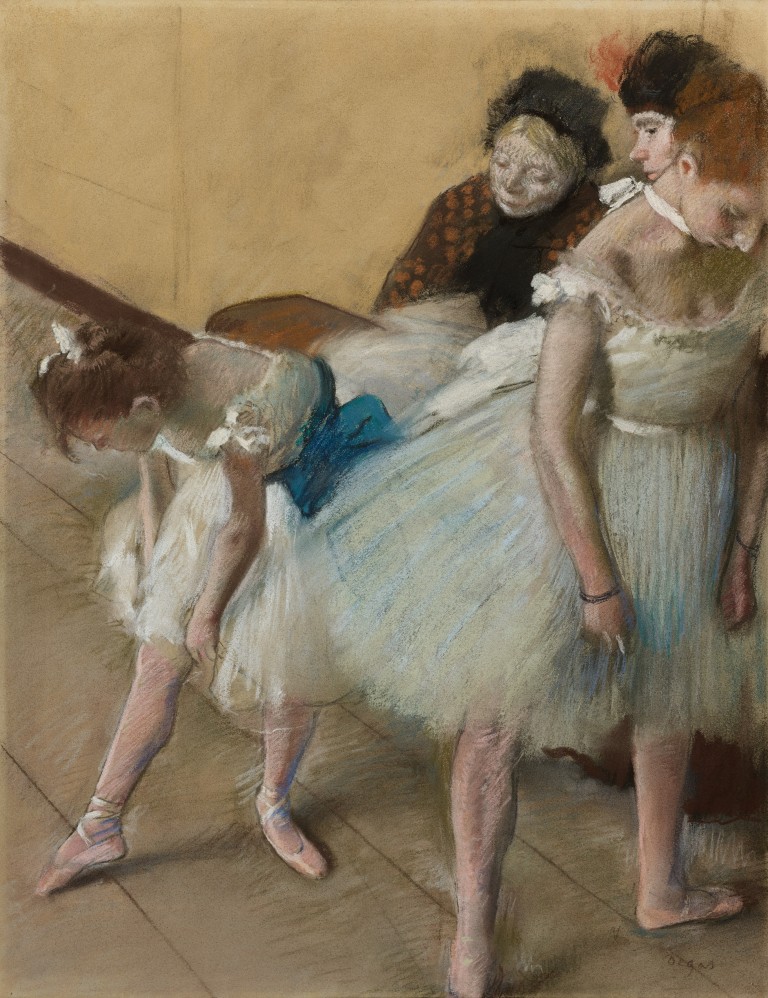
Above, Fig. 1: Edgar Degas (1834–1917), Dance Examination (Examen de Danse), 1880, pastel on paper, 622 x 465 mm, Denver Art Museum, anonymous gift. Photography courtesy Denver Art Museum
The new exhibition at Fitzwilliam Museum, Cambridge (closes 14 January; tours to Denver Art Museum 18 February-20 May 2018) allows viewers to decide what they think of the condition of Dance Examination (1880) [See “Fakes, Falsifications and Failures of Connoisseurship” – Ed.]. The catalogue Degas: A Passion for Perfection includes high-quality illustrations of this pastel and others. This pastel has previously been discussed by Artwatch. Compared to the 1918 photograph there has been noticeable change. It is difficult to ascertain what is due to fading, restorer intervention and variation in photography. Some changes seem clearly evidence of fading. The blue of the bending dancer’s sash is increasingly showing through the white overdrawing of the standing dancer’s dress. The top layer of white is less opaque than it was. The red cockade is less prominent than it was, though why that might be is unclear. Some areas do seem to have been deliberately altered: the wall seems to have been cleaned; the shadow between the leftmost leg of the bending dancer has been streamlined by slimming the wedge of shadow adjacent to the dancer’s other foot (to our right) and making the shadow more uniform; the bench seems to have been smoothed, with some near horizontal lines in the original (in the centre and right) having been blended or over drawn. That said, the new photograph has more contrast than the 2002 photograph, which seems way too pale and lacking contrast, demonstrating that the 2002 reproduction was a poor one. The new photograph suggests that there has not been a determined campaign to retouch the whole drawing but instead very particular instances of alteration (probably early, between photographs one (1918) and two (1949)) combined with fading of particular pigments. The pastel entered the Denver Art Museum collection in 1941.
The Bronzes
Above, Fig. 2: Edgar Degas (1834–1917), Arabesque over the Right Leg, Left Arm in Front, First Study, c.1882–95, coloured wax over a commercially prefabricated metal wire armature, attached to a wooden base, 23.5 x 13.7 x 27.5 cm, © The Fitzwilliam Museum, Cambridge
What makes the NGA’s Degas collection unique is the group of the artist’s original statuettes. These were retrieved from multiple floors of Degas’s last house in the months after his death. The heirs agreed to the figures being catalogued, graded and (if possible) repaired with a view to casting them. Many remains were found to be unsalvageable but 74 items were repaired and cast in bronze in various editions. Exact casting details were not recorded methodically. The majority of original items were in pastiline (like plasticine) over a commercially manufactured articulated wire armature adapted by the artist, which was later coated with pigmented beeswax, which allowed detailed finish, though Degas rarely applied fine details. The exception is Little Dancer Aged Fourteen (1878-81), his famous life-size statue in a real bodice and tutu, which was the only sculpture he publicly exhibited. (The original is now in the NGA collection.) X-rays reveal Degas used clay, corks, paintbrush handles and rags to add bulk to the statuettes and when limbs became detached he would use pins of nails to reattach them. The figures (almost all of them either female figures or horses) were attached to wooden base boards, sometimes with props to support them.
Degas’s attitudes to his statuettes were mixed. He worked hard on them and sometimes showed them to visitors. He kept some in vitrines. Yet he neglected some finished pieces and allowed them to become badly damaged. He never cast any pieces in bronze though he did make notes about foundries; it was apparently his wish that none of the models be cast in bronze.
The restorer(s) of the statuettes who prepared the models for casting approached the task with a mixture of attentive respect and no-nonsense pragmatism. The decision to disregard Degas’s aversion to casting in bronze was a matter for the heirs. The restorer(s) had the practical task of repairing damage, most often in limb breakages. Sometimes the limbs had been fractured, sometimes completely detached. Breaks were repaired and blended with the original facture. Often props on the originals were replaced and completely removed from the casts. (There exists an incomplete photographic record that documents the original statuettes before preparation for casting, showing breakages.) The restorer(s) attempted to preserve as much as possible of the originals but felt no compunction about making alterations to suit the expectations of collectors of the day, including blending their repairs with the original facture. Obviously, the casting process made almost invisible the visible repairs in the original figurines.
In the 1950s the original wax statuettes resurfaced in the foundry. They were purchased by Paul Mellon and most were donated to the NGA. Three original dancer figurines ended up in the Fitzwilliam Museum collection and are included in the current exhibition; the catalogue reproduces x-rays of them, showing the armature and packing inside.
In Facture expert essayists from NGA staff address the chaotic editioning of the bronzes, authorised, unauthorised and possibly pirated. Two foundries cast bronzes from 1920 until the mid-1930s, often as and when demand necessitated new sets. Foundry records are incomplete or suppressed. Two essays in this book study of the construction of the sculptures and various stamps; measurement in millimetres of the exact dimensions of casts and metallurgical analysis suggest the chronology and status of hundreds of the over 1,200 genuine casts. Further sets, which are considered by some to be fakes, continue to circulate. Comparative photographs show differences between casts. These photographs show the variable results of the moulding and casting processes and others which might the work of the finishers.
These volumes (especially the NGA’s Facture) will be essential references for collectors, dealers and scholars in Degas.
Alexander Adams, 3 November 2017
[See also, Alexander Adams: Degas: Themes and Finish. For details of the 2017 James Beck Memorial Lecture (the speaker: Robin Simon – “Never trust the teller, trust the tale”) see A memorial lecture, two journals and an assault on scholarship.]
Leonardo, Salvator Mundi, and an “unusual lapse”
On 20 October, Bendor Grosvenor posted an attack, “’Mystery’ over Leonardo’s ‘Salvator Mundi’”, on a Guardian article written by Dalya Alberge, “‘Puzzling anomaly’ at heart of £75m artwork”.
The Guardian piece had reported my views on the viability of the recent attribution to Leonardo of a damaged and re-restored Salvator Mundi painting (Fig. 3 below) and it had noted the addressing of those views by Walter Isaacson in his new book Leonardo da Vinci ~ The Biography. (My concerns had been published in two – unchallenged – letters to the Times: “Leonardo viewed in a curious light”, 12 November 2011, and “Leonardo enigma”, 12 October 2017. See Fig. 1 below).
Grosvenor carries the following passage from Alberge’s article:
“But in a forthcoming study, Leonardo da Vinci: The Biography, Walter Isaacson questions why an artistic genius, scientist, inventor, and engineer showed an ‘unusual lapse or unwillingness’ to link art and science in depicting the orb.
“He writes: ‘In one respect, it is rendered with beautiful scientific precision…But Leonardo failed to paint the distortion that would occur when looking through a solid clear orb at objects that are not touching the orb.’
“‘Solid glass or crystal, whether shaped like an orb or a lens, produces magnified, inverted, and reversed images. [See Fig. 4 below] Instead Leonardo painted the orb as if it were a hollow glass bubble that does not refract or distort the light passing through it.’
“He argues that if Leonardo had accurately depicted the distortions, the palm touching the orb would have remained the way he painted it, but hovering inside the orb would be a reduced inverted mirror image of Christ’s robes and arm.”
Grosvenor then contends that:
“All of which might lead you to believe that Isaacson did not think the painting was by Leonardo, or at least was raising serious questions.”
In so claiming, Grosvenor seemed to have overlooked this further passage in which Alberge reports a conversation she had with the author:
“Isaacson said Leonardo filled his notebooks with diagrams of light bouncing around. So did he [Leonardo] choose ‘not to paint it that way, because he thought it would be a distraction…or because he was subtly trying to impart a miraculous quality’.”
That passage correctly indicates that Isaacson was genuinely perplexed as to why Leonardo had on that occasion not painted in a way that might have been expected, given his great interest and passion for optical laws. It did not say that Isaacson himself had concluded that Leonardo had not painted the picture. However, Grosvenor adds:
“But on his Facebook page, Isaacson writes: ‘Just to be very clear, this article leaves a bit of a false impression. In my new book, I state clearly and unequivocally that the painting of Salvator Mundi is by Leonardo. And I explore the reasons that he did not show the crystal orb distorting the robes of Christ. I say it was a conscious decision on Leonardo’s part. I do not say in my book, nor did I say in the interview, nor do I believe, that anyone but Leonardo painted this painting. I believe he made a decision to paint the crystal orb in a way that is miraculous and not distracting. All of the experts I know agree, from Martin Kemp to Luke Syson.’”
It is not the case that all Leonardo experts endorse the Leonardo attribution. Nor is it apparent why Isaacson might have felt impelled to make such a “lawyered-sounding” statement over what he feared might at most be “a bit of a false impression” but Grosvenor seemed to relish the fact of it:
“So that’s that; nothing to see here. And please don’t be at all persuaded by the attempt, elsewhere in the article, to use Wenceslaus Hollar’s engraving of the Salvator Mundi to cast doubt on the painting. It has been suggested that because the engraving shows some small, in some cases actually imperceptible, differences to the painting at Christie’s, then the painting at Christie’s might not be the painting which was engraved. This is fantasy art history. First, such differences reflect more on Hollar’s ability as an engraver than the painting. Second, compare other examples of Hollar’s engravings with the paintings to which they relate and you will see that he regularly altered aspects of the composition. Third, we cannot know how long Hollar had to study the original. Finally, Hollar saw the painting more than one hundred years after it was painted. Who knows what might have happened to it in that period?”
Grosvenor’s strained disparagement of Hollar’s engraved testimony (“small, in some cases imperceptible”) alludes to quoted remarks of mine in the Guardian article and to my 12 October Times letter (“Leonardo enigma”). Coming as this does from a man who has likened himself to a Mozart among Salieris in the art dealing, sleeper-hunting community, it may require a response consisting of the very clearest visual evidence. Such will follow in a later post. Here, it might be noted that although my position is certainly not shared by Isaacson, it was not disparaged by him in his book. To the contrary, during his interview for the Guardian article he generously acknowledged having been prompted by my views to raise the very question of why Leonardo might have painted the orb in such a strikingly unexpected fashion. In addition, he cited our 12 June 2012 article “Could the Louvre’s ‘Virgin and St Anne Provide the Proof that the (London) National Gallery’s ‘Virgin of the Rocks’ Is Not by Leonardo da Vinci?”. (See Fig. 2 below.)
CODA – Walter Isaacson on the Salvator Mundi in his Leonardo da Vinci ~ The Biography:
“There is, however, a puzzling anomaly in the painting [see Fig. 3 above], one that seems to be an unusual lapse or unwillingness by Leonardo to link art and science. It involves the clear crystal orb that Jesus is holding. In one respect, it is rendered with beautiful scientific precision. There are three jagged bubbles in it that have the irregular shape of the tiny gaps in crystal called inclusions.
“Around that time, Leonardo had evaluated rock crystals as a favor for Isabella d’Este, who was planning to purchase some, and he captured accurately the twinkle of inclusions. In addition, he included a deft and scientifically accurate touch, showing he had tried to get the image correct: the part of Jesus’ palm pressing into the bottom of the orb is flattened and lighter, as it would indeed appear in reality. But Leonardo failed to paint the distortion that would occur when looking through a solid clear orb at objects that are not touching the orb. Solid glass or crystal, whether shaped like an orb or a lens, produces magnified, inverted, and reversed images. Instead, Leonardo painted the orb as if it were a hollow glass bubble that does not refract or distort the light passing through it. At first glance it seems as if the heel of Christ’s palm displays a hint of refraction, but a closer look shows the slight double image occurs even in the part of the hand not behind the orb; it is merely a pentimento that occurred when Leonardo decided to shift slightly the hand’s position. Christ’s body and the folds of his robe are not inverted or distorted when seen through the orb. At issue is a complex optical phenomenon. Try it with a solid glass ball [see our demonstration at Fig. 4 below]. A hand touching the orb will not appear to be distorted. But things viewed through the orb that are an inch or so away, such as Christ’s robes, will be seen as inverted and reversed. The distortion varies depending on the distance of the objects from the orb. If Leonardo had accurately depicted the distortions, the palm touching the orb would have remained the way he painted it, but hovering inside the orb would be a reduced and inverted mirror image of Christ’s robes and arm.
“Why did Leonardo not do this? It is possible that he had not noticed or surmised how light is refracted in a solid sphere. But I find that hard to believe. He was, at the time, deep into his optics studies, and how light reflects and refracts was an obsession. Scores of notebook pages are filled with diagrams of light bouncing around at different angles. I suspect that he knew full well how an object seen through a crystal orb would appear distorted, but he chose not to paint it that way, either because he thought it would be a distraction (it would indeed have looked very weird), or because he was subtly trying to impart a miraculous quality to Christ and his orb.”
Michael Daley, 23 October 2017
A memorial lecture, two journals and an assault on scholarship
‘Never trust the teller trust the tale’, cautioned DH Lawrence. He meant: don’t pay attention to what anyone tells you about a work of art, not even the artist; nor, we might add, a ‘curator of interpretation’. Study it yourself. But can we always trust the evidence of our own eyes?
THE ANNUAL JAMES BECK MEMORIAL LECTURE: ‘Never trust the teller trust the tale’
On 7 November the ninth annual ArtWatch International James Beck Memorial Lecture will given by Robin Simon and held in Burlington House, Piccadilly, London, W. 1. Robin Simon is Honorary Professor of English at University College, London, and the editor of The British Art Journal, which esteemed publication has launched an attack on the prohibitively high fees that museums now charge scholars for reproducing works of art – even when, as often, these are publicly owned and out of copyright – in their publications and lectures (- see below “A licence to print money, a licence to kill scholarship, at the Tate, the British Museum and the National Portrait Gallery”). His recent books include Hogarth, France and British Art and (with Martin Postle) Richard Wilson and the Transformation of European Landscape Painting. Professor Simon writes:
‘Never trust the teller trust the tale,” cautioned DH Lawrence. He meant: don’t pay attention to what anyone tells you about a work of art, not even the artist; nor, we might add, a ‘curator of interpretation’. Study it yourself. But can we always trust the evidence of our own eyes?
Above, Mars chastising Cupid by Bartolomeo Manfredi (1582–1622), 1613. Art Institute of Chicago.
For details of the (evening) lecture and tickets, please contact Helen Hulson at:hahulson@gmail.com.
THE ARTWATCH UK JOURNAL AND THE PROCEEDINGS OF THE 2015 CONFERENCE ‘ART, LAW AND CRISES OF CONNOISSEURSHIP’
Later this month we publish the ArtWatch UK members’ Journal No. 31. It comprises 112 pages and contains the full and illustrated proceedings of the 5 December 2015 conference “Art, Law and Crises of Connoisseurship” organised by ArtWatch UK, the Center for Art Law, New York, and LSE Law – see below. It will be followed in December by issue No. 32, a special edition on Michelangelo. The ArtWatch UK Journal, is not sold but is distributed free to all members. For membership details please contact Helen Hulson at: hahulson@gmail.com.
A LICENCE TO PRINT MONEY, A LICENCE TO KILL SCHOLARSHIP, AT THE TATE, THE BRITISH MUSEUM AND THE NATIONAL PORTRAIT GALLERY
The British Art Journal (XVIII, 1 2017) editorial in full:
Compare two statements, beginning with the National Gallery of Art, Washington:
NATIONAL GALLERY OF ART. OPEN ACCESS POLICY FOR IMAGES OF WORKS OF ART PRESUMED IN THE PUBLIC DOMAIN.
‘With the launch of NGA Images, the National Gallery of Art implements an open access policy for digital images of works of art that the Gallery believes to be in the public domain. Images of these works are now available free of charge for any use, commercial or non-commercial. Users do not need to contact the Gallery for authorization to use these images. They are available for download at the NGA Images website (images.nga.gov).’
Now the Tate:
‘One of Tate’s core goals is to promote enjoyment of, and engagement with, art and artists within our collection, to audiences wherever they are in the world. As part of this, we are releasing some of our Archive collection digital content and some items from our main Collection for use for non-commercial and educational purposes under a Creative Commons CC-BY-NC-ND 3.0 (Unported) licence. The aim is to provide a simple, standardised way to grant copyright permission for the use of Tate’s intellectual property (its photography) and artists’ creative work for specific uses only, whilst safeguarding Tate’s own income from its IP in commercial contexts whilst ensuring artists, copyright holders and Tate get credit for their work and are protected by law.’
And so what, then, is ‘commercial’ use? The Tate begins:
‘Creative Commons defines commercial use as “reproducing a work in any manner that is primarily intended for or directed toward commercial advantage or monetary compensation”.’
Unfortunately for the Tate, this does not suit it at all, since no-one could argue that academic work in particular is ‘primarily intended for or directed toward commercial advantage or monetary compensation’. If it were to be excluded, the Tate would not be able to seize fees for the vast majority of publishing about its collections. And so it simply invents its own definition, even while still invoking the Creative Commons licence, bringing academic (and indeed any other) work within ‘commercial use’, as follows:
‘Tate further defines commercial use… [our italics] [as] use on or in anything that itself is charged for [! our exclamation], on or in anything connected with something that is charged for, or on or in anything intended to make a profit or to cover costs [we are running out of !s]… Tate would usually regard the following uses of Tate imagery as commercial activity: use online or in print by commercial organisations, including (for the avoidance of doubt) trading arms of charities; use on an individual’s website in such a way that adds value to their business, or for promotional purposes, or where offering a service to third parties; use of images by university presses [we can afford one more !] in publications online or in print; use in publicity and promotional material connected with commercial events; unsolicited use of images by news media, including front covers and centre-page spreads; use in compilations of past examination papers; use by commercial galleries and auction houses.’
And so any publication, however useful to the Tate in expanding public knowledge and understanding of works in the collection, if it is to avoid the hefty fees that the Tate imposes, must needs be handed out free and never, ever, published by a university press… This attitude is disgraceful. Alas, the British Museum, which under Neil MacGregor and Antony Griffiths had a praiseworthy free use of images in Prints and Drawings, has followed the Tate’s lead and now invokes a Creative Commons licence with the purpose of imposing reproduction fees, as does the National Portrait Gallery.
The Tate has given up on attempts to assert copyright in works of art that are actually out of copyright, and instead asserts that it is now, rather, protecting the copyright of its photographs of those works, defining them as its ‘intellectual property’ (IP) in what is meant to be a nifty sidestep. That cannot, however, avoid the fact that, as we have pointed out in these pages, this is unsound in law, in view of the purely mechanical nature of the image-recording operation. Fascinatingly, the NPG seems to have a different understanding of the matter, asserting in a letter in response to an enquiry about it:
‘The National Portrait Gallery owns the copyright of the majority of the images in its collection. Even if an image is “out of copyright”, as it is still part of the collection of the National Portrait Gallery, then copyright continues to be managed by the Gallery.’
This runs directly contrary to copyright law defined in the NPG’s own ‘Introduction to copyright’, as follows:
‘Under the UK Copyright, Designs and Patents Act 1988 (as amended), copyright protects original literary, dramatic, musical and artistic works; films; sound recordings; broadcasts and typographical arrangements… Copyright usually lasts for the creator’s lifetime, plus the end of 70 years after their death.’
Precisely. We note that works under copyright must be ‘original’ in UK law. But the photographs of works in these collections, if they are to the job they are required to do, must needs exclude originality and remain precisely faithful to, yes, the original works – most of which are, of course, out of copyright.
The adoption of Creative Commons licences has nothing to do with the law of copyright in the UK. It is simply a device adopted in order to allow the museums to continue to charge for the reproduction of out-of-copyright works of art in their care, which, moreover, belong to the public they are charging for use. There seems, frankly, no good reason for this restrictive practice if these museums are indeed concerned, as the Tate puts it, ‘to promote enjoyment of, and engagement with, art and artists’. Could it be, then, that its purpose is to perpetuate the employment of the gallery staff who collect the money? Any fees collected will be largely cancelled out by costs: salaries, administration, office space, equipment, pensions and so on. Any profits are likely to be minimal and of no real help to the institution: but they are obtained at the greatest possible cultural and educational cost.
For a museum that is not a profit; it is a loss.
For whose benefit do these museums exist? Do they exist for the benefit of the staff who run them or for that of the public and the world of knowledge they were created to serve? Do they aim to enhance knowledge of their collections? If so, why do they go out of their way to penalize any publication or form of dissemination of images that does that work for them? The use of images of works of art in ‘news media… front covers’ or even on biscuit tins, bathmats or shower curtains, all serve the same purpose, which, to repeat, the Tate defines as ‘to promote enjoyment of, and engagement with, art and artists’.
Strange to say, these ‘Creative Commons’ licences originate in the USA where, however, the position, as set out by the NGA above, is clear and simple, and directly contrary to that of these UK museums. No wonder the Tate has to add so many subordinate clauses and pseudo-legal assertions to the provisions of the Creative Commons licence it invokes.
It would be a far, far better thing if these pointlessly rapacious museums in the UK adopted a different, transatlantic, model: that of the National Gallery of Art in Washington and of countless other museums throughout the USA. What are they afraid of?
And who pays for digitizing their images? It so happens that the Paul Mellon Centre for Studies in British Art handed out it largest ever grant, £500,000, to the British Museum to digitize its British drawings, surely not with the intention that the museum might now charge for their use. The Mellon Centre’s parent institution is the Yale Center for British Art – where images of artworks in the collections are offered free for any purpose.
To return to the Tate… If, say, you look up Arthur Melville on the Tate website you will find that his biography, far from being written by a curator, as one might hope, is simply a link to Wikipedia. By what right? Yes, by yet another Creative Commons licence which, luckily for the cynical Tate, states on the Wikipedia site that anyone may ‘share… copy, distribute and transmit the work… for any purpose, even commercially.’
Now that sounds like a sensible licence.
Michael Daley, 17 October 2017
The (not so-new) latest New Leonardo Discovery
On 29 September it was widely reported that researchers at the Louvre now believe that a drawing at the Musée Condé in Chantilly – the so-called “Joconde nue” – to be Leonardo’s lost preparatory nude study for the Mona Lisa.
The claimed discovery seemed bold and unleashed global coverage – see, for example, the BBC’s ‘Mona Lisa nude sketch’ found in France, National Geographic’s ‘Nude Mona Lisa’ Sketch May Have Been da Vinci’s, and Fortune’s ‘Historians Think They’ve Found a Nude Drawing of Mona Lisa’
In reality, this latest New Leonardo Discovery is a warm-up of an old, on-the-record, attribution. In 1988 Jacques Franck, the art historian/painter trained in Old Master techniques (and a current restoration adviser to the Louvre), had closely examined the Joconde nue in the Château of Chantilly along with Amélie Lefébure, former Head curator of the Musée Condé, and Dominique Le Marois, a restorer in the French museums. At that date the drawing had long been considered the work of an anonymous Leonardo imitator and contemporary but on close visual examination Franck concluded that it was mostly executed by Leonardo and he advised the then director of the Chantilly Estate, Prof. Germain Bazin, accordingly. His (written) ascription was accepted by leading Leonardo specialists, including Profs. Bazin and René Huyghe.
Above, Fig. 1: Here attributed to Leonardo da Vinci, Joconde nue, c. 1500-1506 ?, black chalk on brown prepared paper, 72 x 54 cm. Chantilly, Musée Condé, Inv. 32 (27).
Above, Fig. 2: a detail of Joconde nue (as published showing prick marks when the design was transferred for use on panel.)
Because the Joconde nue had been heavily retouched over the centuries and rendered barely legible in many sections, some thought it necessary that it be subjected to a wide range of forensic tests. This was rejected by Prof. Bazin for fear that, should the work be widely accepted as a true Leonardo, it would then undergo a drastic and likely harmful cleaning. Although forensic investigations have improved significantly in the last thirty years, that risk remains. On his personal recollections of the sheet and in the light of the restorer M. Le Marois’s alarming and still extant 1988 condition report, Franck now fears that an essentially technical underpinning of the Leonardo ascription will prompt further and more invasive technical interventions. He tells AWUK:
“The Joconde nue’s authentication by scientific means will be quite a challenge to the Louvre’s laboratory. For sure they will be able to check the paper and date it correctly, yet the materials in themselves cannot establish that the drawing is the work of Leonardo himself as opposed to that of a close disciple. The composition has been considerably harmed by apocryphal retouchings and the pricking for transfer onto a panel to get an oil painting out of it [See Fig. 2 above and Fig. 5 below]. Further, at a later date, possibly in the 19th century, some thick aqueous paint was applied to the background in order to conceal various alterations (stains, rings, etc.). As a result, many of the forms are hardly legible in terms of Leonardo’s artistic standards.
“The brutal interference of the alterations with the impalpable modelling on which Leonardo’s overall drawing is based has grossly denatured it. When I realized this, I intended to clean the work ‘virtually’ by reconstructing the drawn composition as closely as possible to what it had once been. The task would have been huge but this reaffirmation of my conclusions on the drawing’s status provides a compelling and urgent occasion for that task to be undertaken soon. The growing conceit of restorers that they can recover original states that have been largely subsumed within alien and deleterious additions has repeatedly been shown to be foolhardy with Leonardo.”
As in 1988, the authenticity of the Chantilly cartoon should stand or fall today on the strength of its aesthetic force and originality, which is to say: as seen by eye and not on the basis of some technical analysis of the drawing’s component material innards. Nearly three decades ago Jacques Franck felt that he had seen enough with his trained draughtsman’s eye to make a firm ascription to Leonardo (as was reported in letters to the then director) and today he recalls that:
“Besides the characteristics of Leonardo’s late style visible in so many chalk drawings (either red or black), kept notably in the Queen’s collections at Windsor, what struck me at once was the hands. Their execution reminded me of the underdrawing of the Mona Lisa’s own hands in the Louvre picture as revealed in infrared light [See Figs. 3, 4, 6, 7 and 8]. Although such forensics weren’t as developed in 1988 as they are now, at the time the extant infrared images of the Mona Lisa [see Fig. 7 for a more recent image] were defined well enough to help my eye notice that extraordinary resemblance between the painted and drawn hands at first glance. Leonardo had clearly used a very fine brush to trace the contours of the fingers in the cartoon and the painting, hence the thin outlines to be seen in the fingers in both. This similarity isn’t mere chance, it simply means that the hands and, of course the rest of the cartoon is indeed a Leonardo work. Also, the Joconde nue’s forefinger was obviously longer at the outset [Figs. 7 and 8] but Leonardo changed his mind and reduced its length afterwards using wash, exactly as it is in the Louvre picture now. A crucial pentimento probably meaning that the Chantilly cartoon preceded the painted version of the famous portrait.”
Above, Fig. 3: (left) Leonardo da Vinci, Studies of hands, c. 1480-81, silver-point on pink prepared paper, Windsor Castle, Royal Library, n° 12616; (right) a section of Leonardo da Vinci, the Adoration of the Magi, 1480-81, oil on wood panel, 246 x 243 cm. Florence, Uffizi Gallery, Inv. 1890 : n° 1594.
Above, Fig. 4: (left) a detail of the hands of Joconde nue, at Fig. 1; (right) Leonardo da Vinci, Studies of a woman’s hands, c. 1478 (?), silver-point, heightened with white on pink prepared paper, 21. 5 x 15 cm. Windsor Castle, Royal Library, n° 12558.
Above, Fig. 5: (left) Joconde nue; (right) After Leonardo da Vinci, Joconde nue as Primavera, 16th century (?), 89 x 65 cm. Switzerland, private collection (formerly Mackenzie collection).
Above, Fig. 6: a detail of Joconde nue showing prick marks used for transferring the design, and, the artist’s revision and shortening of the index finger.
Above, Fig. 7: (top) the revised right hand of Joconde nue and (bottom), by way of comparison, a circa 2004 Louvre infra-red image (all rights reserved) of the right hand of the Mona Lisa.
Above, Fig. 8: showing (top) the revised right hand of Joconde nue with the first state of the forefinger indicated in red and the revised state indicated in yellow – graphic by Gareth Hawker; (centre) the right hand of Joconde nue and, by way of comparison, (bottom) the right hand of the Mona Lisa as seen in the Louvre infra-red image at Fig. 7.
Michael Daley, 3 October 2017
Mondrian, Schmondrian – another lapse of museum expertise
Another day, yet another herd of museum experts are bitten by a work that should not, on a cursory glance, have been taken as what it purported to be.
Yesterday Nina Siegal reported in the New York Times (‘It Might Have Been a Masterpiece, but Now It’s a Cautionary Tale’) on the mega-embarrassment of museum experts at the Bozar Center for the Arts in Brussels, the Stedelijk Museum in Amsterdam and the Zentrum Paul Klee in Bern, Switzerland, who had all taken on trust a work of unexamined provenance owned by an anonymous private collector who lives in Switzerland. As Ms Siegal puts it:
“What started out as a potentially major cultural discovery now turns out instead to be a cautionary tale about the dangers of presenting works of art owned by private collectors that have not been systematically vetted. In this case, art experts seem to have passed the buck on conducting basic due diligence on the artwork before displaying it as a Mondrian — putting their own reputations on the line because they gave such credence to a private collector.”
It seems that the director of the Stedelijk Museum saw the pretendy Mondrian at the home of the said collector and discussed the possibility of exhibiting it at the Stedelijk – to which museum it was sent for examination. In self-exculpation the museum now bleats in a reported official statement that a) the Stedelijk was unaware of any doubts about the painting’s authenticity – despite the fact that it had twice been rejected by a leading authority on the artist, and, b) that, besides, the task of a museum is: “to promote art, try to show works that are not yet known to the public and in order to do so, build connections with private collectors. It is not the role of a museum to determine authenticity of a work.”
We beg to differ. We would respectfully suggest that it is the first and prime duty of a museum to know its art from its elbow. All museums should look carefully and critically at any work offered on loan and take nothing on trust. In this case the most obvious first step would have been to compare the photograph of the bona fide Mondrian that had been thought lost during the Second World War with a photograph of the newly presented work and see if any differences emerge. We show below the lost Mondrian on the right and its supposedly resurrected self on the left. Is it really so difficult these days for museum experts to see that these two photographic records are not of the self-same work?
Michael Daley, 20 September 2017
23 September 2017, UPDATE. Philip Coucke, a member of the Brussels Bar, writes:
“The Belgian Bozar ‘center of the arts’ paid several thousand euros for a restoration of the fake Mondrian in consideration of the loan. Their lame excuses sound like a politician trying to explain away the inexplicable – ‘We are not a museum’ and we don’t do ‘authentications’. Why would any publicly funded institution pay for the restoration of admittedly ‘unauthenticated’ paintings?”
BOOK REVIEW – “For Our Freedom and Yours”
Don Reynolds, The Art and Life of Andrew Pitynski, Perennial Wisdom Press, 2015, hardback, 536 pp, ISBN: 978-0-9814755-0-9
“A monument is an expressive symbol. A good one, looked at for even a few minutes, will remain in memory for years or even for an entire lifetime. Monuments are the milestones in a nation’s history.” – Andrew Pitynski
Peter Gibbon writes: On Boston Common once stood a gigantic sculpture of gaunt soldiers riding emaciated horses, spears pointed to the sky. The soldiers are Polish partisans resisting Joseph Stalin. A statue of Marie Curie, wearing her two Nobel Prize medals, stands in front of the Bayonne Public Library in New Jersey. The aluminum portrait bust of a proud, sad Frederick Chopin stares at a visitor in an artist’s studio in Poland.
These are just a handful of the 200 sculptures, commemorative medals, and portrait busts created by the Polish-American sculptor Andrew Pitynski that can be found in Donald Martin Reynolds’ splendid and beautifully illustrated new biography, “For Our Freedom and Yours,” The Art and Life of Andrew Pitynski, Portrait of an American Master.
Above: Partisans 1, Andrew Pitynski’s 1979 sculpture, as installed in 2007 at The Silver Line World Trade Center Station, Boston MA.
Reynolds brings to Pitynski a lifetime of studying sculpture, a belief in the importance of monuments, and a commitment to the figure and realism. “Monuments,” Reynolds writes, “when properly celebrated, can become forces within society for the perpetuation of traditions and human values.” To research Pitynski, Reynolds travelled to Poland, interviewed Pitynski’s family and friends, walked through cemeteries, toured battlefields, visited the sculptor’s classrooms and studios, and immersed himself in the craft of shaping the human figure out of metal and clay.
The result is a vivid, often tragic family history, a compelling personal biography, and an odyssey through Poland’s painful past, filled with war, imprisonment, tyranny, and torture. The book is also a celebration of Polish resistance and resilience. It is elegant, nearly 500 pages filled with historical photographs, hundreds of Pitynski’s etchings and charcoal drawings, portrait busts, reliefs, commemorative medals, and monumental sculptures. The endnotes testify to Reynolds’ diligent research, and the detailed explanations of Pitynski’s intricate art demonstrate Reynolds’ critical acumen.
Reynolds starts by telling the fascinating story of how a young man, marooned in Communist Poland, became an artist. Pitynski comes from a distinguished Polish family. Embedded in his DNA are horses, rafting, fishing, Catholicism, and a fierce resistance to Poland’s many oppressors, particularly the Communists who shot Pitynski’s grandmother and captured, imprisoned, and tortured his father. One of the most powerful images in the book is the bronze portrait bust of his father, his face clearly battered by beatings, his gaze stubborn and defiant.
Under Communist rule, Pitynski struggled to get an education and find his artistic voice. An elementary school teacher recognized his talent and a high school principal encouraged his defiance. Though discouraged by Communist officials, Pitynski persisted, remembering, “I knew my day would come when I could speak out through my art.” Eventually, he was admitted to the prestigious Cracow Academy of Fine Arts, which in the words of Reynolds was “…a formal and tangible affirmation of the vitality and continuity of Polish culture…”
At the Cracow Academy, Pitynski learned the craft of bronze casting, studied Polish folk art, took a few lessons from “socialist realism,” and tried to ignore the Communist message he detested. By chance, in 1974 he obtained a visa to America. He remembers: “As I stepped on to that American plane on October 3, 1974, I looked back and smiled to myself. I knew that I would never return to that Poland, to those Communist bastards. And for the first time in my life, I felt really free.”
Pitynski worked in demolition, made contacts, and taught art and sculpture at schools in Princeton, New Jersey, and Greenpoint, Brooklyn. He received commissions and came to the attention of Seward Johnson, America’s foremost artisan/entrepreneur. Johnson founded the International Sculpture Center of Hamilton, New Jersey, and is known for his life-sized sculptures of ordinary people engaged in day-to-day activities. These sculptures can be found in cities all over America. Johnson encouraged Pitnyski to create his monumental partisan statue on the Boston Common. At the end of the Cold War, as Poland moved itself towards independence and self-determination, Johnson commissioned a more heroic version for his sculpture gardens in New Jersey
Pitynski has chosen to represent his nation’s calamity: Chopin’s exile, the 1940 Katyn Massacre of Polish officers and intellectuals by Russia, the deportation of Polish men and women to Siberia, the German and Russian torture chambers, the bitter civil war and underground resistance that continued after 1945.
Simultaneously, Pitynski portrays with painstaking research and historical accuracy his nation’s commitment to resistance and freedom. He also portrays its heroes: Jan Paderewski, the famous pianist who persuaded Woodrow Wilson in 1920 to include an independent Poland in his Fourteen Points; Jan Karski, the Polish resistance fighter, who first alerted the world to the reality of the Nazi death camps; and Pope John Paul who, along with the partisans, helped end Communist rule.
Above: Andrew Pitynski at work on the plaster for Avenger in 1986; below, the bronze and granite Avenger monument at Doylestown, PA, 1988.
Why does Pitnyski’s work matter to Americans? There are Polish Americans living in Greenpoint, Brooklyn; in Doylestown, Pennsylvania; on the Lower East Side of Manhattan; in Chicago’s South End; and spread out in Milwaukee. They and their ancestors fled deprivation and tyranny. They remember Poland’s catastrophic 20th century, offer commissions to an artist who remembers his homeland, and attend the dedication of his monuments.
Pitynski also celebrates Poles who fought for America’s freedom. In medals he celebrates Kazimierz Pulaski, the father of American Cavalry who, as Reynolds notes, wrote to George Washington: “I came here, where freedom is being defended, to serve it, and to live or die for it.” In St. Petersburg, Florida, a bronze, eight-foot high stature of Thaddeus Kosciuszko stands on top of a granite base. An engineer, Kosciuszko designed the fortifications along the Hudson River at West Point. He is portrayed in military uniform, his right arm thrusting forward his famous will in which he leaves his entire estate to the Negroes of America so that they could be free, educated and assimilated. Of Kosciuszko Jefferson said: “He is as pure a son of liberty, as I have ever known and of that liberty which is to go to all, and not to the few or rich alone.” Pitynski reminds us he is engaged in an eternal fight “for our freedom and yours.”
In a cynical age, Pitynski is patriotic, idealistic, and realistic. Where moral relativism is common, Pitynski is didactic and certain. In an art world fond of abstract sculpture, Pitynski is devoted to classical beauty, representation, romanticism, and reality—all making his work arresting and moving.
Donald Martin Reynolds has spent his career describing and appreciating monuments. They are, he insists, a reflection of a society’s values, a preservation of the past, an escape from death, and an inspiration to the living. In Pitynski’s work, he sees “the deeper truths of nobility, patriotism, and loyalty.” In this, Reynolds is describing his own credo.
Peter Gibbon is a Senior Research Scholar at the Boston University School of Education and the author of A Call to Heroism: Renewing America’s Vision of Greatness (Atlantic Monthly Press, 2002). He has directed four Teaching American History programs and is currently the director of an NEH Seminar, “Philosophers of Education: Major Thinkers from the Enlightenment to the Present.”
Don Reynolds gave the 2016 James Beck Memorial Lecture on the art and life of Andrew Pitynski.
25 June 2017.
BOOK REVIEW – A Restoration Palindrome
Noémie Étienne, The Restoration of Paintings in Paris, 1750-1815: Practice, Discourse, Materiality, Getty Publications, 2017, paperback, 302pp + xiv, 35 col./34 mono illus., £45/$69.95, ISBN 978 60606 516 7
Alexander Adams writes: This title does not discuss the actual techniques used by restorers of the period but discusses the way restoration was seen and how business was conducted. The author examines the underlying assumptions of collectors, critics, administrators and restorers at time of great change in French (and European) history.
“A painting cleaned is a painting ruined; a thing to which the dealers never agree, but it is nonetheless true.” So Pierre-Jean Mariette (1694-1774) wrote posthumously in 1851-3. Restoring was a controversial practice even in its early days. “Individuals engaged in some kind of restoration in Paris between 1750 and 1815 were generally also dealers, experts, copyists, or painters. That versatility underscores the breadth and variability of the profiles involved. The activity itself was nurtured by numerous related occupations, such as painting and forgery.” In business directories of the time, the classification of restorers was unclear and changeable. Dealers – initially based near the Louvre but later more widely distributed in central Paris – commonly repainted, retouched, cropped and expanded paintings that passed through their hands and a small community of restorers grew up to support such activity.
Restorers worked for the Louvre, the court and for private collectors. Restorers long maintained secrecy to prevent competition and to avoid criticism, though they were often berated for their secrecy, which began to dissipate in 1802 when the first published description of technique used on a specific art work by the restorer in question. There was a clear conflict here. Museum administrators recognised the right (and necessity) of allowing private craftsmen to conceal their methods from competitors; at the same time the administrators needed to know the safety and permanency of operations being carried out upon museum property.
Renowned restorers such as Robert Picault could command huge sums for work on important pictures, such as Raphael’s St Michael. Despite these triumphs there are cases such as that of a 35,000-franc Rubens painting being reduced in value to 5,000 francs due to Picault’s aggressive overpainting. Restoration sometimes made paintings more saleable, sometimes worthless wrecks.
Only after the Revolution (and then only gradually) did restoration become to be seen as a distinct discipline. The proposed professionalization of restoration practitioners in Paris was complicated by the unclear division between the menial craftsmen who made the panels and stretchers and were more likely to do the work of relining oil paintings and detaching frescoes and the skilled artisans who reserved the prerogative of cleaning, varnishing and retouching the painting surfaces.
Already at this time there was a division between those favouring methods which distinguished between original and restoration and those advocated extensive, invisible in-painting, including invention of absent passages. Bedotti recommended improving works where possible:
“For it sometimes happens to even the most skilful painters to make mistakes that are too gross and too visible. In that case, one must not fear to seek and to remedy, wherever possible, and to improve the painting by eliminating or concealing the most shocking mistakes.”
Others explicitly opposed such intervention, sometimes on the purely aesthetic grounds that retouchings discoloured at a different rate (and in a different way) to the original paint, thus leaving old restored paintings an ugly patchwork of tones.
The more famous the master, the more enthusiastically it was overpainted in order to freshen it. Work on the Raphael St Michael was considered especially egregious, with details repainted. Jacques-Louis David was also critical of restorations to Raphaels, which had subdued the master’s colours. By 1800 the relining process was heavily criticised for flattening impasto and removing the brushstroke, thereby altering the character of paintings.
Attitudes towards cleaning differed. Some said darkening through age, dirt and deteriorating varnish was a patina which imparted special qualities to the art work, mellowing and harmonising colours. Others suggested moderate cleaning, even leaving a light veil of dirt. One writer stated that cleaning was more injurious to a painting than the yellowing of varnish.
Étienne makes the point that the practice of transferring paintings from their original supports to new ones (usually canvas) altered not only the character of the art physically but also conceptually, turning altarpieces, furniture panels and murals into cabinet pictures, moveable chattel. German historian Johann Dominicus Fiorillo wrote “Nothing is independent in an art work; each singular part is bound up in a coherent whole, and that unity and singular internal constitution means that it forms a unit. If one part is destroyed, then only a fragment remains, and the work can never regain its unity.” For the French, a painting consisted of a painted surface and the support was – technical considerations aside – a matter of indifference. Conversely, the dismemberment of altarpieces (common practice in Italy and Belgium) was apparently rare in France.
Political considerations also encouraged the mobility of art in order to make it available in grandes projets of the period – the construction of new museum collections which would centralise newly mobile paintings. When Vivant Denon, director to the Louvre, required works to fill gaps in the museum’s collection, there was a drive to transfer Daniele da Volterra’s Descent from the Cross (c. 1545) from its wall in Rome to a canvas support so it could be taken to Paris. French officials suggested that transfer was the only way to save the work that would surely be damaged or destroyed otherwise – hardly more veiled than an outright threat issued to reluctant Roman authorities. It was indeed detached and damaged but later replaced in situ, the French effort stymied by Italian resistance. The wholesale detachment and transferring of the Sistine Chapel murals was seriously considered.
Paintings were considered decorative in function and so were often altered in shape to fit a new location or to make a group of works conform in size. The author suggests that the Revolution altered perceptions among authorities regarding the function of art. No longer in the new French Republic would art be titillating and comforting decoration but moral, uplifting and didactic. As part of a wholesale reappraisal of Louvre practice in the wake of the Revolution, a review concluded that art works no longer be altered in size. Denon had had a change of outlook and adopted a minimalist approach to restoration.
Étienne describes the hectic rush to clean, re-varnish and frame paintings which had been the spoils of military campaigns in the Low Countries and Italy, in order that they could be exhibited in Paris. These restorations were acts of appropriation, as the French asserted ownership of these trophies. “Restoration work performed on the paintings was part of the process of appropriation of newly arrived items. The reasoning worked as a palindrome: Whoever owns the painting restores it, and whoever restores it owns it.”
This title is not intended as a discussion of practice and illustration is minimal. The notes and bibliography are thorough and there is a full index. There is a general biographical directory of restorers of the period. For anyone studying the history and theory of restoration, Étienne’s book is a fascinating, considered and informative survey with implications for practitioners today.
Alexander Adams, 6 June 2017
Fakes, Falsifications and Failures of Connoisseurship

2017 marks the twenty-fifth anniversary of ArtWatch International and, today, the tenth anniversary of the death of its founder, Professor James Beck. This year, the eleventh anniversary of Beck’s From Duccio to Raphael: Connoisseurship in Crisis, will see the ninth annual James Beck Memorial Lecture (in London) and publication of the proceedings of the 2015 ArtWatch UK, LSE Law, and the Center for Art Law conference “Art, Law and Crises of Connoisseurship” – which examined the crises from the perspectives of artists, scholars, scientists, and lawyers.
During the early 1990s Michelangelo restoration battles we soon saw misattributions and restoration injuries as twinned failures of connoisseurship. Subsequent events confirmed that analysis and vindicated our warnings on toxic attributions [1]. Our recent protracted silence covered studies of the present fakes/connoisseurship malaise and the results will be published during the year.
Above, Figs. 1 and 2: restoration degradations to two Klimt paintings – his Danae of 1907-08, as seen before 1956 and today; and his oil on canvas Portrait of Margaret Stonborough-Wittgenstein, as seen, left in 1905 when not-yet finished and subsequently in 1911, pre-1956 and today.
The starburst of exposed fakes that brought down New York’s (unrepentant) House of Knoedler, embarrassed ancient firms like Colnaghi’s and venerable publications like the Burlington Magazine has also humiliated the Louvre, the National Gallery, the Metropolitan Museum, the British Museum, the Art Institute of Chicago, the Tate, the Galleria Nazionale in Parma, the Van Gogh Museum and the Kunsthistorisches Museum in Vienna. On 11 April the FBI warned there could be hundreds more fakes in circulation in addition to the forty the agency has identified from a single forger who donated works to the Smithsonian American Art Museum, the Los Angeles County Museum, the Museum of Fine Arts, Boston, and the Detroit Institute of Arts. Had the FBI prosecuted the forger Ken Perenyi there might have been as many embarrassments again [2]. The problem of fakes occurs online, on land, and at sea outside of legal jurisdictions, as Anthony Amore has shown in his 2015 compendium of scams, The Art of the Con.
Above, Fig. 3, Klimt’s 1907-08 The Kiss, (detail) as seen before 1956 (top) and today.
With fakes and restoration injuries, the latter are greatly more destructive. Misattributions can be corrected, money can be paid back. However it might be ascribed at a given moment, the work of art – the art object – remains its own prime document (insofar as restorers permit). Sometimes restoration injuries are localised within a work, sometimes they are overall and catastrophic. Successive damaging restorations compound injuries and falsifications irreversibly (as seen above with Klimt and below with Renoir, Degas and Michelangelo). Slow cumulative damages are perhaps more serious than abrupt aberrant mistreatments that draw immediate notice. Scholars who shy from considerations of condition [3] must proceed on the premise that what is today is what originally was – an untenable view given that every restorer loves to undo and redo the works of predecessors but does so at a yet further remove from the work’s original condition and artistic milieu.
RESPONSES TO THE PRESENT ATTRIBUTIONS CRISIS
Responses to the attributions crisis have ranged from panic through self-exculpation and blame-casting to denial and cheerleading assurances of future streams of discoveries from sleeper/hunters. This is not an exclusively art market problem. Its roots are deeper and wider. The market trades objects on what others claim them to be. There has been concern among leading experts over the trade’s capacities of recognition and discrimination because of a precipitate decline in hands-on objects-informed expertise within the academic and museum spheres which have traditionally underpinned market activity [4]. Where Sotheby’s swiftly refunded purchases and took technical precautions, public museums are still flaunting restoration-wrecked pictures [5] and dubious attributions [6]. Much of art historical academia absents itself, fretting over alleged “engendered gazes”, for example, while missing (or disregarding) restoration-wrecked Renoirs and Klimts.
Above (top), Fig. 4, Klimt’s portrait of his niece Helene in 1956 and in 2007. Above, a detail of Klimt’s Judith II (Salome) of 1909, as published in 1956 (left) and in 1985 (Gustav Klimt ~ Women).
Below (left), Fig. 5, a detail of Renoir’s La Loge, as seen in 1921 and in the Courtauld Gallery’s 2008 exhibition catalogue Renoir at the Theatre – Looking at La Loge.
MUSHROOMING MARKETS
Without the cover of museums’ previously thought invincible technical authority, the mechanics of error are suddenly in plain view. To repeat our warnings, three years ago in “Art’s Toxic Assets and a Crisis of Connoisseurship” we wrote:
“‘Buy land’, Mark Twain advised, ‘they’re not making it anymore’. This logic ought to apply to the old masters but does not. Land makes sound investment not only because of its scarcity and its potential for development but because, in law-abiding societies, it comes fixed with legally defendable boundaries… Attributions, however, are neither guaranteed nor immutable. They are made on mixtures of professional judgement, artistic appraisal, art critical conjecture and, sometimes, wishful thinking or deceiving intent. They remain open to revision, challenge, manipulation or abuse… as some buyers later discover to their cost. Buyers are advised in the small print to beware and proceed on their own judgement… few people would dream of buying a house without legal searches and a structural survey.”
Eleven years ago we noted: “…The artists themselves may be dead but their works proliferate. As recently as the 1960s, 250 sheets of drawings were accepted as authentic Michelangelo. Today, over 600 sheets are. Such increases are fed not so much by forgery or the discovery of genuinely long-lost original works (both of which occur) but by a too-ready upgrading of copies, or studio works, to ‘original’ status.” [7.]
Three years ago we warned that buying old master paintings could be riskier than buying second-hand cars and asked for vendors to be required to disclose all that is known about a work’s provenance and restoration history (13 August 2014, letter, the Times – Fig.6, above). At the time we received silence. This month the art market blogger, Marion Maneker, complained (Art Market Monitor, 2 May 2017) that:
“The Financial Times has yet another ‘How Transparent Is the Art Market?’ story written by an announced participant in an upcoming art market regulation conference revealed in the pages of the Financial Times the week before. Considering the amount of interest the FT has shown in regulating the art market, one would expect the international business newspaper to have some proposals about how to police the trade.” See Georgina Adams, “How transparent is the art market”. Where Maneker complained: “The closest the story comes to offering ideas is to compare the art market to the second-hand car market (unfavorably)” Adams had quoted two art world players who so liken the art market:
“The fundamental problem, according to the FBI’s art and antiquities special agent Meredith Savona, is the lack of records of ownership. ‘Even for cars, I can see who owned it for a certain period of time,’ she says. ‘In the art market there is nothing, no regulation. If someone will not tell you who was the previous owner there’s a reason. There needs to be a way of having records maintained for, say 20 or 30 years.’ This chimes with the stand taken by Nanne Dekking, a Dutch entrepreneur whose start-up Artory aims to bring more transparency to the market through catalogue raisonnés and provenance research – ‘In Holland there is a digital registry for second-hand cars – it’s obligatory to register, so if you buy a car you know exactly what you are getting’, he says. ‘…That’s the kind of transparency we’re after.”
In 2013 Dekking was appointed Sotheby’s Executive Vice President and Vice Chairman, Americas after eleven years with Wildenstein & Co. He is a board member of the Authentication in Art group which first welcomed and then rejected a proposed paper we had offered on the flaws of Technical Art History for a forthcoming AiA conference. We see open and freely published debate as a precondition to reforming a system that is proving unfit for purpose.
PROVENANCE RESEARCH
Georgina Adams also reported calls for a levy on art sales to fund independent bodies to establish and maintain standards in the protection of buyers but such suggestions, in our view, are unworkable. The art market is global and increasingly an arena of private/secret transactions. Taxes are levied by governments. How and by whom would levies be collected around the world, pooled and then disbursed? Who would guarantee the independence of such bodies? Would they be national or international and to whom would they be answerable? Would they charge fees to offset their own costs? Less problematic, much cheaper and perhaps more to the point would be for governments to give buyers enshrined statutory rights to be informed about what should appropriately be known when buying a work of art. Presently, vendors enjoy de facto rights not to disclose their identities; not to disclose how often and to what extent works have been made over by restorers.
CONCEALMENT OF IDENTITIES
In 1998 a pastiche Leonardo drawing was put on the market by Christie’s NY as “German School, early 19th century” and “the property of a lady”. When the work was claimed to be a Leonardo worth $200million (as the so-called “La Bella Principessa”) the lady concerned disclosed her identity and brought an action for damages against the auction house on what was only a claimed valuation, not a sale. Only then did we learn that the vendor was the widow of a painter/restorer (of Leonardo, among others) who had been an intimate of Bernard Berenson, helping him to conceal his collection from the Germans during the War, and the drawing’s only known owner. When the new owner, and Professor Martin Kemp, an AiA board member and a leading advocate of the Leonardo attribution, trawled the Berenson archives together in search of an earlier reference to the drawing they drew a blank. The drawing remains without history outside of the studio of the artist/restorer who is said to have restored it. Such is precisely the kind of information to which potential buyers should rightfully be privy.
THE LAW, SECRECY AND MAKING THE BONA FIDE FAKE
When the Art Newspaper examined the legal ramifications of the current crisis (“It’s time the art market got tough on fakes” 2 February 2017) it found no appetite for either external regulation or self-policing and a blithe acknowledgement that bad restorations convert bona fide pictures into effective forgeries:
“At the annual art-crime symposium held in November at New York University, participants agreed that the culprit was the market’s notorious secrecy. But discussions revealed deep divisions about what should be done. Insurers, auction houses, dealers and other players each have their own interests to protect in a market where, as one participant remarked, the ‘level of greed…is so great’.
‘Information is the currency of the art market,’ said lawyer Steven Thomas, the head of the art law practice at the Los Angeles law firm Irell & Manella. He offered an example showing how information was withheld in trying to close a sale. When one of his clients learned that an impressionist painting he was interested in had been restored so extensively it was no longer considered authentic, he confronted the dealer, a prominent New York gallerist. ‘Oh, you found out,’ was the cavalier response. Such is the attitude in a market where the burden of due diligence as a practical matter may fall on the buyer.”
ACKNOWLEDGING RESTORATION INJURIES TO SAVE AN ATTRIBUTION – AND THE PARAMOUNT IMORTANCE OF PHOTOGRAPHIC RECORDS
Secrecy on condition can tempt owners. Duncan Phillips privately admitted that his great Renoir The Luncheon of the Boating Party (detail below, Fig. 7) was so mauled by two pre-eminent restorers that it was rejected as authentic when loaned to the Louvre:
“Fortunately we were able to put them right because our friends had taken the precaution of filming their work on the canvas. I have a copy of the film which you’re welcome to view. In it you’ll notice actual colour stains coming off on the cotton swabs. But please, for God’s sake, don’t report this tragedy. It’s too dreadful.” [8.]
Today one can see on the painting where a colour in one part was introduced into the cracks of another area – and yet Phillips’s widow, Marjorie, wrote in her 1970 memoir Duncan Phillips and his Collection “the Sheldon Kecks, outstanding restorers, operated on the Renoir successfully!” We have asked the Phillips Collection’s director several times to see the film and the painting’s restoration records but always without reply. At the National Gallery, under the directorships of Charles Saumarez-Smith and Nicholas Penny, we were given permission to examine the historic and conservation dossiers of paintings with the kind and helpful assistance of the gallery’s librarians and archivists. In contrast, when we asked to see the records of the Bellini/Titian The Feast of the Gods at the National Gallery, Washington, the conservation department refused outright. A curatorial department was more open and supplied good-quality pre and post-restoration photographs of the painting’s states which enabled us to demonstrate losses of value during the cleaning (as at Fig. 8 below). We learn that a member of the gallery’s conservation staff keeps more sensitive photographic records at home for fear that they “might fall into the wrong hands”.
Above, Fig. 7: a page in the Autumn 2007 ArtWatch UK Journal published in memory of James Beck who died on 26 May 2007. In the same journal we published a comparison of a detail of the Feast of the Gods, as taken before cleaning (left) and after cleaning but before repainting – see Fig. 8, below:
SPURIOUS CONSERVATION SCIENCE
Above, top, Fig. 9: a detail from the National Gallery’s Renoir The Umbrellas before cleaning (left) and after cleaning in 1954. Below, Fig. 10, the face, after cleaning and restoring.
It should be clear to any scholar or connoisseur of paintings that the National Gallery cleaning was injurious, that the picture’s values and relationships were degraded and deranged – and yet the technical promises underpinning the restoration were “top-of-the-range” and authoritative. Cleaning was preceded by a physical and a chemical analysis of the painting by two gallery scientists who concluded that an “extremely thin” natural resin varnish could safely be removed “by solvents of a strength well below that likely to attack the paint film, which is resistant to the solvent action of pure acetone.” The scientists offered an additional assurance: “In the hands of a competent restorer [Norman Brommelle, husband of the National Gallery’s head of science, Joyce Plesters, was chosen] there is no reason to fear that the paint layers will be disturbed in the course of cleaning. Since, in this particular picture, there is no evidence of a linoxyn film, nor the presence of any resin in the medium, there is, in our opinion, no need to adopt any special precaution.”
Brommelle reported that the varnish was removed with a 3:1 turpentine/acetone mixture containing a small percentage of diacetone alcohol and that the last traces were removed with toluene but no one explained why an extremely thin varnish layer of no great antiquity needed to be removed. The cracks seen above at Fig. 10 were products of the cleaning (some local cracking had occurred previously where the canvas vibrated against a central stretcher bar on its regular exchanges between London and Dublin. (Technical information by courtesy of the National Gallery Conservation Department.)
THE TECHNICAL AND SCHOLARLY UNDERWRITING OF A FAKE AT THE NATIONAL GALLERY
One of the recently disclosed fakes, an “Orazio Gentileschi” (above right at Fig. 11 next to an authentic work), had been accepted by the National Gallery on a loan from its owner. When the now rejected no-history painting was withdrawn, the gallery justified its inclusion with the claim (Antiques Trade Gazette): “The gallery always undertakes due diligence research on a work coming on loan as well as a technical examination.” After this historical and technical examination, the Gallery label declared that “the poetic depiction of ‘David Contemplating the Head of Goliath’” had been produced by Gentileschi “for a collector’s cabinet” – an unsupported claim that, like “made for private devotion”, often serves as a flag of convenience for small recently-discovered old works without histories.
Above, Fig. 12, here we see a detail (top left) of the real Gentileschi David and (top right and below) the loan accepted as authentic by the National Gallery. If, instead of whatever technical and art historical examinations were carried out, the Gallery had run a few simple photo-comparative checks of the kind shown here, it should have been obvious to anyone with an alert eye that the picture in the top left had been the bona fide historical prototype for the other, markedly inferior and modern-looking, version. Qualitatively, they are not remotely co-equals: the one is a crude pastiche of the other. In every detail the chasm of quality should have identified the loan as a pastiche.
THE CONSEQUENCES OF (UNACKNOWLEDGED) RESTORATION INJURIES
Although this impostor has now been rejected from the National Gallery there is no redress for individual badly restored bona fide works – and often not even an acknowledgement of their plight. Nor is there any apparent means of stemming the swelling tide of destruction that masquerades as a conservation service while delivering incremental degradations of pictures, such as those that can be shown to have taken place in less than a century on what is now the Denver Art Museum’s Degas’ superb pastel and charcoal The Dancing Class or Dance Examination of 1880 below at Fig. 13. The first photograph in the sequence was published in 1918 (Degas, Paul Lafond) when the drawing was not yet forty and therefore likely to have been in an original or near-original state. The third photograph was published in 2002 in the catalogue to Degas and the Dance, a sponsored travelling exhibition organised by the American Federation of Arts (- the “the prime movers”), the Detroit Institute of Arts, and the Philadelphia Museum of Art. The show was curated by the leading Degas specialists Richard Kendall and Jill Devonyar.
The sequence of states at Fig. 13 above resembles a succession of an etching’s proof states in reverse: the most complete condition is seen in the oldest record and the most debilitated state is recorded most recently. If we make the most direct comparison with the earliest and the most recent records of this drawing, as at Fig. 14 below, the differences become startling and heartbreaking. What happens to one artist happens to all in turn, as was most shamefully seen to Michelangelo at the Sistine Chapel – see Fig. 15 where an early Anderson photograph of a lunette is shown with its post-restoration state. By such simple comparative means we can see/demonstrate that Degas and Michelangelo have not been restored or conserved so much as subjected to a cultural pathology – an infantile revulsion at or terror of darkness and a failure to appreciate that darkness, as artists appreciate, confers brilliance and radiance. Without shadows to relieve lights there is no great vivacity – art’s life-affirming gift. Our historic cultural legacy is being made over into a blander, more homogenised arbitrary colourfulness. With so much value and vivacity already lost in the Dance Class’s first century, who, if offered the chance, would today vote for “More of the same, please” in the next? Restorers can never put the clock back. They can only offer more of the same: yet further intensifications of hue and losses of form and space-creating tones.
THE INCALCULABLY VALUABLE TESTIMONY OF PHOTOGRAPHS
Photographic reproductions do not have to be taken as absolutely faithful replications to have great value as record – why else would they be published and consulted in such great numbers? They are particularly eloquent as witnesses when seen in company with predecessors and successors, because the patterns that successive images make disclose the truth about present conditions. The net consequence of restorations during the last much-photographed century can be seen/shown to have been gravely damaging, effectively washing away art’s pictorial strength, disrupting the internal relationships of individual works, rendering oeuvres capriciously erratic and incoherent and, thereby, creating spaces, opportunities and, even, seeming precedents for misattributions and outright fabrications.
COLOURS V TONES
Although we do not have a colour photograph to match the black and white Durand Ruel photograph published in 1918, we can, by juxtapositions, estimate the degrees of loss today. At Fig. 16 below, the top comparison shows that the bump on the head of the woman in the upper right-hand corner was formerly a red feathery hat decoration. It now survives as a smear of colour that, tonally, is almost indistinguishable from the wall behind. We can see in the greyscale comparison at the bottom that the red decoration had originally been given a halo. On his own declared pictorial statagems, we might deduce that Degas had used the pocket of red to create a triad of local counterpointing primary colours: red feathers, ochre spots and an intense dark blue ribbon bow. Certainly, speculations aside, since that date the ineffably soft back of the standing dancer’s tutu has both hardened and become see-through. The feathered, layered back of the bending dancer’s tutu has, on some bizarre and alien tidy-minded logic, been reduced a ghostly but sharp-edged right angle. Degas is leaving us, involuntarily. He learnt and extracted much from photography. Is it too much to ask that all scholars use our very great resources of photography and historic photographic evidence to calibrate the injuries done to his oeuvre and therefore more fully appreciate and give due account of Degas’ great and supremely fresh and audacious genius?
Certainly, the most urgent single reform needed in today’s crisis of connoisseurship lies in increasing the accessibility of photographic records of condition and treatments. In an age of electronically transmissible, high quality photographic images this would be easier to achieve and more instructive than ever before. There are no good reasons for institutions, owners and dealers continuing to sit on such material and thereby prevent people from seeing what’s what.
Michael Daley, 26 May 2017
Coming next: Degrading Degas and Michelangelo
ENDNOTES:
[1] We first used the term in connection with the so-called Stoclet Madonna, the Metropolitan Museum’s attributed Duccio, in “Toxic Attributions?” The Jackdaw March/April 2009.
[2] “In the end, after a five-year investigation and a mountain of evidence collected, no one, neither the two ‘conspirators’ nor I, was ever charged with a crime or indicted” – so wrote Ken Perenyi, in his 2012 memoir Caveat Emptor, p. 312.
[3] One scholar who has engaged on this territory with his pioneering book Condition:The Ageing of Art, Paul Taylor, incurred immediate wrath from some restorers who would claim monopoly rights on all discussions in the field, but a firm welcome elsewhere. Apollo noted that “There are unquestionably many art critics and even academic art historians for whom the material context of art, and particularly flat art, has become a rarefied field. That needs to change, if we are not to see total severance between those who work to preserve physical objects and those who claim to construe their meanings.”
[4] In a paper delivered at the ArtWatch UK/LSE/Centre for Art Law December 2015 conference (“Throwing the baby out with the bathwater”), Brian Allen, a former director of the Paul Mellon Centre for Studies in British Art (1992 to 2012) and Chairman of the Art Fund observed: “…increasingly, the only young connoisseurs emerging are to be found in the commercial art trade and this surely cannot be a desirable state of affairs. It might be argued that many of the best ‘eyes’ have always been in the art trade but, until recently, there was always a body of disinterested academic ‘experts’ to counterbalance commercial self-interest…” In the March 2017 Art Newspaper, Anna Somers Cocks, the paper’s Chairman and a former curator at the Victoria and Albert Museum, discloses that the V&A now considers the giving of opinions a drag on its curators’ time and devotes only three hours a month to it when, in the 1990s, it reserved two afternoons a week to telling the public what their heirlooms were. In the same issue of the Art Newspaper Mark Jones, a former director of the Victoria and Albert Museum, said that expertise, by which he meant “the ability to recognise and identify objects, surmise their history from their appearance, tell the genuine from the false and make judgements about quality” has become patchy, even rare, in museums. Mark Jones was the curator/organiser of the British Museum’s legendary 1990 exhibition “Fake? The Art of Deception”, the catalogue of which remains a seminal study in the field.
In response to Mark Jones the dealer Peter Nahum wrote in the April 2017 Art Newspaper (letter, “Dealers and curators should work together to spot fakes”):
“The art forger Shaun Greenhalgh and his father George visited my gallery in 1984. It was after 6pm and they offered me a painting they said was by Samuel John Peploe, for which I gave them a cheque. As soon as the banks opened at 9am the next morning I cancelled the cheque and called in the police. I was the first to report the family from Bolton for purveying a fake, 16 years before their arrest.
“When they were finally arrested, my cheque was still on their desk. I also advised Bolton Museum on the purchase of the painting by Thomas Moran and subsequently saved them from buying a fake watercolour purportedly by the same artist.
“I have long campaigned for the art and antiques trade and academics, especially those in museums, to work more closely together. Our job, as dealers, is to defend our clients against the legion of fakes and wrongly catalogued items on the market. As we are personally financially responsible for all transactions we make and advise on, we are the most vulnerable and, by necessity, the most careful. As a result we are often best placed to authenticate works.
“Academies and museums obviously have great experts on their staffs, but their prime focus is the history and provenance of objects and thus their visual skills often take a secondary position. When both professions work together, mistakes are lessened.
“I have made it my mission to track down and report those who make fake art, as they are the bane of our lives and can cost those who buy art a great deal of money. They are simply con-men extracting money from innocent people by deceit.
“As dealers, academics and collectors, we are all motivated to push the boundaries of our knowledge, and thus all of us are vulnerable to those who wish to take money under false pretences. We have to be constantly on our guard as each one of us will fall into one of the fakers’ traps sooner or later – we are all human after all.
“Thus, I applaud Mark Jones’s article: scholarly research is flourishing but curators’ ability to judge an object’s quality is not (The Art Newspaper Review, March, p.13) with two main comments. The painting by Samuel John Peploe was not sold, and academics have rarely been the greatest visual judges – that is more our job than theirs. That does not mean that there are not great visual experts in academia – of course there are – it simply means it has never been their primary function.
Peter Nahum.
Peter and Renate Nahum Agency (the Leicester Galleries), London.”
[5] See “From Veronese to Turner, Celebrating Restoration-Wrecked Pictures” and “Taking Renoir, Sterling and Francine Clark to the Cleaners” and THE ELEPHANT IN KLIMT’S ROOM and, finally, “Now let’s murder Klimt”.
[6] The National Gallery includes one of its most dubious and controversial attributions – the Rubens Samson and Delilah – in its list of 30 “must-see” pictures. There are more than twenty secure and superior works by Rubens in the gallery including the magnificent Minerva protects Pax from Mars (‘Peace and War’). When controversy broke over the attribution in 1997 the gallery’s director, Neil MacGregor, placed a statement next to the painting to explain why it looked like no other Rubens in the collection. Two special issues of the ArtWatch UK Journal have been devoted to this picture’s problems. See: “The Samson and Delilah ink sketch – cutting Rubens to the quick” and “Art’s Toxic Assets”
The National Gallery’s highlights list also includes the restoration-wrecked Bacchus and Ariadne by Titian, on which, see: “The Battle of Borja: Cecilia Giménez, Restoration Monkeys, Paediatricians, Titian and Great Women Conservators”
[7] “Oh Blessed Honthorst”, Michael Daley, ArtWatch UK Journal No. 21 Spring 2006 – a Rubens special issue dedicated to the National Gallery’s ascribed Rubens Samson and Delilah), p.4.
[8] As reported by Alexander Eliot, a former Time magazine art critic, in “A Conversation about Conservation”, The World and I (Volume: 15), June 2000.
Leonardo and the Growing Sleeper Crisis
Another day, another new Leonardo drawing – this time a St. Sebastian with a mismatched verso and recto, with as many legs as a millipede, and lashed in a gale-force wind to a tree set in a landscape of icebergs…
Above, Fig. 1. A newly proposed Leonardo whose problems will be the subject of our next post. See Scott Reyburn’s “An Artistic Discovery Makes a Curator’s Heart Pound”, the New York Times, 11 December 2016.
The old masters world is bursting with Leonardo “discoveries” that flaunt their five-century no-histories. (See Problems with “La Bella Principessa”~ Parts I, II and III; and, “Fake or Fortune: Hypotheses, Claims and Immutable Facts”. “Problems with La Bella Principessa ~ Part I: The Look”.) At the same time there is a near meltdown over a spate of recent high quality exposed fake “sleepers” and “discoveries”. Sotheby’s has hired its own in-house technical analyst to spot inappropriate materials in new-to-the-scene old masters so as to “help make the art market a safer place” (“FBI expert to head up Sotheby’s new anti-forgery unit”, 6 December 2016, the Daily Telegraph). This is no bad thing and the appointment has been universally welcomed when, following the fake Frans Hals affair, it is reportedly feared that 25 forgeries sold for up to £200million are on the walls of unsuspecting owners, and when the new Sotheby’s appointee had himself single-handedly unmasked 40 supposed modern masterpieces sold for £47million at the now deservedly gone Knoedler Gallery, New York.
The real crisis, however, is the product of failures of judgements even more than failures to carry out due diligence checks on the material components of works. It remains the case that aside from works instantly disbarred by technical diagnosis, identifying authorship and establishing authenticity will necessarily and inescapably continue to be a matter of professional judgement. (We hold that here is systemic methodological flaw in appraisals that has yet to be addressed.) Meanwhile, dealers, critics, scholars and collectors embarrassed by suspected fakes are left agonising: should they concede error and take a hit on credibility but thereby limit damage, or should they stand firm and double the risks?
Even professional sleeper-hunters are falling out in acrimonious fashion over rival BBC television platforms – sorry, programmes – with one said to believe the other jealous of his good looks and success: “It’s a copy: Fake or Fortune? Stars try to halt rival show”, Richard Brooks, Sunday Times, 4 December 2016.
One auctioneer shouts you’ve ruined my sale at a musical scholar on Radio4. “Sotheby’s view is shared by the majority of world renowned Beethoven scholars who have inspected the manuscript personally”, the Sotheby’s man insists when characterising a scholar’s refusal to come in to view the manuscript as “irresponsible” (“Sotheby’s give Beethoven expert an earful after copied manuscript row scuppers sale”, The Times, 30 November 2016.)
The charge is a red herring, we say: if errors in the manuscript are visible in an auction house’s high quality photographs, coming in to touch the paper will not make them go away. If the auction house’s (anonymous) world authority musical experts think there are no errors, we add, they should come forward and say so. A Cambridge professor of musical theory did step forward to affirm his endorsement of the manuscript but he also admitted having been bothered by an anomaly (“Sotheby’s expert admits doubts over Beethoven script”, The Times, 3 December 2016.) To Sotheby’s likely mortification, it was revealed that arch-rival Christie’s had refused to sell the score last year, after being unable to confirm its authenticity – “Beethoven manuscript row remains unfinished”, the Daily Telegraph, 30 November 2016: “There was some good news for Sotheby’s however as the auction house succeeded in breaking a new auction world record for another musical manuscript…Gustav Mahler’s complete Second Symphony (the ‘Resurrection’), written in the composer’s own hand…went for £4,546,250.”
“Sotheby’s catalogue was an artful dodge, claims Russian billionaire” – the Times, which reported on 8 December: “Mr Ivanov said that honest mistakes were understandable. The problem is at Sotheby’s the fakes are listed as the top lots and are published”. With experts in as much disarray as auction houses and dealer/broadcasters, what perfect timing, then, for the appearance of a new, cool and calm legal anatomy of the sleeper phenomenon and its associated problems of authentication.
Above, Fig. 2. In “The Sale of Misattributed Artworks at Antiques at Auction” by Anne Laure Bandle of the London School of Economics and a director of the Art Law Foundation (Geneva), we encounter a book greatly richer and more urgently required than what is simply “said on its tin”. This work, the product of a PhD at the LSE, deftly turns over the law with regard to art market workings as encountered and applied under three key (for the art market) systems of law, those of Swizterland, England and the United States. Under all three it is shown how the auctioneer’s primary duty is to the seller (the consignor) not the buyer. It follows therefore that failing to identify the proper status of a work of a work when conferring an attribution can/should carry penalties of compensation to the consignor. However, in response to this duty/financial danger, auctioneers insert massive disclaimers of liability into their contracts and attributions. These disclaimers are also widely appreciated in terms of warnings to buyers of a need to satisfy themselves of the validity, accuracy and reliability of any catalogue description before buying. Such self-protective clauses have consequences that can bite hard on those who apply them. For one thing, we would add, forgers have not been slow to notice them.
Above, Fig. 3. The American Ken Perenyi, cheekily called his 2012 Forger’s Memoir Caveat Emptor – The Secret Life of an American Forger. With little interest in consignors’ rights – he being both the knowing maker and the eager consignor of forgeries – Perenyi, after first studying the terminology of attributions in London auction house catalogues (“Attributed to; Signed; Studio of; Circle of; Manner of…”) swiftly moved to “Conditions of Business”; “Limited Warranty”; and thence “Terms and Conditions”. He reported (pp. 228-247) that when in London he noted that:
“In what can only be described as a masterpiece of duplicity, the terms and conditions made it clear (that is, if one has a law degree) that they warranted and guaranteed absolutely nothing. However, farther down, a paragraph entitled ‘Guarantee’ made it plain for even the most thickheaded. It stated: ‘Subject to the obligations accepted by Christie’s under this condition. Neither the seller Christie’s, its employees, or agents is responsible for the correctness of any statement as to the authorship, origin, date, age, size medium, attribution, genuiness, or provenance of any lot.’”
On return to the United States he then examined New York auction house catalogues: “Again and again we saw the phrase neither Christie’s nor the consignor make any representations as to the authorship or authenticity of any lot offered in this catalogue. ‘Hell, they don’t guarantee anything [over] here either!’ I said.”
After reading a paragraph on forgeries stating that if within five years of a sale the buyer could establish “scientifically” that a purchased painting was a fake, the “Sole Remedy” would be a refund of monies paid [- But for a cautionary case-in-point today, see UPDATE , below] Perenyi concluded the following: “A) Virtually nothing sold here was guaranteed to be what it claimed to be, B) Neither the auction house nor the seller assumed any responsibility whatsoever, C) Even if a buyer discovered a painting to be an outright fake, all he could do was ask for a refund, I came to the conclusion that this was an engraved invitation to do business.”
His late partner, José, concluded “Well, maybe we could save people the trouble of going to London and sell them [Perenyi’s forgeries] right here!”
In her new book, Dr Bandle carries the full terms and conditions of three auction houses (Christie’s, Koller Auctionen’s and Sotheby’s) as an appendix. She notes that notwithstanding disclaimers, such is the volume and reach of art sales that many art market players take auction house catalogues as reference points on the identification and evaluation of art and antiques and do so particularly with regard to attributions, confidence in which confers authority and engenders trust. In this regard the “sleeper”, as an under-identified and therefore under-valued work, is a special problem. A (conceptually subtle and fascinating) chapter is devoted to the sleeper’s elusive and problematic character. In fact, a delight of this book is its constant precision, economy and deftness of language in what is a perpetually shifting and re-forming arena where the market structures have both democratised and globalised the ownership of art but where buyers gathered from around the globe must compete in heated races to acquire multi-million valued art in spectacular shows of competitive bidding that are over in minutes. In a recent double television celebration of Christies-in-the-World, the term “buyer’s remorse” was heard in counterbalance to auctioneers’ seductively whispered advice to “think how terrible you will feel tomorrow if you don’t get this”.
A “sleeper” is first identified as being not a legal term but a figurative illustration of a legal problem. It is one that fleshes the notion that an artwork can remain a “dormant treasure” until it is properly identified. If not so identified, it stands dangerously (to auctioneers, and expensively to consignors) as a work that has been “undervalued and mislabelled due to an expert’s oversight and consequently undersold”. Sleepers are products of three types of error and each receives its own section. The extent to which restorations aiming and claiming to recover original conditions may alter objects and mislead authenticators is examined.
(But for our specialised concerns, recognition of the inherently problematic nature of restoration’s role in the identification and subsequent elevation of authenticity is a rare instance of under-examination in this book. Stripping off later materials does not in itself recover original states. It may disclose little more than badly damaged remains of an earlier, more “authentic” state. How much repainting, or “retouching” as it is euphemised, should be considered permissible before a worked-over sleeper approaches a forged recovery of authenticity? – See “A restorer’s aim – The fine line between retouching and forgery”.
It should be said that sensitivity in this arena is not an art market-confined problem: the Frick Museum does not publish the photograph below – Fig. 6 – of a stripped-down, not-yet repainted Vermeer that the Getty Institute holds and makes freely available – and many museums, in our experience, sit on photographs of their own restoration-wrecked paintings.)
Dr Bandle’s section on the relationship between sleepers and fakes or forgeries, between the unrecognised and the counterfeit, is adroitly introduced: “sleepers are the negative reflection of counterfeits: both are held as something that they are not.” Fine distinctions are drawn between a fake and a forgery. Both are characterised “negative concepts, referring, as they do, not to qualities but to their absences.” Before considering the legal status of sleepers, a fascinating examination is made of the tools and methods of attribution. So examined, too, are the hoped-for instruments of probity, the best-practice and ethical codes for authentication and dealing. Like auction house terms and conditions, ethical codes are shown carry their own disclaimers: “Similarly, the Swiss Association of Dealers in Antiques and Art contains a disclaimer of the attribution and appraisal’s accuracy.” (One hears a Perenyi expletive of delight here.) As for auction houses, while they “issue attributions in sale catalogues, they are not considered to be formal authentication reports”, whatever weight they might carry in the market and for buyers.
The section on the “Essence of Attribution” might be considered essential reading for all art market players and commentators, not least because the art market “greatly relies on scholarship”, and such expert appraisal is uniquely challenged “by the peculiarities of the art world” – one of which is that however long debates rage, scholars themselves “may very well never achieve a consensus”, in which case, the circularity is complete: “scholarship cannot halt during the art object’s identification process by establishing an attribution, not even temporarily”. Like painting the Forth Bridge, attributing an art object can be “an ongoing undertaking that never settles”. Existing attributions are constantly subject to challenge or revision.
The law itself can seem helpless or exasperated in the face of art world processes. Elusive notions of authenticity tax judges as well as scholars. With regard to establishing the merit or applicability of warranties of authenticity or the diligence of experts, even the admission of testimony is problematic within both Swiss civil law and the English and United States traditions of common law. Swiss courts can commission reports and instruct experts to answer set questions. Under common law conflicting parties support their rival positions by calling rival and conflicting experts. Courts may confine these adversarial jousts to “that which is reasonably required”. Under US Federal rules courts may exclude what they consider “unreliable expert testimony” and even when testimony is based on scientific principles it may be held acceptable only when these principles have “gained general acceptance”.
Under Swiss, English and United States jurisdictions alike, contractual relationships governing art auction sales are not clearly defined by law and are subject to scholarly debate (which, as mentioned, is a never-ending process). Further complications arise from the dual and conflicted position of the auctioneer. Does he really serve the buyer’s or the seller’s interest – or, somehow, both? In practice, we might think, he should/must aim to serve both since different people must always be persuaded any moment that it is a “good time” to sell and a “good time” to buy. Failures to recognise “sleepers” are the mirror image of failures to recognise fakes or forgeries: the one injures consignors’ interests, the other those of the buyer. But how to stay out of trouble as an auctioneer when case law results in unclear and unreliable notions of liability – and while there is a requirement to perform diligently but not one to produce to specific results?
By increments the law emerges as unfit for its presently allotted purpose in resolving sleeper disputes. Auctioneers are judged by standards predicated on what is little more than a fiction. Standards of performance must be interpreted on a case-by-case basis but these provide no benchmark in cases of sleepers sold at auctions. Aside from these problems, judges generally lack connoisseurship in art and art auction sales and may have difficulty in assessing authenticity and in reconstructing the attribution process – and while this is understandable because art connoisseurship and art market mechanisms are both highly sensitive and influential forces, judges, no matter how well educated and competent in other areas of the law, will struggle to redress a present structural imbalance between the interests of (favoured) buyers and (disfavoured) consignors.
Can applications of the law be made to work in this arena? Are alternatives to the law presently or potentially available? For answers to these questions it is necessary to read the concluding section of a timely book that will commend itself to Art’s players and watchers alike.
The Sale of Misattributed Artworks and Antiques at Auction, Anne Laure Bandle. ISBN: 978 1 78643 100 4 Price £100 or Web: £90
Michael Daley, 15 December 2016
UPDATE 17 December 2016
In the 17/18 December Financial Times “The Art Market”, Melanie Gerlis writes:
“ Art is notoriously a ‘buyer beware’ market, but even prolific professionals can get caught out. Micky Tiroche, a private dealer in London and co-founder of the Tiroche auction house in Israel, bought ‘Sun and Stars’, a gouache attributed to Alexander Calder, for £28,000 (with fees) at Bonhams, London in 2007. The purchase was made through his dealing company, Thomas Holdings, which has about 160 works on paper by Calder.
“In 2013, the gouache was submitted, along with other works, to the Calder Foundation in New York, which doesn’t officially authenticate the artist’s works but gives them an inventory number (known as an ‘A-number’ because the digits are prefixed with the letter A). ‘Sun and Stars’ was not given an A-number, making it effectively unsellable.
“Christie’s, Sotheby’s and now Bonhams will not sell Calder works that do not have an A-number.
“Tiroche, who buys frequently at Bonhams as well as elsewhere, says that he asked the auction house for a refund and was refused. He has suggested alternative, less visible ways of refunding (such as deducting its value from other works) and legal letters have been exchanged, but to no avail.
“A spokesman for Bonhams said: ‘It is [the auction house’s policy] not to discuss individual cases, beyond saying that we are in communication with Mr Tiroche’s company about the situation.”
The Louvre’s Leonardo Restorations: The Tide Turns
Recent newspaper criticisms of the Louvre’s controversial restoration of Leonardo da Vinci’s near-monochrome painting of St. John the Baptist continue in the scholarly press.
Above, Figs. 1 and 2: Leonardo’s St John the Baptist, top, before restoration; and, above, after restoration. In some publications, the order of the before and after restorations was transposed and experts expressed preferences for the supposed after restoration state when in truth it was the before restoration record. The reason for that mis-judgement becomes clear when the photographs are shown in the right order: before restoration the painting showed a greater range of values and had a markedly more vivacious appearance. Below, Fig. 3, the December 2016 issue of Beaux-Arts magazine.
In the December 2016 issue of Beaux-Arts, France’s leading magazine of the visual arts, under the heading “New” Leonardo in the Louvre, Daphné Bétard reports:
“Following the St Anne and Belle Ferronière, Leonardo’s Saint John-the-Baptist has just been restored. It is a very fragile picture, bearing much crazing. Regina Moreira, a skilled restorer, has been trusted with its cleaning and she has done a subtle job. As a result, the Saint’s face’s character is better defined while the heavy hair, the cross and the animal fur come out better. Some toning down, however: the scientific advisory committee hired by the Louvre has obviously been overtaken by this monotone brown-gold composition as Leonardo definitely wished it to be. As a result, the Louvre seems to have over-thinned the varnish (now half thick) hoping to retrieve unlikely fresh pink flesh tones. The Saint’s lighted arm now contrasts too strongly with the face. While Saint John-the-Baptist has become more legible, doubtless that it is far less radiant.”
Above, Figs. 3, 4 and 5: top, Daphné Bétard’s report; centre, the head of St. Anne in Leonardo’s The Virgin and Child with St. Anne , before restoration; above, the head of St. Anne in Leonardo’s The Virgin and Child with St. Anne , as seen after restoration.
Earlier, the press reported on a number of occasions that during restoration a certain disruption had occurred between St. John’s beautifully, softly modelled face and his (proper right arm). For Eric Bietry-Rivierre in Le Figaro (5-6 November 2016), “the face and the arm are now unbalanced in terms of degree of modelling.” In La Croix online (10 November 2016), Sabine Gignoux judged that “the Precursor’s uplifted arm had acquired during cleaning a rather rigid outline along its lighted section”. Precisely such injuries to Leonardo’s uniquely subtle and refined modelling had occurred during the restoration of his “The Virgin and Child with St. Anne” – as seen above and below. Such judgements on the St. John restoration have been widely taken as vindications of warnings reported in the Wall Street Journal by Jacques Franck, a Paris-based Leonardo expert consultant to the Louvre. When the cleaning was about to start, the WSJ reported (16 January 2016) Mr Franck’s observation that: “I don’t oppose the removal of the latest layers of varnish, but am concerned they may go too far and touch original material, which could be vulnerable to the solvents used in the process for [contrary to the general belief] the aesthetics of the image were meant to be blurry and dark”.
Below, Figs. 6, 7 and 8, showing, top, a greyscale detail of the The Virgin and Child with St. Anne before cleaning, left, and after cleaning, right. The same detail is shown, centre, before cleaning, and, bottom, after cleaning.
Against such technically and aesthetically informed concerns, the Wall Street Journal, also quoted the insistence by the museum’s Head of Paintings, Sébastien Allard, that “Louvre officials say that such concerns are unwarranted because restoration techniques have evolved in recent decades to the point the process is considered safe” and that, besides, “the doctrine at the department is prudence and pragmatism”. Every generation of restorers repeats this claim of a final achievement of safety-in-restoration. While such are the stock currency of defensive museum officials the world over whenever challenged on restorations, in this case, given the manifestly injurious earlier Louvre restoration (2012) of another Leonardo masterpiece, The Virgin and Child with Saint Anne and a Lamb, as shown here, they might be thought to smack of complacency if not defiance. Such was the strength of opposition to the over-cleaning of the picture that two leading Louvre in-house curators resigned from the advisory scientific committee in protest.
For our own coverage of that controversy, see: The Louvre Leonardo Restoration Committee Resignations; What Price a Smile? The Louvre Leonardo Mouths that are Now at Risk; Another Restored Leonardo, Another Sponsored Celebration – Ferragamo at the Louvre ; and, Rocking the Louvre: the Bergeon Langle Disclosures on a Leonardo da Vinci restoration.
Mr Franck now wonders whether, before next listing the Mona Lisa for a face-lift, the authorities will consider whether the Louvre’s present Leonardo cleaners’ claims of “prudence and pragmatism are really reliable or mere imagination”. Her smile, he asks, “is what is now at stake, isn’t it?”
Above, Fig, 9, a detail of the Mona Lisa’s ineffably subtle, heavily crazed mouth.
Michael Daley, 29 November 2016
Connoisseurship: Examinations, Debates and Snap Visual Responses

The rising tide of old master “sleepers” and “discoveries” carries great dangers and demands snap judgements. Some candidates for upgrades intrigue, some look dubious, some scream “Fake!” Last week two cases caught our eye.
Fig. 1, above. Fig. 2, below. The newly discovered “Lost” Van Gogh sketchbook (above, top) rang our and many other fake bells. Then came a report that a small “Florentine School” painting on a €3-4k estimate fetched €375k at auction as a sleeping Filippino Lippi (above, Fig. 1). A link to another small work attributed to the artist at the North Carolina Museum of Art (Fig. 2, below) showed pronounced, seemingly reassuring correspondences, but something jarred.
On connoisseurship we hold that every claimant work should be rigorously “interrogated” in three crucial respects. Technically, in its physical composition; by documentation on its known or claimed histories (provenance); and, above all, by visual analysis because, in the visual arts, every picture is its own prime historical document and its inbuilt historically-generated artistic relationships constitute the primary subject of art critical appraisal and evaluation.
Failure to excise bad attributions deceives the public and corrupts oeuvres. A good picture has nothing to fear from challenges. No amount of scrutiny constitutes a threat as good pictures outlive their doubters and can fight another day. Argument is healthy and a successfully repulsed challenge can increase understanding and enhance a good picture’s lustre.
Vincent van Gogh: The Lost Arles Sketchbook
Above, Fig. 3. The controversial lost-but-now-found Van Gogh sketch book above is by Professor Bogomila Welsh-Ovcharov, a Van Gogh authority whose claims of authenticity are supported by Ronald Pickvance, author of Van Gogh in Arles, but the cover’s supposed Van Gogh ink self-portrait announces itself as a draughtsman’s pastiche, as Mark Hudson noted in the Daily Telegraph (“A romantic story but can it really live up to its promise?”, 16 November 2016).
Above, Fig. 4. Simply by placing the supposed Van Gogh self-portrait next to an autograph portrait, immense and glaring differences become apparent: the author of the “discovered” drawing has abandoned symmetry with eyes of radically different sizes and a nose that seems product of a car crash. Throughout, the author mimics Van Gogh’s pen marks without comprehension of his form, power of design, and psychological acuity.
Above, Fig. 5. Instead of a form-camouflaging jumble of marks, the bona fide Van Gogh disports five graphically discrete component parts: a light-coloured jacket; a dark shirt and scarf; a varied but, on aggregate, mid-toned face; a light-toned hat with some mid and dark-toned form articulating shading; and, throwing all other values into relief, an agitated but tonally cohering background. Each of these spheres is allotted its own graphically purposive notations. The four images we show above for comparison are easily found online in historically successive reproductions. While these reproductions vary considerably, the force and artistic coherence of Van Gogh’s graphic intent and method shines through all.
Above, Fig. 6. If we place the bona fide Van Gogh between the clumsy mimicking newcomer and a masterpiece of the greatest graphic brilliance – van Dyck’s etched self-portrait – it is clear that the Van Gogh has more kinship with the latter than with the former.
Above, Fig. 7. And if we compare the Van Gogh with an entirely autograph van Dyck etched state of a figure we find a common use of a toned background that throws both subjects’ flickeringly brilliant lights and darks into relief.
The Van Gogh Museum’s objections to the “Lost Arles Sketchbook” and its track record on Van Gogh attributions
Above, Fig. 8. Prof. Welsh-Ovcharov (top) has responded to the Van Gogh Museum’s dismissal of the drawings with a rebuttal and a challenge to debate – thereby showing conviction and good faith. Her publisher reportedly characterises the proposed debate as “an opportunity to shed light on the conditions under which the Van Gogh Museum is claiming the de facto right to a monopoly of attribution.” This is a common plaint against authorities that block would-be, high-value attributions but our impression of the museum’s judgements is favourable.
In 2006 a Van Gogh – The “Head of a Man” owned by the National Gallery of Victoria in Australia (above left, on an easel) – was challenged by the art historian and Sunday Times art critic Frank Whitford when the portrait was loaned to an exhibition in Edinburgh. The newspaper asked our opinion and, when we demurred, sent a (revelatory) high resolution full colour compilation of all of Van Gogh’s painted portraits. We supported Whitford, saying to the newspaper (as reported in ArtWatch UK Journal, Spring 2008):
“The specific warning signs that should have alerted the buyer are:
“1] It is unique in Van Gogh’s portrait oeuvre
“2] It does not fit in the stylistic chronology that exists within that oeuvre. Compare it for example with the brushwork, colours and ‘attack’ of the Old Man with Beard, painted the year before that is in the Van Gogh Museum, and the Portrait of Camille Roulin painted a year or so later and that is also in the museum. There is an enormous but clear and logical development between those two pictures, from thick, laboured, relatively coarse brushwork to much more refined and ‘decorative’ marks – but both are entirely consistent and ‘all-over’ in their treatment.
“3] If its provenance goes back no further than Germany in the late 20s or early 30s, that is particularly unfortunate. Germany at the time was notorious for the certification by scholars (for a fee or sales cut) of dud works. The dealer René Gimpel has referred to the scandalous ‘amounts obtained by means of certificates given daily by German experts to German dealers. Just as there were paper marks, so there are paper canvases, an easy way of bringing dollars into Germany…The German title of Doktor impresses the Americans. The museums are even more intent than the collectors on defending their fakes or their mistaken attributions….’ By coincidence, in the current ArtWatch Journal [No 21], Kasia Pisarek cites the case of the great Rubens scholar Ludwig Burchard who issued so many optimistic certificates that he was unable ever to write his definitive book on the artist…She has identified over 60 Burchard attributions that have subsequently fallen. It was Burchard who first upgraded to Rubens the Samson and Delilah that is now in the National Gallery.
“I would add that the fact that it seems to be admitted that it is a cut-down canvas that was glued onto a panel compounds suspicions… Why should a (presumably) then only forty years old canvas, have needed gluing onto a secondary support? It might be worth asking the Gallery curators if any scholar has questioned the picture publicly or privately.
“It may be coincidence, but two of the pictures that ArtWatch has challenged in our own National Gallery, the Rubens Samson and Delilah and the Raphael Madonna of the Pinks, no longer retain their original backs. The former was planed down to 2 or 3mm thickness and glued onto a sheet of blockboard; with the latter, the family of restorers who sold the picture in the 19th century had (most unusually) polished the back of the panel thereby removing all historical evidence.”
As we have seen more recently, the claimed lost Leonardo drawing “La Bella Principessa” that emerged anonymously in 1998 had been glued to an old oak panel. Gluing canvases or drawings onto boards conceals half the material evidence. On 3 August 2007 Andrew Bolt reported in the Australian Herald Sun:
“The curious thing about the National Gallery of Victoria’s fake van Gogh is how easily it was spotted as phoney once it went on tour…. For more than 60 years this painting hung in the NGV without anyone screaming ‘Fake!’ True, a few experts now say they had their doubts, but it was only when the NGV proudly loaned its ‘van Gogh’ to Scotland’s Dean Gallery last year that the painting was denounced. Three British critics took one look at it and snorted… Even then, there were some back in Melbourne who couldn’t accept the evidence of their own eyes, as ABC Television’s 7.30 Report found:
“‘Two of the critics include Michael Daley from ArtWatch UK and Times art critic Frank Whitford. But Robyn Sloggett [an art authentication expert at Melbourne University] has questioned their expertise. ROBYN SLOGGETT: I don’t think either of them are Van Gogh experts, certainly not known to be such…[Director of the National Gallery of Victoria] DR GERARD VAUGHAN: It is a slightly offbeat picture. It doesn’t fit into the natural progression of Van Gogh’s work at that time because it was a moment in late ’86 and into early 1887 where he was experimenting with two or three different styles. In many ways, this is slipping back into his earlier realist style of the mid 1880s where he concentrates and uses these earthier ochre colours. It is a transitional picture.’”
“Conceived at special moments” and “sometimes repeating, sometimes anticipating themselves” are commonplace apologias for disqualifying incongruities in upgrades. In 1997 and 2000 the National Gallery claimed its Rubens Samson and Delilah did not look like any other Rubens in the gallery because it was “the only work in this collection typical of the artist when he had returned from Italy in 1608”. In truth the painting was unlike the (secure) one that immediately preceded it and unlike the (secure) one that immediately followed. If a Rubens, it would be the only one on which he employed flat brushes and painted finger tips with rectangular highlights. During ABC Television’s 7 August 2006 programme (“NGV’s Van Gogh Labelled a fake”), James Mollison, a former NGV director said: “This picture has been doubted by people very often.”
The upshot of the controversy was that the NGV director announced that such was the gallery’s confidence that the painting would be submitted (voluntarily) to full technical examination at the Van Gogh Museum. A year later the Herald Sun reported the attribution’s demise at the Van Gogh Museum:
“The Dutch team used X-radiograph, digital photographs, light microscopy and paint and thread analysis. Among conclusions were: THE work’s ground layer of white paint is not found in Van Gogh’s Antwerp and Paris works. ITS use of pure ochre is not found in other Van Gogh work. THE portrait shows just the top of the man’s shoulders. Van Gogh usually showed more of the clothes. “A COMBINATION of a fairly coarse and detailed painting style”, with more detail in the mouth, eyes, skin and beard than Van Gogh used. NO reference to the portrait or the sitter in Van Gogh’s extensive letters. The experts also noted no record of the work could be found before 1928, when it appeared at Berlin’s Galerie Goldschmidt and Co.”
The Rubens Samson and Delilah emerged in Germany the following year at Van Diemen and Benedict where it was offered as a Honthorst before being upgraded by Ludwig Burchard. Previously it had been attributed to Jan van den Hoecke, a follower of Rubens. Burchard had recently upgraded the supposed Rubens ink sketch design for the Samson and Delilah (see Art’s Toxic Assets and a Crisis of Connoisseurship ~ Part II: Paper – sometimes photographic – Fakes and the Demise of the Educated Eye ).
The Newly Upgraded Filippino Lippi
Above, Fig. 9. At first glance the awakened “Filippino Lippi” (above right) seems more plausible than the new Van Gogh drawings – especially when linked to a work attributed to the painter at the North Carolina Museum of Art (above left). In terms of palette, condition and design the two seem as peas in a pod but this closely related pair triggers no recollections of anything similar in the artist’s oeuvre. If their strikingly common format suggests original incorporation in a larger work, disjunctive variations in their parapet walls and stone inscription tablets dispels the possibility. Most inexplicably of all, the new upgrade is incongruously modernist in its emphatic planar and ‘on-the-picture-surface’ geometrical vocabulary.
Above, Fig. 10. In 1901 the painting of Saints Uraldus and Fridianus was sold (not as a Philippino Lippi but as a Masaccio) to an English aristocrat, the Earl of Ashburnham. As with the recently proposed Haddo House Raphael (Fig. 10 above), there is little on the panel’s back other than a label in English for an exhibition of “Early Italian Art” (Fig. 10 top). For the Carolina Saint Donatus, the museum offers only a date – “circa 1490” – and the identity of the picture’s donor, the Samuel H. Kress Foundation. Such lacunae are perplexing because Filippino Lippi is a well-chronicled artist whose securely attributed works might easily be brought into direct comparison with the two more recent attributions.
Above, Fig. 11. The backs of attribution upgrades often prove problematic, and none was more so than the small panel “discovered” as a Duccio Madonna and Child (above right) in 1904 after having been bought in an antiques shop in Italy. It was then rarely seen until bought with fanfare (but no technical examinations) for $50m in 2004 by the Metropolitan Museum of Art, New York, in a blind “treaty” sale conducted by an auction house among a few leading museums shortly after the picture was withdrawn from an imminent comparative exhibition of Duccio and his followers that would have introduced the painting to many scholars for the first time and in an instructive context. That withdrawal – despite the painting’s inclusion in the catalogue – might have been made out of fear of repeating the demise of the owners’ second Duccio, as described below.
The back of the tiny picture had been cradled with no fewer than eight mahogany bars and when these were later removed at the Met. a hand-written ascription to Duccio’s pupil “Segna” was found on the bare poplar wood from which painted work had been stripped. The Met Duccio contained modern wire nails, a fact not acknowledged in the museum’s post-purchase technical examination reports. When we asked after the antiquity of the nails the museum claimed they had been inserted as repairs after the panel had been cradled in the 1930s. As “proof” of that unsupported chronology it was said that one of the nails had entered one of the mahogany bars. However, as we pointed out, the head of that particular nail had been visible on the front of the frame throughout all of picture’s photographically recorded history and, while some nail heads were visible most were not and therefore had been applied before the (now heavily distressed) frame was gessoed and gilded. Thus, the panel arrived in the world at the beginning of the 20th century with modern nails intersecting a cradle that concealed an awkward ascription on a stripped-down back.
Above, Fig 12. A face painted in the 14th century by a follower of Duccio (identified by Pèleo Bacci as Segna) is shown above to the right of the face of the Met’s Duccio as it was before restorations established the blue of the Virgin’s mantle to be azurite, not the requisite ultramarine. No one ever suggested that the painting on the right was by Duccio and no one judged the Met’s picture an autograph Duccio before Bernard Berenson’s wife (Mary) in 1904 with the support of Berenson’s protégé Frederic Mason Perkins. An earlier suggestion had been that it was a work of Sano di Pietro, as Frances Vieta discovered in researches at the Frick Library, New York, that were kindly made available to us.
In 1933 Perkins attributed a second Madonna and Child to Duccio and persuaded the then owner of the Met.’s Ducio (the Belgian collector, Adolphe Stoclet) to buy it. In 1989 that Duccio was loaned to the Cleveland Museum of Art and was there identified on technical examination by Gianni Mazzoni as a fake by Icilio Federico Joni who ran a forgery factory fronted by middlemen, one of whom was Berenson’s protégé Frederic Mason Perkins.
Above, Fig. 13. A cult of Supreme Art Historical Importance was activated around the Met. Duccio and part of this mythology rested on the picture’s supposedly miraculously well-preserved, little-restored, condition. Comparison of the photographs above showing its present state (right) and an earlier state (left) discloses how extensively the work has been repainted – note the altered design of the dominant eye, and the extensive reworking of the veil. The potentially falsifying nature of restorations when determining attributions remains a conspicuously under-examined area – as does the extent and nature of repainting on stripped-down “sleepers”. (But see “A restorer’s aim – The fine line between retouching and forgery”. For a fuller account of the Met.’s Duccio difficulties, see Michael Daley: “Buyer Beware”; “Good Buy Duccio?” and “Toxic Attributions?” in the Jackdaw magazine issues of Nov/Dec. 2008, Jan/Feb. 2009, and March/April 2009.)
The Newly Upgraded Filippino Lippi (continued)
Above, Fig. 14. With the two small “Filippino Lippi” pictures at Fig. 9 and below, top, said to have been painted between 1490 to 1494, precise stylistic comparisons can be made with securely attributed works in the oeuvre. What is believed to be Filippino Lippi’s self-portrait above was executed by the artist in 1481-1482 in the Brancacci Chapel, Santa Maria del Carmine, Florence.
Above, Fig. 15. Filippino Lippi’s Apparition of the Virgin to St Bernard of 1480-86 was said by Bernard Berenson (in his 1938 revised Drawings of the Florentine Painters) to comprise “Filippino’s masterpiece, the last picture in which he is still a pure Quattrocentist, in which there is no sense of the Baroque.” Is it conceivable that some years later this artist painted the two small pictures shown here above the Apparition? Berenson reports that Filippino went on to betray excesses, not to purge and severely abstract his pictorial vocabulary: “Filippino’s Baroque, however had little in common with the qualities of the genuine [Baroque] style, and much with its worst vices. These were the sins of extravagance, of wantonness – the vulgarity of the newly enriched, who feel life is enhanced by the mere act of showy spending.”
Above, Fig. 16. At the top we see how Filippino Lippi painted books before 1486 in his Apparition of the Virgin to St Bernard and before his lapse into Baroque excesses. In this secure work we not only see great technical accomplishment but a fascination with the very means by which books were stitched together in assembled folded sections. Is it conceivable that after this tour de force celebration of the book binder’s craft skills Filippino should have been satisfied with the out-of-perspective simplifications of books in the Saint Uraldus? While the opened book has been painted in utter ignorance of book binding methods, the ochre coloured book at the bottom left of the pile has managed to anticipate to a remarkable degree the appearance of a neat modern machine-bound book.
Above, Fig. 17. Again, does the chasm of technique and sophistication in this further comparison from the Apparition and the Saint Uraldus not strain credulity at claims of a common author?
Above, Fig. 18. By 1493-94 the artist had completed his Madonna and Child with St Catherine of Alexandria and St Martin of Tours as above and we see precisely the over-elaboration Berenson castigated as Filippino’s squandering “like a nabob with a heady disorderliness all the decorative motives which the heritage of antiquity, the hard earnings of his precursors, and his own fancy had put into his hands.”
Above, Fig. 19. How conceivable is it that Filippino might, at the same short period, have made two so diverse treatments of a man parting drapery with an advancing left arm as in these two paintings? In the one the “Blanket-like drapery dear to Filippino” (in Berenson’s term), curves, twists and folds naturally across the body, while in the other it moves as if fabricated by a former sheet metal worker with little regard for any underlying body, or even for the means by which the glimpsed parts of the (wildly varying) decorative border of the cope might ever have been united as woven material. Why the arbitrary, asymmetrical placement of indeterminate embroidered decorations on the cope’s border? What holds the cope together? Is it a giant garnet or ruby, or a small tambourine? Where else in Filippino might we encounter such flattening abstractions and lax indeterminacy of depiction?
Above, Fig. 20. If the logic and treatment of Saint Donatus’ cope border (above, left) seems plausible and suitably understated, what might have carried the same artist to the Byzantine and conceptually irresolvable twin conundrums of the cope border as encountered on Saint Uraldus (above right)? What accounts for the very different depictions of the inscribed tablets on the parapet wall? If that of Saint Donatus is somewhat overly monumental and set uncomfortably close to the top of the parapet, at least it is sculpturally resolved and satisfactorily symmetrical along its horizontal axis with its twin decorative “butterfly wings” termini. Why, then, would the twinned tablets of Saints Uraldus and Fridianus meet in the middle with single butterfly-wing termini while leaving blank endings at the outer edges of the picture’s composition? Why are these two inscribed tablets skimped and devoid of projection when the saints above are greatly more dynamic and humanly engaged – almost as if in anticipation of Raphael’s later depicted dialogue between Aristotle and Plato?
Below, Fig. 21. What theological reading of Saint Uraldus’ life prompted the vast frilled neck lizard-like display of the cope’s pink lining below? If intentionally “Baroque” in its explosive ostentation and theatrical impact, why, then, its implausible combining with a geometric severity of draperies that are more snapped than folded?
With such bizarrely anomalous visual constructs, might it not be prudent to consider the waking “Filippino Lippi” sleeper as a possible product of the late 19th and early 20th century Italian forgeries boom that was tailor-made for British and American collectors? We know that many skilful artists were employed in that trade because when the Italian Government proposed stringent export taxes in 1903 to stem the country’s out-flow of art treasures, the Florentine art dealers association petitioned that the new laws would throttle the large and thriving trade in forged art and antiquities for foreign collectors. (Where did all those often excellent works go?)
At the December 2015 ArtWatch UK/LSE Law/NY Center for Art Law conference Art, Law and Crises of Connoisseurship (the proceedings of which will be published shortly), Professor Charles Hope pointed out how effectively 20th century scholarship had winnowed previously overblown numbers of Titians, Raphaels and such. Markets are good things and the London art market has long been a very good (much envied in Europe) force for Britain, but there are developing dangers. If perceptions were to grow that previously downgraded works are being systematically rehabilitated through “sleeper-discovery” mechanisms at a time when leading houses are fighting to the death for pole position on market share, confidence in the lots on offer might evaporate. Already, certain external structural changes are weakening the London market’s traditional and much-valued symbiotic relationship with disinterested scholarship. Increasing litigation by owners against dissenting independent scholars suppresses debate and frank expert appraisal. In a paper at our conference (“Throwing the baby out with the bath water – the Demise of Connoisseurship since the 1980s”), Brian Allen, former director of studies at the Mellon Centre, warned that recent changes of philosophy and views on connoisseurship in the academic world are greatly reducing the traditionally available body of disinterested academic expertise that counterbalances purely commercial interests:
“In my own field of British art the number of so-called ‘experts’ has now diminished alarmingly as the older generation dies off not to be replaced. It seems extraordinary to me that major artists such as Stubbs, Wright of Derby and Sir Thomas Lawrence, to name but three, don’t have an acknowledged expert to whom one can turn for a reasonably reliable, independent opinion. And this has also certainly happened in other specialist fields… Younger scholars nowadays, especially those in the universities, have almost no contact whatsoever with the art trade compared to fifty years ago. Yet for many years it was perfectly possible for the two worlds to co-exist harmoniously.”
Michael Daley 23 November 2016
The Art World’s Toxic Assets – Part III: Failures of Scrutiny
Within a couple of years of our warnings on the art world’s accumulating toxic assets of upgraded Old Master attributions, that sphere has been rocked by a spate of discovered/alleged old master forgeries that have recently deceived and embarrassed leading experts and major institutions alike.
In the midst of this turmoil, a Raphael-esque painting of insecure provenance (which is to say, of none before 1841), that relates to no known Raphael work, that is said to be good in parts and perhaps to have been a fragment of a lost unknown painting by Raphael, was launched to the world in the Guardian on October 3rd as a provisional “discovery” (“Raphael ‘copy’ once valued at £20 may be a £20m original”) to be shown on 5 October in a new three-part BBC4 series, “Britain’s Lost Masterpieces” [see Figs. 1a and 1b below]. The programmes were co-presented by an art historian, Jacky Klein, and a fast rising young player in the Old Masters attributions field, Bendor Grosvenor. Formerly of the Philip Mould Gallery and the BBC “Fake or Fortune” series, Grosvenor doubles as an art market commentator on a blog site, “Art History News” and, occasionally, for the Financial Times.
In the 8/9 October Weekend FT (“An eye for the real thing”) Dr Grosvenor held that the recently exposed failures of judgement constituted a scandal that threatens “to undermine the art world’s long established system of deducing authenticity”. He suggested that this danger stemmed from too great a reliance on the judgements of “independent, usually academic” experts who have published works on the artists they appraise, and from insufficient heed being paid to those (by implication like himself) who have not studied art history or published on artists but who, nonetheless, possess a “good eye”.
This recommendation was advanced even as Grosvenor admitted that he, along with France’s National Centre for Research and Restoration at the Louvre; a leading Louvre curator; numerous Frans Hals scholars; the Burlington Magazine; Christies (on scholarly advice); the Weiss gallery; and, Sotheby’s (at first), had been deceived by a recently exposed fake Frans Hals [Fig. 2, above], and, that he had come within a whisker of being deceived by a Gentileschi fake that snared the Guardian art critic and blogger, Jonathan Jones, and the National Gallery which had accepted the work as authentic when it was offered on loan (“Was the National Gallery scammed with a fake Old Master painting?”).
Where we held in the April 2006 ArtWatch UK Journal [Fig. 3, above] that too many in the art world were disregarding Mark Twain’s admonition to “buy land because they are not making it anymore” when buying upgraded school works as autograph masterpieces, Bendor Grosvenor often declares a state of rude good health in the old masters market. Because so many old masters have already been taken off the market and into museums, and because, by definition, old master paintings are no longer being produced, market growth increasingly depends on the discovery of “sleepers” – which is to say, of suspected hitherto unrecognised major works whose true identities will emerge during dealers’ un-monitored, sometimes radical stripping-down, repairing and retouching of paintings. (More recently we published a post that indicated means by which restorations might slide towards outright fakery in cases which, coincidentally, involved earlier “Frans Hals” paintings. See “A restorer’s aim – The fine line between retouching and forgery”.) On 13 August 2014 we called in a letter to The Times for a statutory requirement for vendors to disclose all that is known on a work’s provenance and conservation history [see Fig. 4, below]
On the BBC4 series “Britain’s Lost Masterpieces” Bendor Grosvenor got very excited at the prospect of a distinctly Raphael-esque painting in Haddo House in Scotland being an autograph Raphael [Fig. 1a]. BBC coverage of the visual arts rarely airs dissenting voices and this programme was constructed with many narrative layers all of which sang the same encouraging tune: Although this work has little provenance we should be assured by the fact that it had been bought in the early 19th century as an autograph Raphael by the 4th Earl of Aberdeen, George Hamilton-Gordon (1784-1860), who, in his early years and travels, was an impassioned devotee of the classical arts of Greece and Italy, and who somehow managed, despite being “flat broke”, to acquire a fine collection through a “shrewd nose for bargains”. Particular assurance was seen in the fact that the picture had been exhibited as a Raphael at the British Institution in 1841. However, an old hand-written label attached to one of two oak bars that reinforced the back of the poplar panel says, in English, “The Virgin Mary, Raffael or after Raffael” [see Fig. 1b]. As that is the only documentation (other than an indecipherable fragment of a wax seal) on the back of an assumed 500 years old panel, it would seem likely that the label was present when the painting was exhibited in 1841 as a Raphael. If it had not been present in 1841, why would its owner have added such a weakening document to his own painting?
The question of the label’s origin is the more perplexing because, as we now learn from Dr Grosvenor, the canny Scottish Fourth Earl of Aberdeen, George Hamilton-Gordon, had not bought the painting while on his early travels in Italy because he had not bought it all. Rather, he had inherited it more than a generation later from his brother, Robert Gordon, when he died in 1847 (by choking on a fish bone). The provenance thus descends entirely from Robert Gordon who was born in 1791 and would not likely have bought the painting (from whomever – for no one knows) much before 1810. Although Robert Gordon was the owner when the picture was exhibited at the British Institution, there are no family inventories listing the painting before 1867 and none thereafter lists it as a Raphael. In two entries it is priced at £80 and later at £20. On both occasions it was listed as a copy. In the television programme, the co-presenters describe seeing their perceived challenge as being to reverse a hypothecated “increasing scepticism” with which the painting was viewed after George Gordon’s death in 1860. But what if the Raphael attribution had always been appreciated within the family as being uncertain? Or, might not a contrary reading have been considered of the possibility that it only became politic for independent scholars to dissent on a claimed Raphael attribution after the death of the fourth earl who had been an extremely powerful and well-connected political figure – and one with with a sarcastic turn to boot?
Against the fragmentary picture’s distinctly weak provenance, it was claimed (- but not demonstrated) that a close fit existed with secure Raphael Madonnas. The belief that this work might be an autograph Raphael received high level scholarly and (implicit) institutional endorsement as Bendor Grosvenor is filmed ascending the grand stairs of the National Gallery’s Sainsbury Wing in the company of the Gallery’s former director, Sir Nicholas Penny. The camera catches the pair passing the monumental carved Roman Letters “RAPHAEL” [see Fig. 5, below] and jumps in a nanosecond to a painting in the Gallery’s substantial Raphael holdings – but not to one its finest, instead to the least secure, most recent, so-called Madonna of the Pinks that had been attributed to Raphael in 1992 by Nicholas Penny when a curator at the Gallery, and that was later bought by the Gallery for nearly £35millon after a public appeal. Towards the end of the film [Fig. 6, below] Nicholas Penny places the putative Grosvenor-Raphael, somewhere between “probably by Raphael” and “by Raphael” and suggests that with a little “more time and courage” he might well go the whole hog.
Above, (top – and running clockwise), Figure 5: Bendor Grosvenor passes the monumental carved “RAPHAEL” in the National Gallery’s Sainsbury Wing; the National Gallery’s (disputed) Raphael Madonna of the Pinks; the Bendor Grosvenor-proposed Haddo House Raphael Madonna, before restoration; and, the National Gallery’s Madonna of the Pinks, as presently framed. Above, Fig. 6: Jacky Klein, Bendor Grosvenor and Nicholas Penny seen examining the Haddo House Madonna in the 5 October BBC4 “Britian’s Lost Masterpieces” programme.
Although a caveat was offered in the programme (and reported in the Guardian) with an admission that there had not been the time and money to run all appropriate tests, Grosvenor nonetheless claimed that all the evidence seemed to point in the right direction. As if to dispel any doubts, the television programme (which was produced by Tern TV and commissioned by Mark Bell, Head of Arts Commissioning, BBC, under the Executive Producer for the BBC, Emma Cahusac) carried a strong implicit message that the Grosvenor-proposed Raphael is as sound as the National Gallery’s Penny-attributed Raphael Madonna of the Pinks. We would counter that, with both pictures, such assurances were misleading and that the principal evidence on the strength of these attributions is found in the look of the pictures, which testify in different ways[ see Fig. 5] against Raphael’s authorship, as will be shown in Part IV.
We would add two points here. First, that Dr Grosvenor seems unaware of the extent to which the Madonna of the Pinks had been rejected as by Raphael in the 19th century and more recently by scholars including Professor James Beck, the founder of ArtWatch International who devoted three chapters of his last (2006) book, From Duccio to Raphael – Connoisseurship in Crisis, to problems with the present attribution [see Fig. 7, below]. Although Nicholas Penny is a highly respected Renaissance specialist, and his Raphael attribution had been fittingly proposed in a long, thorough scholarly article in the Burlington Magazine (“Raphael’s Madonna dei garofani” Rediscovered, 134, 1992) that had impressed Professor James Beck, the attribution itself received only majority approval from a group of specialist scholars assembled at the National Gallery. Contrary to initial Gallery press claims, there had been no firm consensus of scholarly opinion – a fifth of the invited scholars dissented from the attribution when questioned directly by Beck.
At the time, we pointed out that the then majority for support had reversed over a century’s scholarly consensus of judgement. The Penny-Raphael had been rejected as early as 1854 by Gustav Friedrich Waagen as “the small picture in the Camuccini collection which I do not consider to be original. The tone of the flesh has something insipid and heavy. The Treatment makes me suspect a Netherlandish hand.” Professor Martin Kemp rejected the Penny-Raphael Madonna on the grounds of her most disconcerting and uncharacteristic teeth-baring opened mouth: “In reality, for any Renaissance woman to be portrayed showing her teeth, American-style, is unthinkable”. (Leonardo, Oxford/New York, 2005, p. 242.)
There were structural problems with the picture, as well as stylistic incongruities. In the 2003 ArtWatch UK Journal 29, we drew attention to the disturbing fact that the National Gallery’s Madonna of the Pinks Raphael – like the Gallery’s (challenged) Rubens Samson and Delilah painting – had lost vital physical and documentary evidence. With both paintings the original, evidence-bearing back is missing, as is also the case in the drawing that has been dubbed “La Bella Principessa” and given to Leonardo da Vinci by Martin Kemp, even after it emerged that the supposedly 500 years old work had been sold anonymously and without a shred of provenance by the widow of a restorer who was the work’s first known and sole owner. That atypical drawing on an atypical medium has been (unusually) glued down onto an oak panel, thereby preventing an appraisal of drawings known to be present on its reverse.
The Samson and Delilah panel painting had been planed down to wafer thinness and glued onto a modern sheet of blockboard in an operation of which no record exists. The back of the Madonna of the Pinks was “polished”, coated and given three wax seals in the 19th century when in the hands of its first known owners, the notorious Camuccini family
of artists, copyists, restorers, art dealers and art smugglers. We cited much else that was problematic about the Madonna of the Pinks:
“It possesses, for example, an irregular border of unpainted wood that is ‘unusual’ for Raphael. The picture’s unusually highly-wrought finish, ‘jewel-like, as Dr Ekserdjian and associates put it; made up of ‘tiny, almost invisible brushstrokes’, as the National Gallery puts it, is said to have been the result of the work’s especial execution for the close contemplation of a nun…Even if this fanciful explanation for the unusual brushwork were to be accepted, it would not also explain the picture’s atypical colour scheme [which] Dr Penny suggests, may reflect ‘a particular moment of indebtedness by Raphael to Leonardo…’ ”
We complained that “Dr Penny’s case seems to rest on the belief that the outcome of technical analysis carried out at the National Gallery somehow displaces or neutralises all accumulations of otherwise awkward evidence…A manifest weakness of Dr Penny’s case is that no technical analysis or even photographic comparison is offered on any of the picture’s forty or so rival contenders…” It was later learned that scientific analysis had identified the wood of this most unusual artefact as being, not poplar, as might have been expected, or even a fruit wood, as is the case with one large Raphael panel, but yew – a wood nowhere encountered in Raphael or, so far as we know, in any Italian Renaissance painting. As will be seen in Part IV, the proposed Grosvenor-Raphael bears many handicaps.
Michael Daley, 20 October 2016

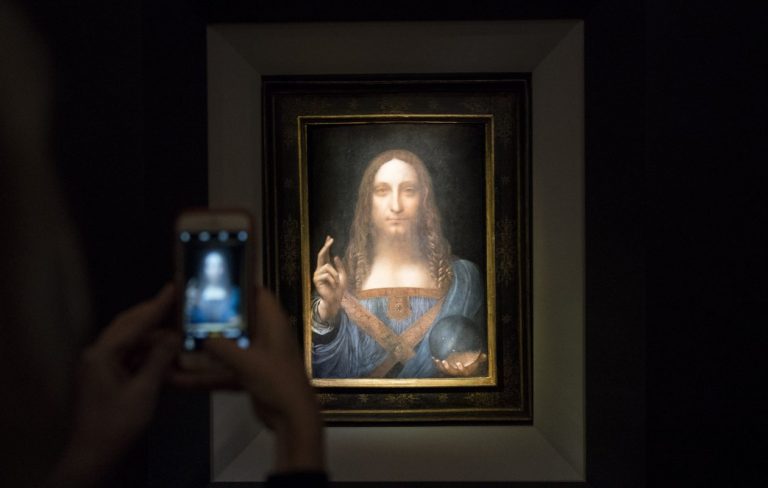


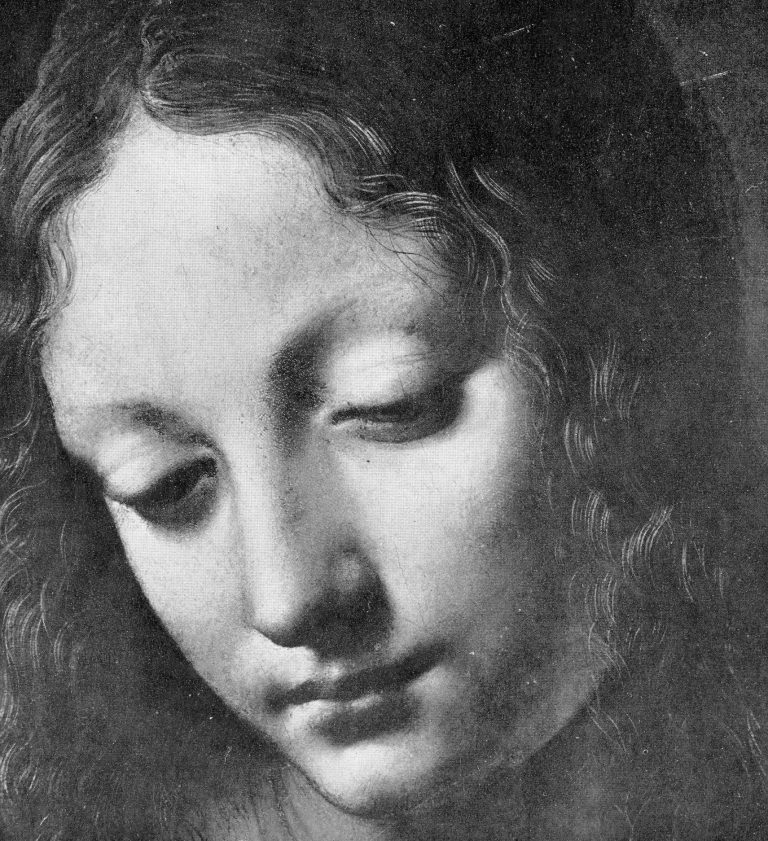
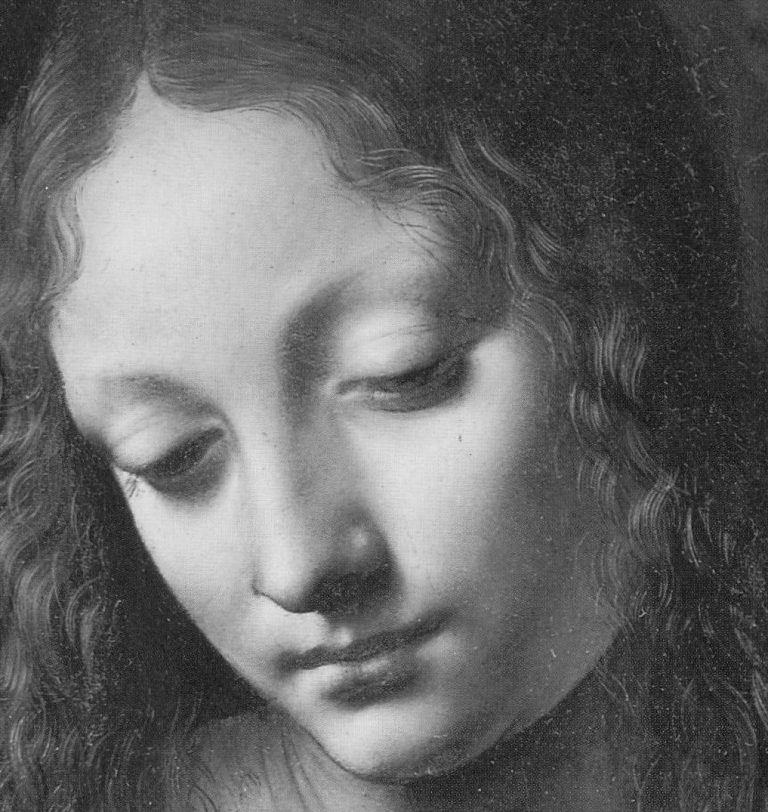






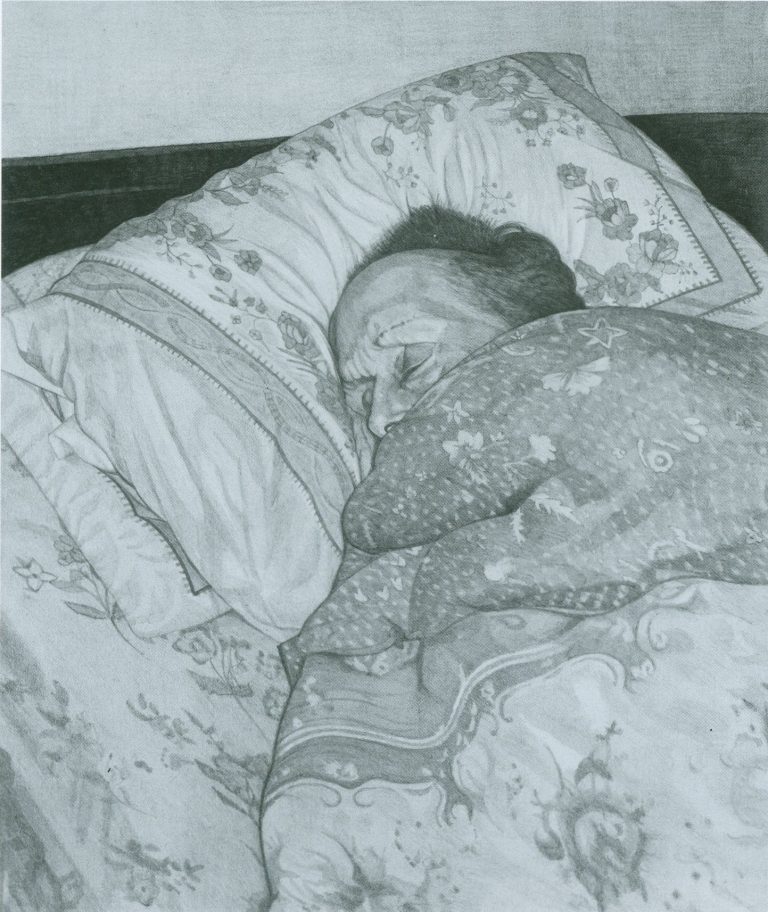


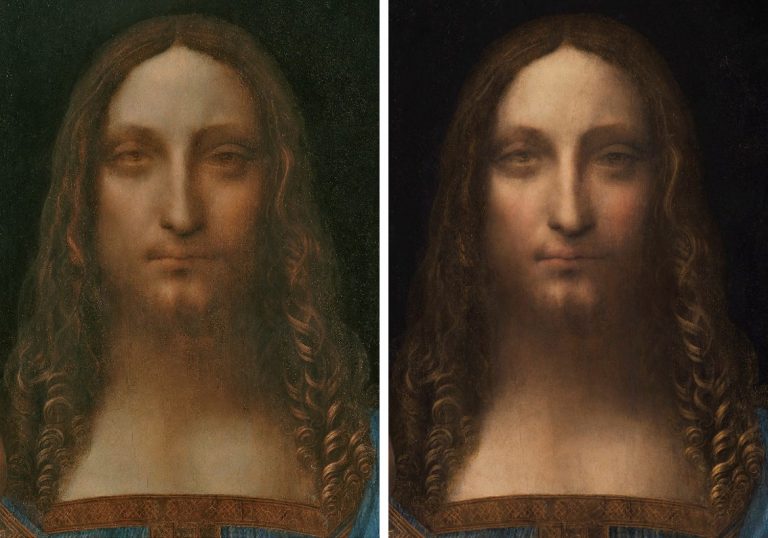

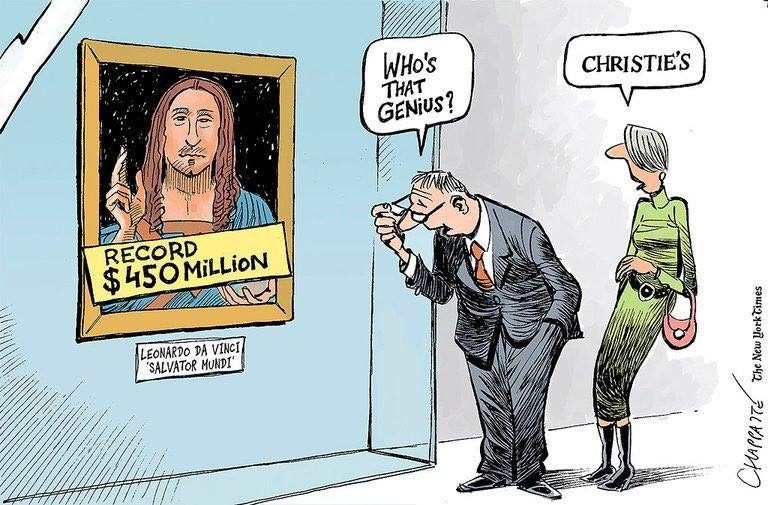
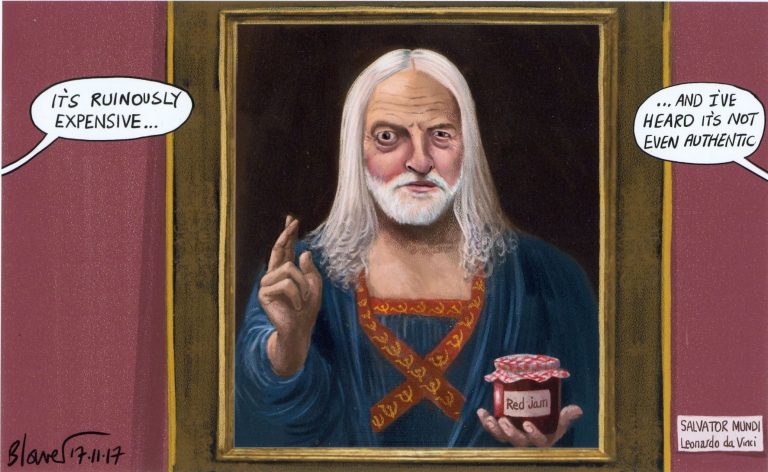





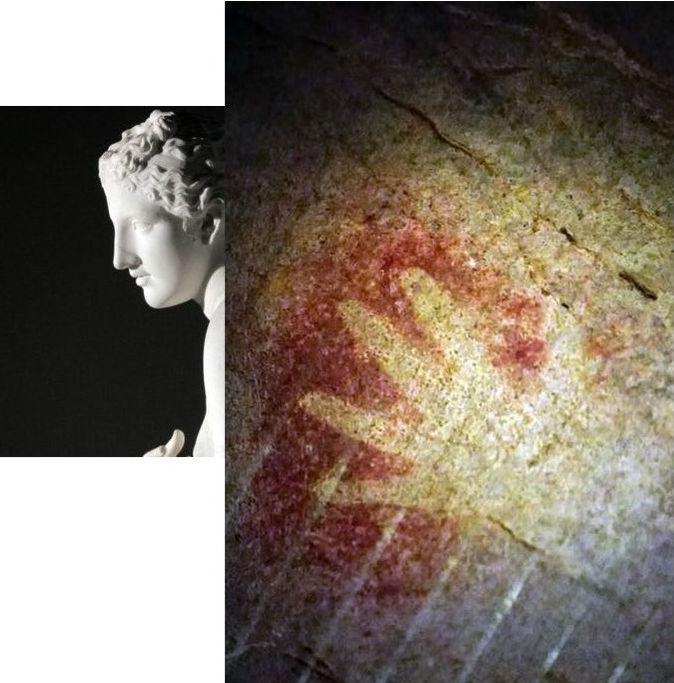
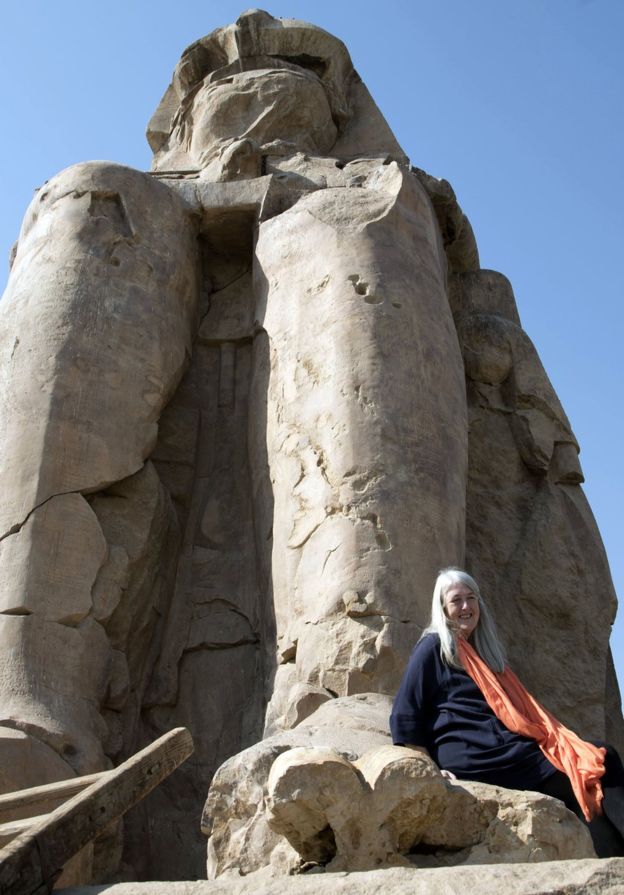


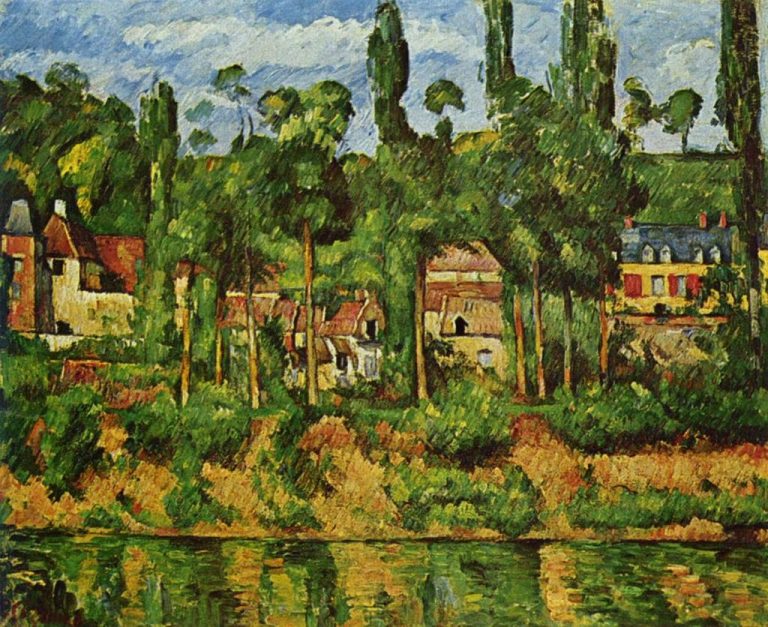
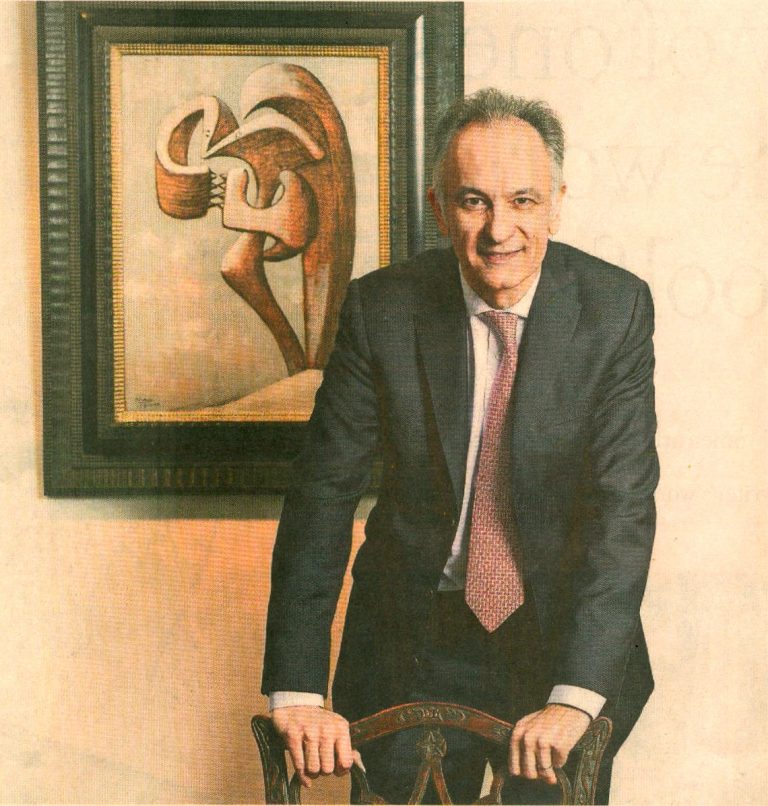
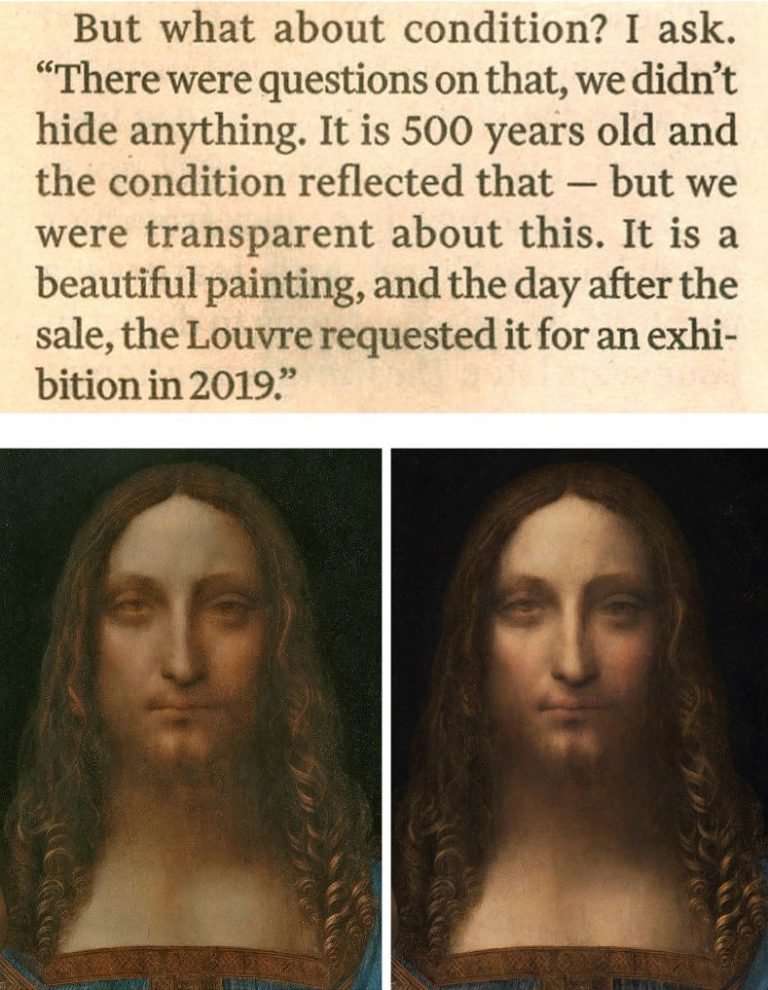

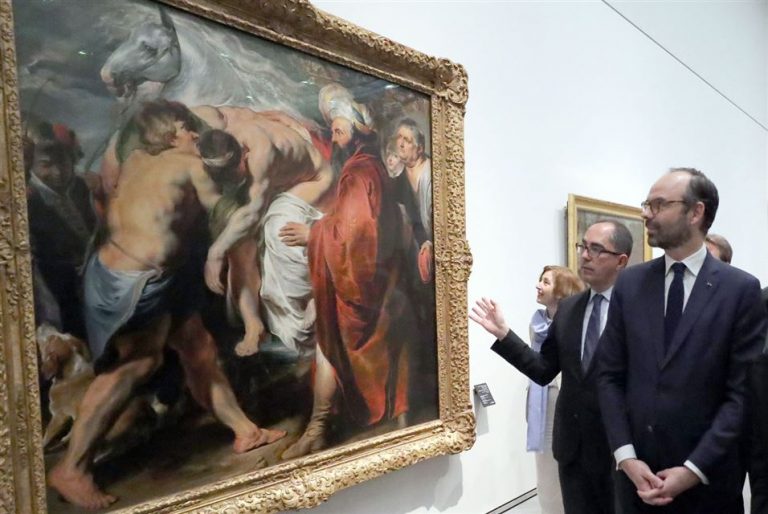




![06 [6] three shoulders (3)](http://artwatch.org.uk/wp-content/uploads/2018/02/06-6-three-shoulders-3-768x388.jpg)
![05 [5] three shoulders (2)](http://artwatch.org.uk/wp-content/uploads/2018/02/05-5-three-shoulders-2-768x322.jpg)
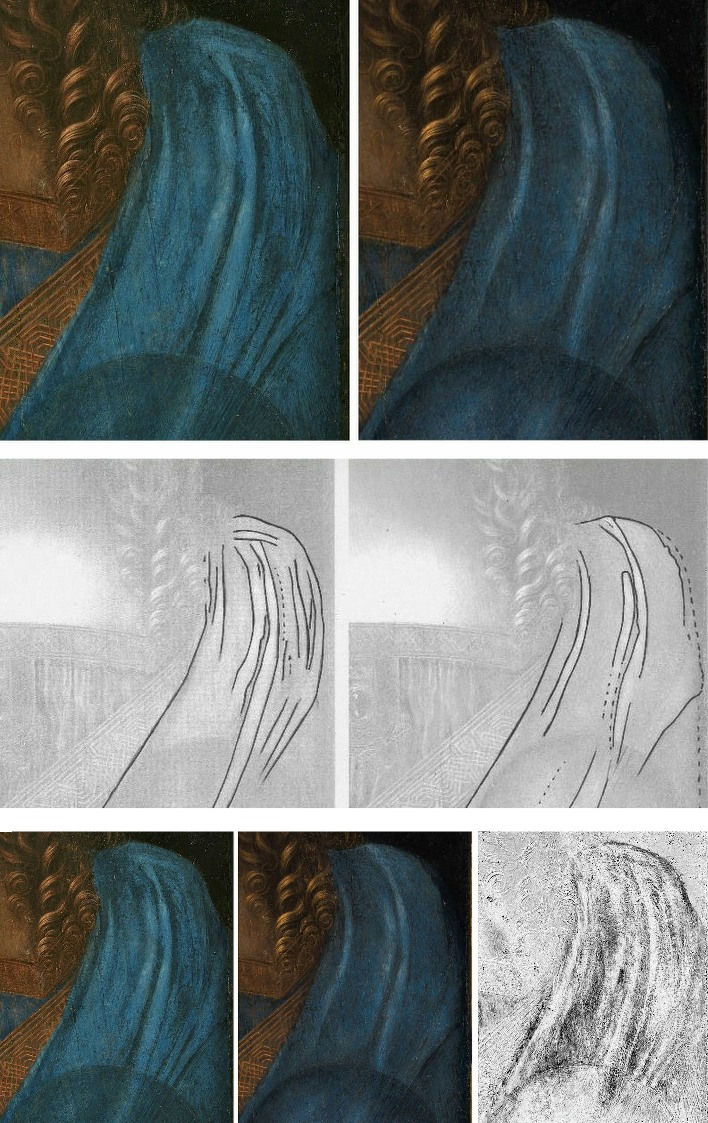

![08 [7] first london outing](http://artwatch.org.uk/wp-content/uploads/2018/02/08-7-first-london-outing-768x1086.jpg)

![010 [8] nose jobs](http://artwatch.org.uk/wp-content/uploads/2018/02/010-8-nose-jobs-768x571.jpg)
![11 [9] zzNew Fig. 2](http://artwatch.org.uk/wp-content/uploads/2018/02/11-9-zzNew-Fig.-2-768x1086.jpg)
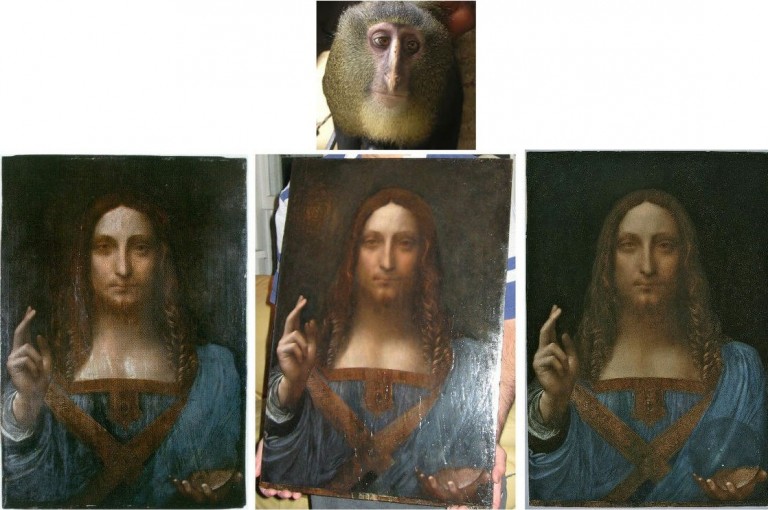
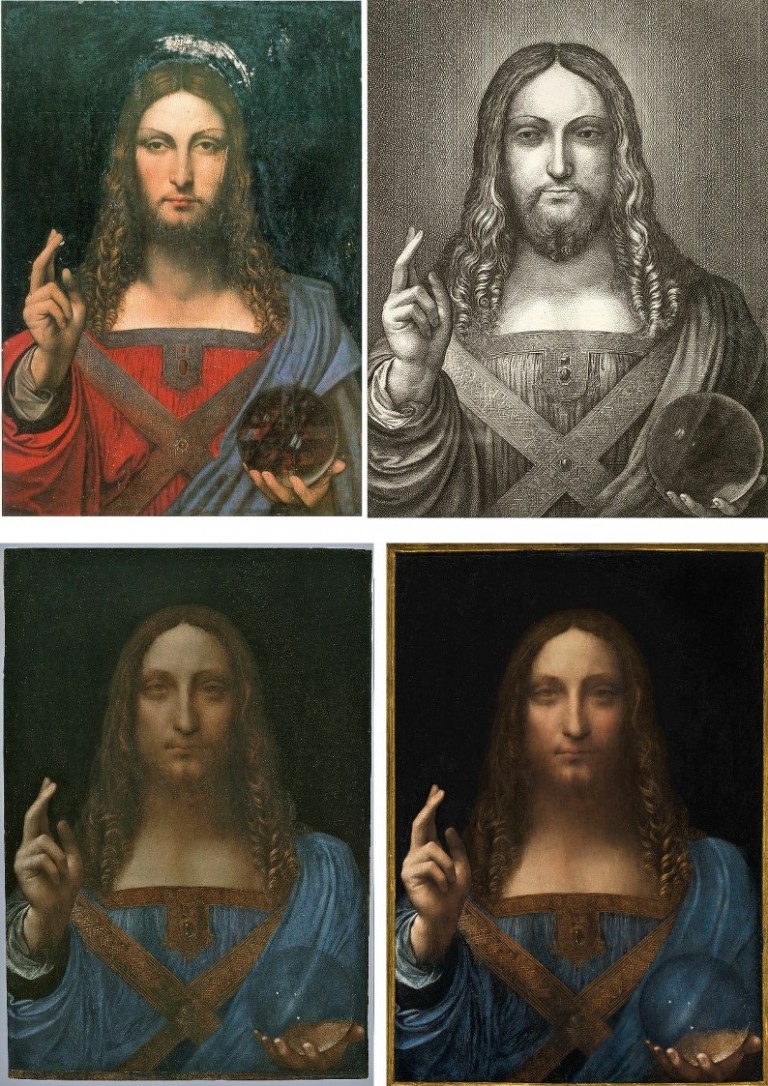



![017 [10] split](http://artwatch.org.uk/wp-content/uploads/2018/02/017-10-split-700x1024.jpg)

